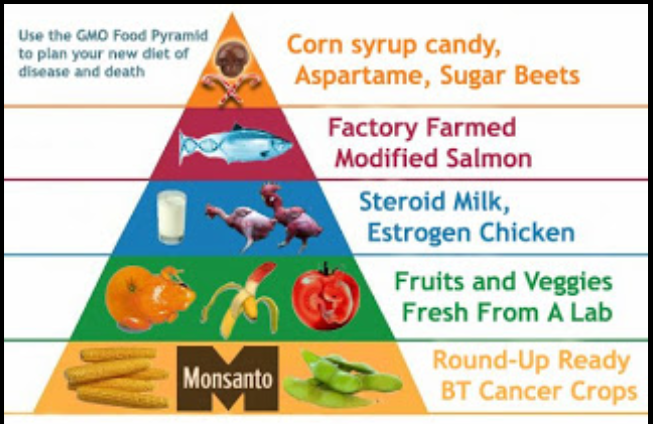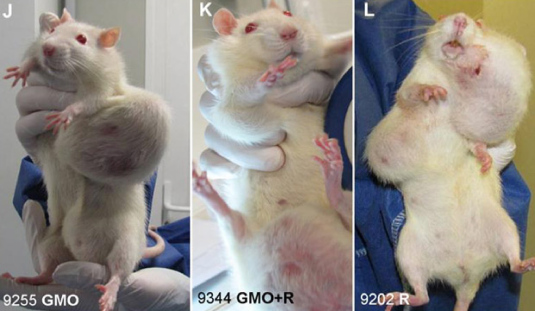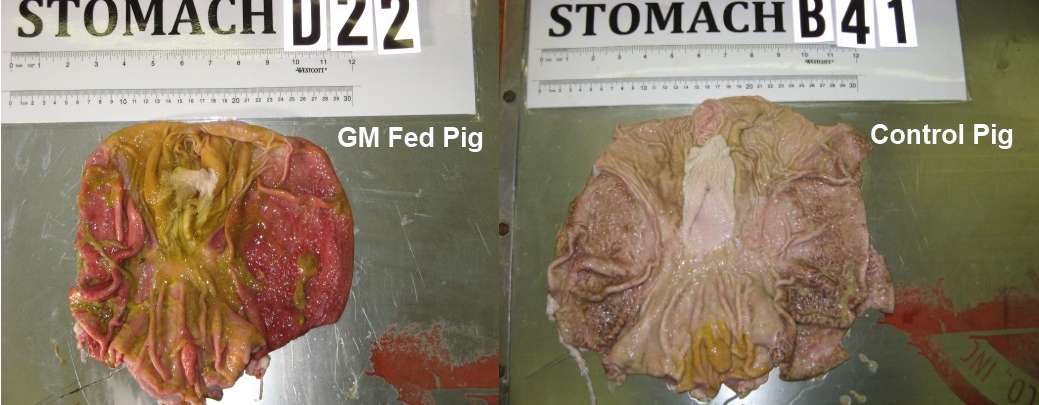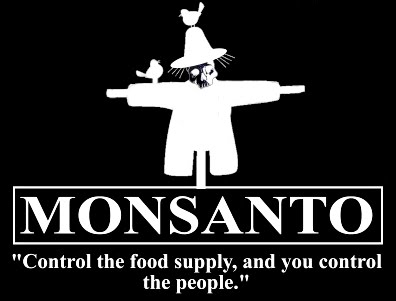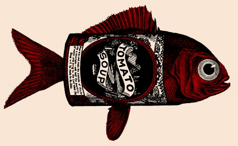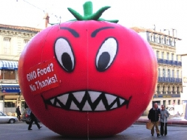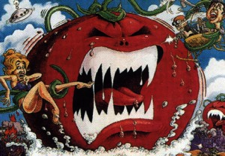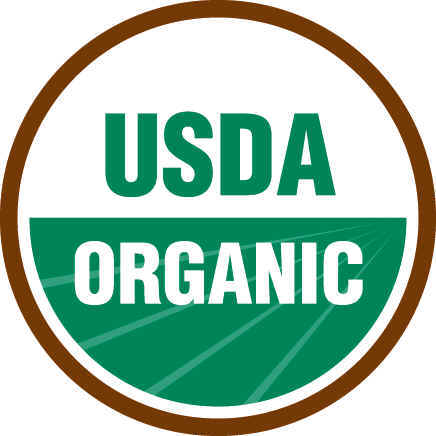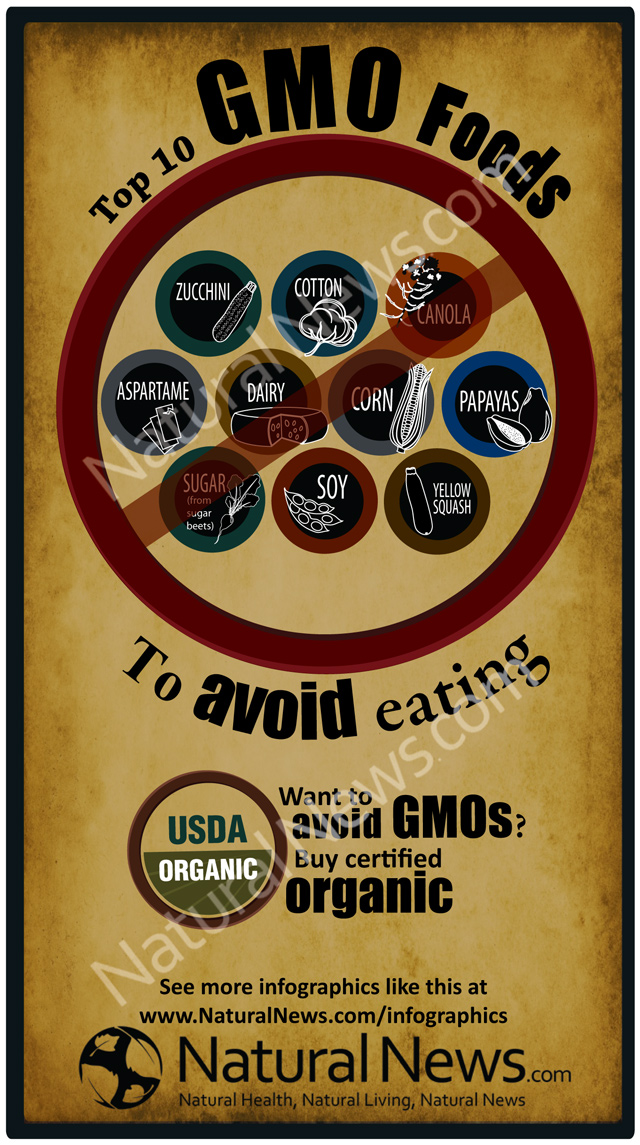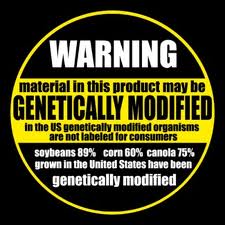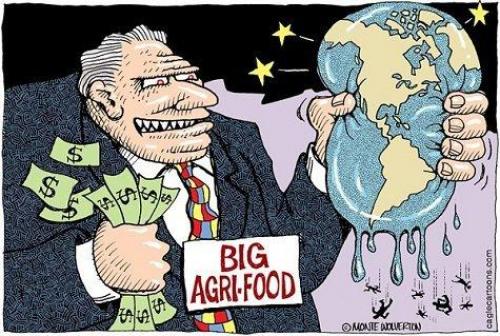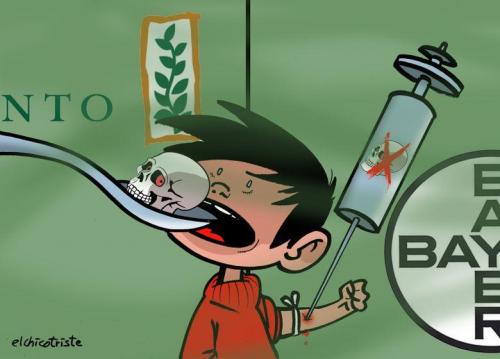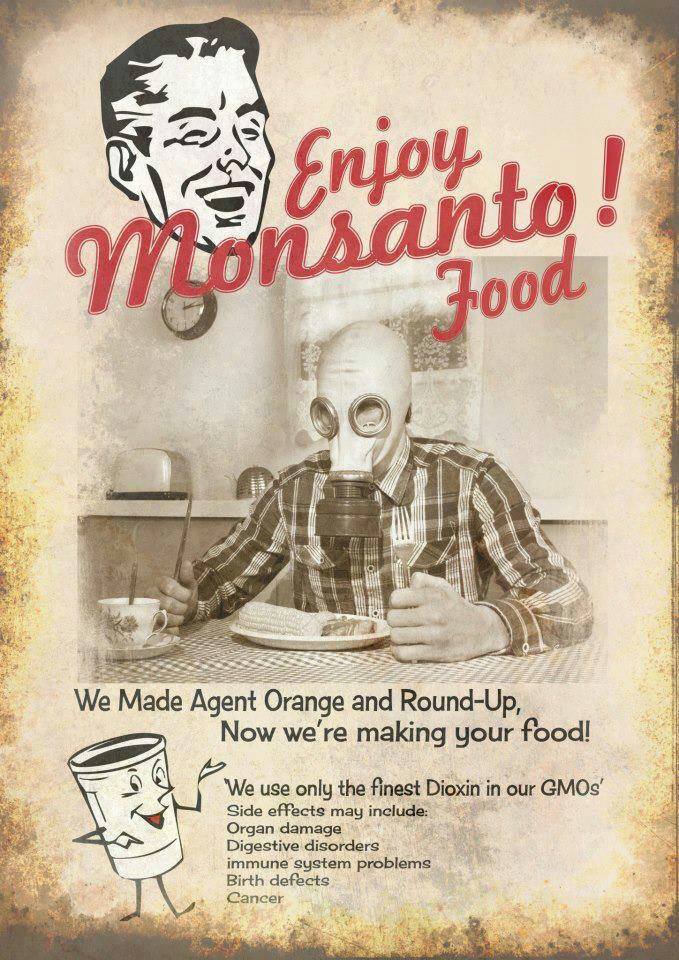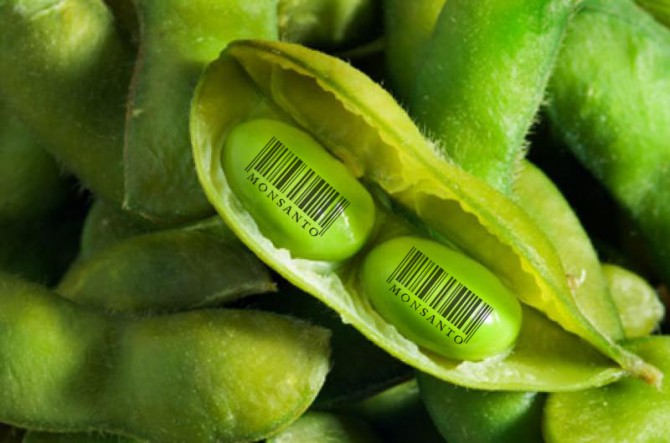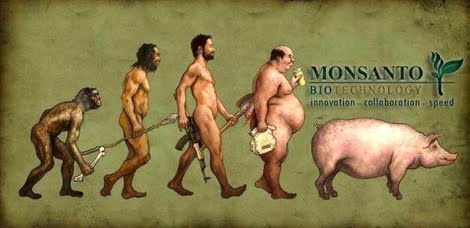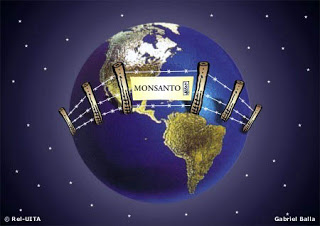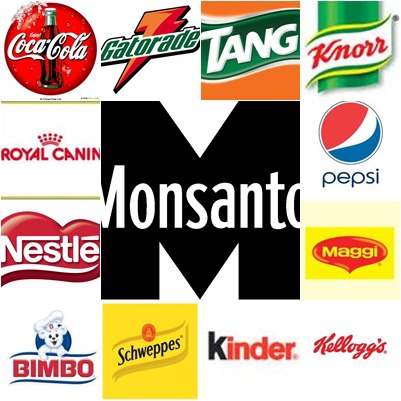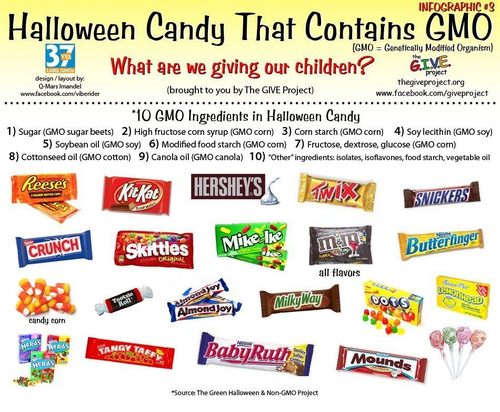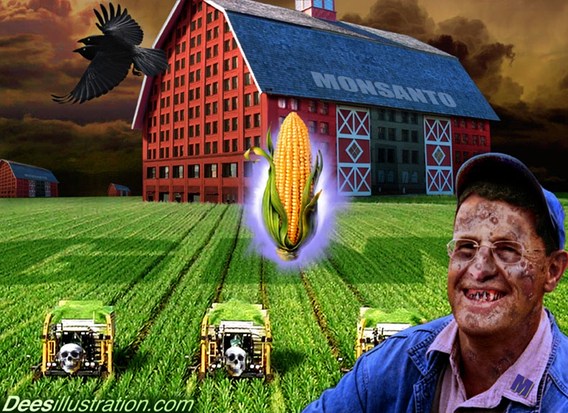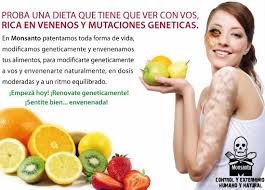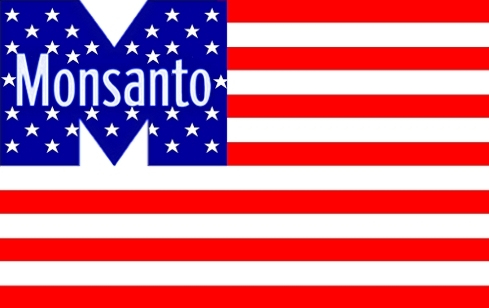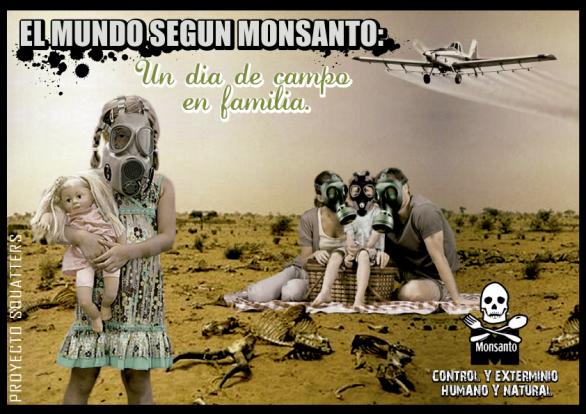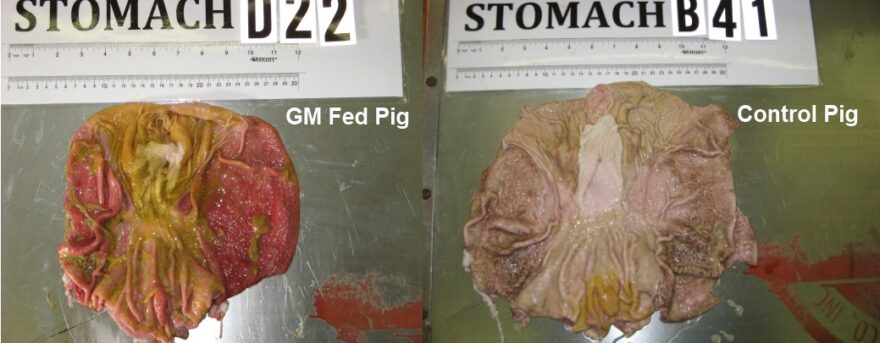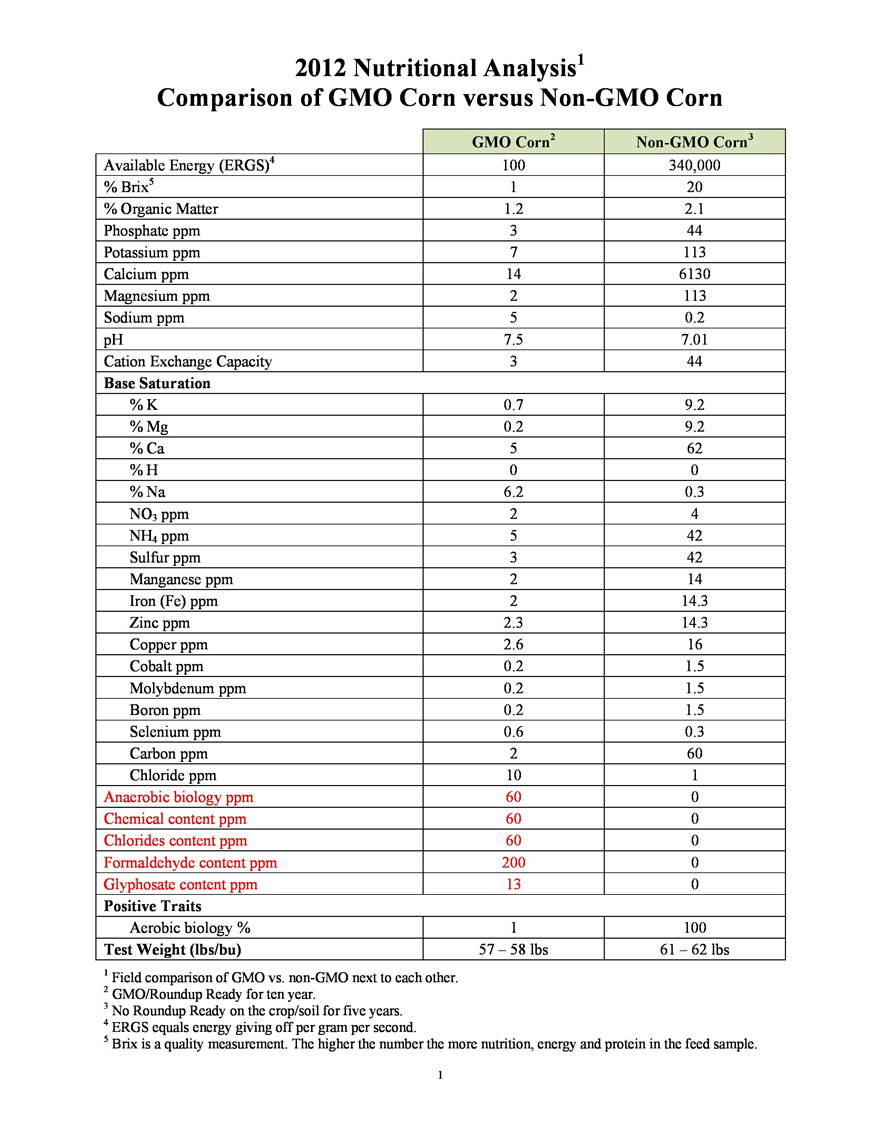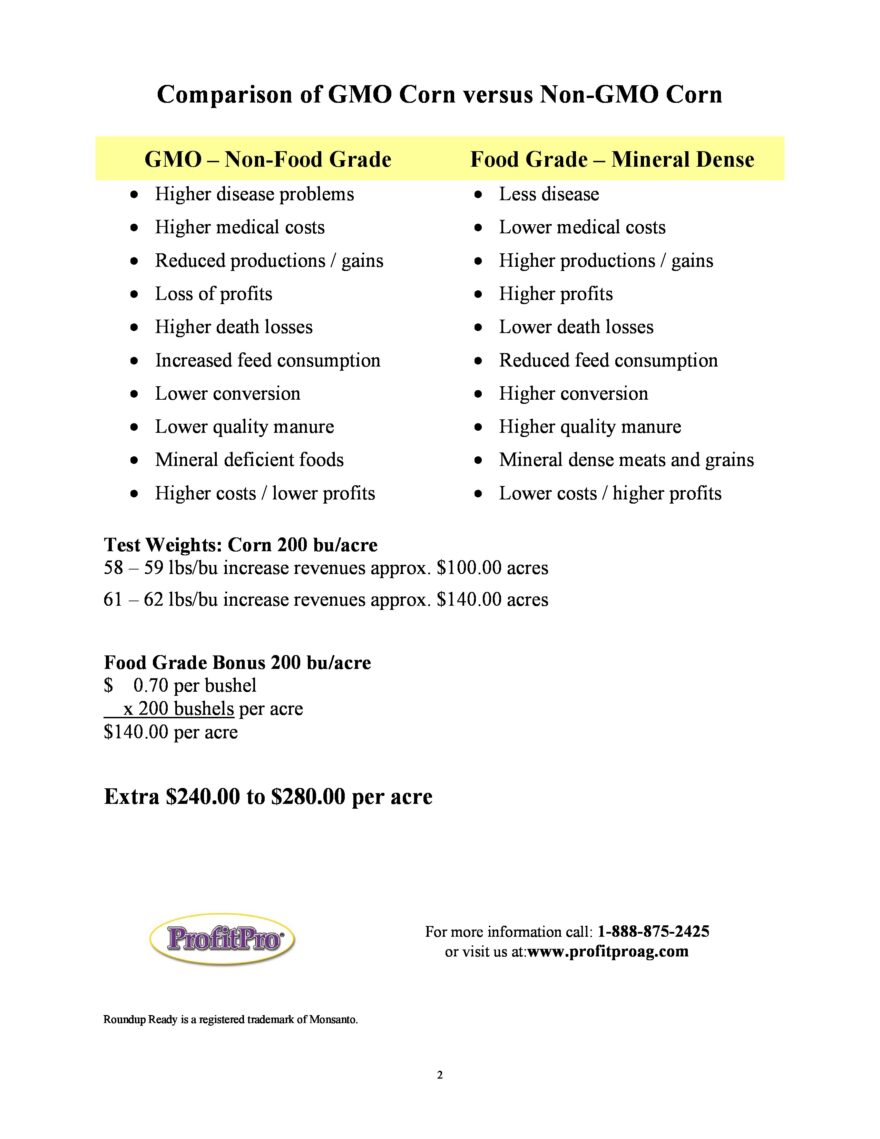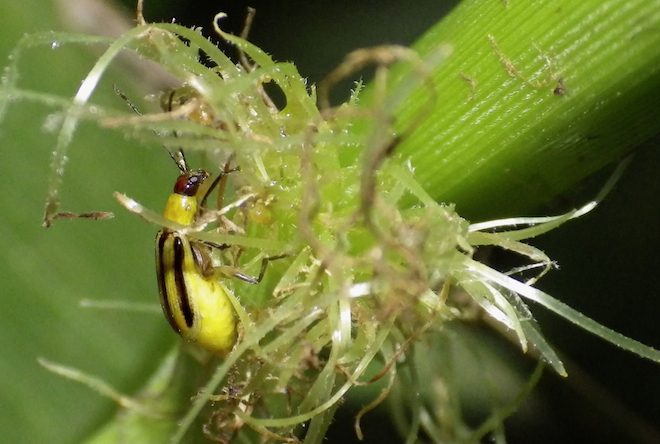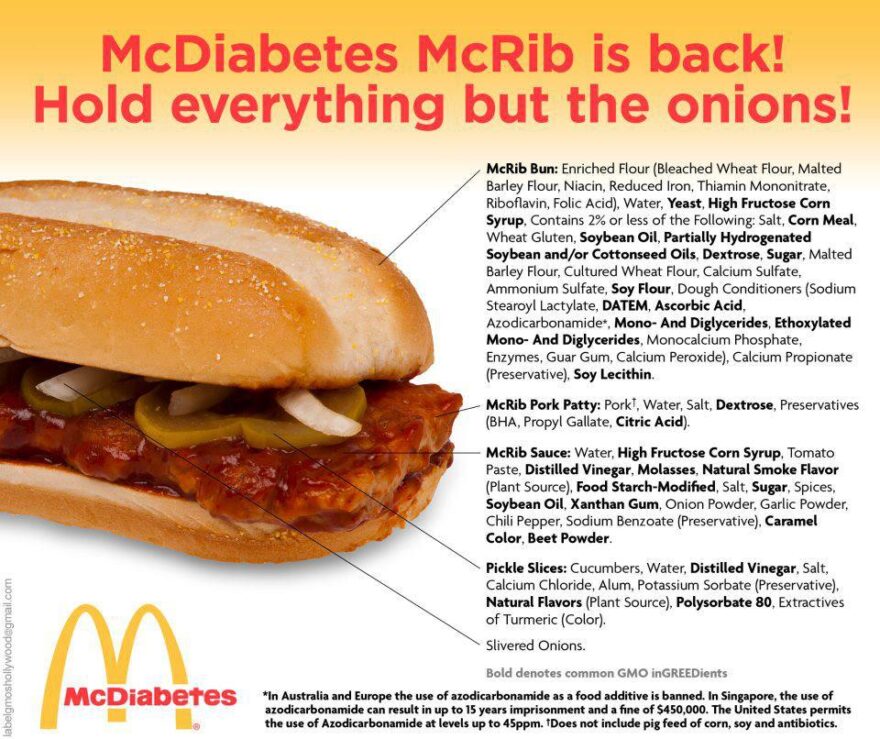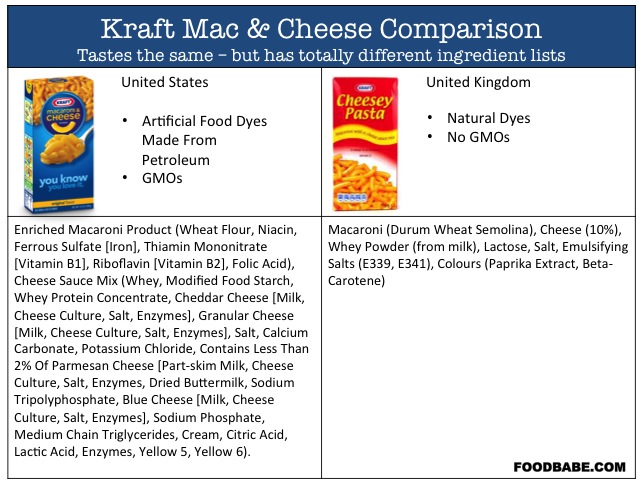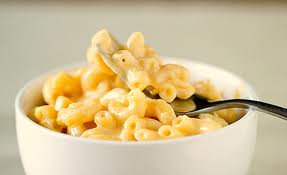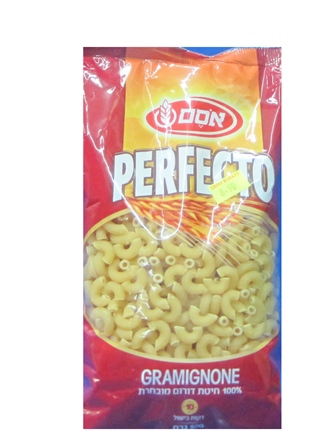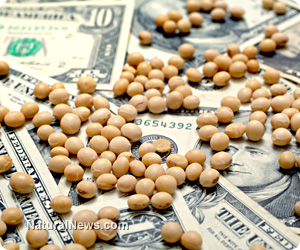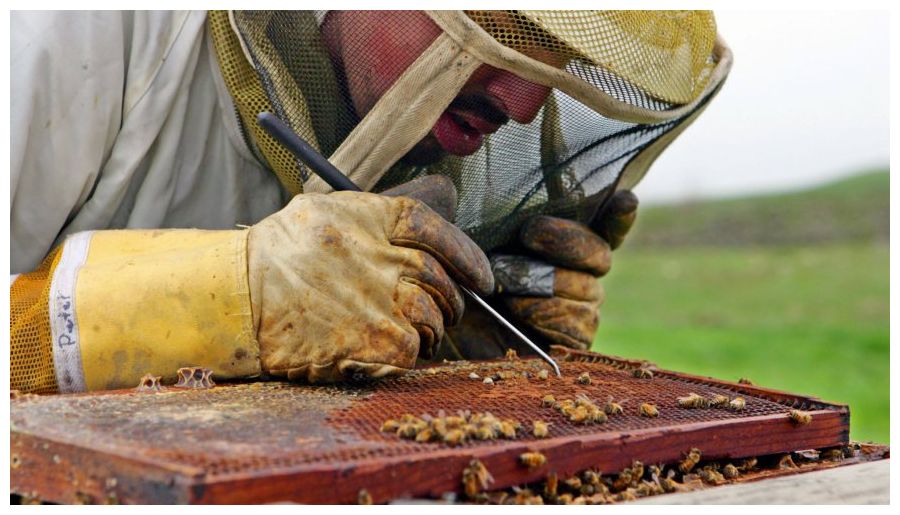GMO – Genetically Modified Food effects, reports and news. |
|
|
|
|
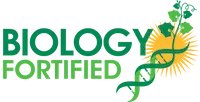
A look at GMO policies in different nationsby Layla Katiraee July2015 https://www.biofortified.org/2015/07/a-look-at-gmo-policies-in-different-nations/ Israel:Israel is one of the most interesting places I’ve visited. However, its summers are very hot and it can be quite dusty. Despite the challenges inherent in its desert-like climate, the local fruits and veggies are spectacular. There are no GMOs commercialized in Israel even though the country is a hotbed for genetic engineering research, which comes as no surprise considering the interest that the nation has in drought-resistant crops. The absence of commercialized GMOs is due to the fact that a very large portion of Israel’s agricultural exports head to the EU, where they are slower and more cautious to approve transgenic crops for import (learn more on EU’s stance on GMOs here). As such, growing GMOs might have financial repercussions if the EU were to decide to be more wary of Israeli produce.
|
||||||||||||||||||||||||||||||||||||||||||||||||||||||||||||||||||||||||||||||||||||||||||||||||||||||||||||||||||||||||||||||||||||||||||||||
Restrictions on Genetically Modified Organisms: Israelhttps://www.loc.gov/law/help/restrictions-on-gmos/israel.php#Structure Back to Restrictions on Genetically Modified Organisms
I. IntroductionIsrael is considered “an international center for studying genetically modified organisms.”[1] Research involving genetically modified organisms (GMOs) concentrates on the development of seeds and is conducted in Israeli universities, in government research institutions,[2] and by the private sector.[3] Funding for GMO research and testing in Israel derives from Israeli and foreign sources, including the United States.[4]
Israeli subsidiary legislation defines a GMO as “[a]n organism, including a microorganism, virus, viroid, and any single-celled or multi-celled entity, that has undergone a modification by genetic engineering and is involved with plants in any way during its life cycle.”[5] A commentator has noted that while GMO research in Israel has focused on “developing and improving plants’ resistance to pests, diseases, and herbicides[,] . . . the research can only reach the ‘proof of concept’ stage, because of regulations.”[6]
Accordingly, although the growth of GMOs is generally permitted in Israel for research purposes, subject to conditions enumerated by law, it is not authorized for commercial purposes.[7] Ingredients derived from GMOs may, however, be imported, sold, and used in the production of food in Israel.[8] GMO products are also “widely used in the pharmaceutical industry”[9] in Israel. There are currently no requirements for the labeling of GMOs in Israel.[10] II. Public and Scholarly OpinionA. Government Policies In a December 2011 hearing of the 18th Knesset (Israel’s Parliament) Science and Technology Committee, experts testified in favor of research and development (R&D) involving genetic engineering in agriculture. Projecting a rise in global population and food shortages, Professor Yoram Kapolnik, head of agricultural research at the Ministry of Agriculture and Rural Development (MARD), testified on the need for Israel to prepare for 2050, by which time he expects central food components to be depleted.[11] Professor Amnon Lars, a researcher at the Agriculture Research Organization’s Volcani Center,[12] also testified that genetic engineering proposed alternatives to the use of pesticides by developing vegetables that would be resistant to various viruses.[13]
The hearing concluded with a call by Ronit Tirosh, the Committee’s Chair, to remove “the stigmas regarding the low level of safety [associated with] genetically engineered products; because it was proved that they are unjustified.”[14] Calling on MARD to allocate funding “for marketing and for educating the public” on this issue, Ms. Tirosh stressed the need for closer cooperation between the Ministry of Health and MARD’s research institutions. Such cooperation is necessary, she stated, “so that regulations and directives that are issued by the Ministry of Health will be considered in connection with every research project that is conducted, when the goal at the completion of the research is to open the products for wide distribution and trade.”[15] Ms. Tirosh called for the introduction of a bill that would regulate the labeling of genetically engineered products and increase the number of inspectors to ensure compliance with quality standards.[16]
A search for legislative developments since the December 2011 hearing has disclosed an amendment delaying the enforcement date of the Public Health (Food) (Nutritional Labeling) (Amendment) 5771-2011 Regulations to January 31, 2014. The text of these regulations, however, does not include reference to the labeling of GMO products.[17] The absence of labeling requirements for GMO food components was criticized at a hearing conducted by the Knesset Committee for Labor, Welfare and Health on July 3, 2013.[18] B. Public Environmental Concerns Environmental activists have expressed concerns regarding the quality and the potential harm that they believe would result from the use of GMOs. Activists argue that “GM seeds produce sterile crops, so cross-pollination with wild plants could bring rapid extinction to those wild varieties. . . . GM plants are very weak and ‘spoiled’.”[19] They have also expressed concerns about the long-term ecological effects of GMOs breeding with other plants.[20]
Israeli scientists, however, have generally support the development of GMOs.[21] According to Professor Gad Galili of the Weizmann Institute of Science in Rehovot, the development of genetically engineered crops can address “the global shortage of staple foods.” In response to concerns regarding the long-term impact of GMO use he opined that
C. Religious Concerns Concerns have been raised both in Israel and among Jewish communities around the world[23] regarding whether products that include GMO components are Kosher and thus fulfill strict Jewish dietary standards. The Epoch Times has reported that
In the United States, the Natural Food Certifiers (NFC) Organization, announced that its Apple K Kosher Certification Program would no longer accept applications for products that contain GMOs.[25]
According to a press release issued by the NFC:
III. Structure of Pertinent LegislationIsraeli law currently does not include any primary legislation on GMOs. Responsibilities for GMO research, development, and use are shared by MARD and the Ministry of Health in accordance with regulations established by these ministries based on their respective authorities. A. Regulation of GMO Research The Seed Regulations (Genetically Modified Plants and Organisms) 5765– 2005[27] were issued in 2005 by the Minister of Agriculture and Rural Development based on general authorities provided under the Seeds Law, 5716-1956,[28] and the Plant Protection Law, 5716-1956.[29]
MARD oversees all experimentation with transgenic plants and organisms that are involved in the life cycle of plants in accordance with the regulations. In addition, MARD handles the importation and exportation, handling and commercialization of genetically modified propagation material.[30] MARD’s activities in these areas are managed by the following bodies: 1. The Plant Protection and Inspection Service (PPIS); 2. The National Committee for Transgenic Plants (NCTP); and 3. The Authorized Institutional Representative.[31] B. Regulation of GMO Use in Food According to information posted on the Ministry of Health website,
Legislation specifically regulating labeling of GMO components in food does not appear to have been passed to date. IV. Restrictions on Research, Production, and MarketingA. Rules for Authorizing Research and for Research Laboratories The Seed Regulations prohibit any experimentation with plants that have undergone a change by means of genetic modification without a permit issued by the Director of the PPIS.[33] The regulations authorize the Director to grant experiment permits and to stipulate conditions and restrictions for their issue; including conditions for destroying plant material, organisms or regulated articles used during the experiment and requiring that testing be conducted in laboratories that have been approved by the Director. The Director may refuse to issue a permit for experiments that are to be carried out in a
The regulations authorize the Director to exempt applicants from needing to obtain an experiment permit if he or she is satisfied that the experiment will be conducted in a laboratory equipped with an autoclave facility and its operator and safety officer have ensured that “all experiment residues are destroyed in an incinerator or sterilized with material that the Director has approved.”[35] B. Marketing Rules The sale of transgenic plants requires permission from the Director in consultation with the NCTP and compliance with all the conditions enumerated in the experiment permit.[36] The sale or export of transgenic propagation material or organism similarly requires a valid registration certificate or an approved label.[37]
The regulations require an applicant who requests authorization to sell transgenic propagation material or transgenic organisms to submit a registration application that includes the following information:
The Director is authorized to reject, restrict, or cancel a registration of transgenic propagation material or organisms for sale based on evidence that the plant material or organism may endanger plants, humans, or animals or have unacceptable negative impacts on the environment, or based on noncompliance with labeling requirements that have been authorized by the Director or deviation from the trait description that has been supplied at the time of registration application.[39] C. Labeling Requirements for Distributed Products As discussed above, labeling requirements apply to the marketing of transgenic plants, propagation material, and organisms. Labeling requirements for distribution of processed food products containing GMO components do not apply at this time.
D. Agencies Involved in Implementation According to the regulations, the role of the NCTP is to advise the Director, in accordance with the instructions prescribed by the regulations, and “to determine if genetically modified plants or organisms or their sale, pose any risk to humans or animals or have unacceptable negative impacts on the environment.”[40]
The thirteen committee members are appointed by the Minister of Agriculture and Rural Development and include the following persons:
V. Restrictions on Releasing Organisms into the EnvironmentAs explained above, GMOs may be produced in Israel only for research purposes subject to conditions enumerated by the relevant regulations. GMO growth is not authorized for commercial purposes.[42] VI. Restrictions on GMOs in FoodstuffGMO products may be imported, sold, and used in the production of food in Israel,[43] and are not required to be labeled in a way that identifies their GMO components.[44] VII. Liability RegimeIsraeli law does not contain a special liability regime in relation to the development, use, or release of GMOs. VIII. Judicial Decisions / Prominent CasesA search for case law concerning GMO research and use unconnected to patent rights has not identified any relevant court decisions. Ruth Levush [1] Marlene-Aviva Grunpeter, GMOs, A Global Debate: Israel a Center for Study, Kosher Concerns,Epoch Times (Aug. 5, 2013), http://www.theepochtimes.com/n3/229556-gmos-a-global-debate-israel-a-center-for-study-kosher-concerns/. [2] See Agricultural Research Organization (ARO), Volcani Center: Plant Pathology and Weed Research, Ministry of Agriculture and Rural Development (MARD), http://www.agri.gov.il/en/departments/12.aspx (last visited Sept. 12, 2013).[3] See, e.g., Hagai Amit, Homegrown Israeli Idea for Conquering the World Food Shortage, Haaretz (Apr. 12, 2012), http://www.haaretz.com/weekend/week-s-end/homegrown-israeli-idea-for-conquering-the-world-food-shortage-1.423959. [4] Id. (stating, for example, that the US government was helping to fund pre-field trial tests conducted by an Israeli startup company). For general information on life sciences research in Israel, see Tova Cohen & Steven Scheer, Analysis: After Tech Success, Israel Seeks Life Sciences Growth, Reuters (June 6, 2013), http://www.reuters.com/ article/2013/06/06/us-israel-biomed-idUSBRE9550IU20130606. [5] Seed Regulations (Genetically Modified Plants and Organisms) 5765-2005, Kovetz Hatakanot [KT] [Subsidiary Legislation] No. 6391 p. 782. An unofficial translation of the regulations is available on the MARD website at http://www.ppiseng.moag.gov.il/PPISENG/GeneticallyModifiedPlants/LicensingandanalysisofGMplants/ [8] Genetically Engineered Food, Ministry of Health, http://www.health.gov.il/unitsoffice/hd/ph/fcs/novelfood/ pages/engfood.aspx (last visited Sept. 12, 2012). [11] The Knesset Committee for Science and Technology, The 18th Knesset, Use of Genetic Engineering in Agricultural Research in Israel (Hearing in the Committee, Protocol No. 112: Summary of the Committee’s Activity, Part B, p. 50 (Aug. 2011–Nov. 2012), http://www.knesset.gov.il/committees/heb/docs/ mada_18b.pdf (in Hebrew). [12] For information on the Center’s research activities, see Agriculture Research Organization (ARO) Volcani Center, MARD, http://www.agri.gov.il/units/institutes/default.aspx (last visited Sept. 16, 2013). [13] The Knesset Committee for Science and Technology, supra note 11, at 51. [17] Public Health (Food) (Nutritional Labeling) (Amendment) 5771-2011 Regulations, KT No. 7019, p. 1198 (July 31, 2011), as amended by KT No. 7160, p. 1661 (Aug. 30, 2012). [18] See The 19th Knesset Committee for Labor, Welfare and Health Meeting (Protocol No. 47, July 3, 2013) pp. 18–21, http://www.knesset.gov.il/protocols/data/rtf/avoda/2013-07-03.rtf (in Hebrew). [19] Grunpeter, supra note1. [20] Gal Tziperman Lotan, Scientists, Activists Debate if Genetically Modified Foods are Panacea or Plague, The Jerusalem Post (Apr. 30, 2008), http://www.jpost.com/Health-and-Sci-Tech/Science-And-Environment/Scientists-activists-debate-if-genetically-modified-foods-are-panacea-or-plague. [23] See Natural Food Certifiers, GreenerChoices, http://www.greenerchoices.org/eco-labels/label.cfm? LabelID=198 (last visited Sept. 16, 2013). [24] Grunpeter, supra note 1. [25] The NFC has been certifying products as organic since 2002 and is accredited as an organic certifier by the USDA. See GreenerChoices, supra note 23. [26] Daisy Luther, Kosher Certification Program Bans All GMO Ingredients, The Organic Prepper (Apr. 25, 2013), http://www.theorganicprepper.ca/kosher-certification-program-bans-all-gmo-ingredients-04252013. [27] Seed Regulations (Genetically Modified Plants and Organisms) 5765–2005, KT No. 6391, p. 728. [28] Seeds Law, 5716-1956, 10 Laws of the State of Israel [LSI] 99 (5716-1955/56), as amended. [29] Plant Protection Law, 5716-1956, 10 LSI 75, as amended. [30] Genetically Modified Plants & Organisms, MARD Plant Protection and Inspection Services, http://www.ppiseng.moag.gov.il/PPISENG/GeneticallyModifiedPlants/LicensingandanalysisofGMplants/ (click on “[l]earn more about the service . . . ”; last visited Nov. 1, 2013). [31] Id. [32] Genetically Engineered Food, Ministry of Health, http://www.health.gov.il/unitsoffice/hd/ph/fcs/ novelfood/pages/engfood.aspx (last visited Sept. 18, 2012) (translated by author, R.L.). [33] Seed Regulations (Genetically Modified Plants and Organisms) 5765-2005, § 3. [34] The National Committee for Transgenic Plants is a committee appointed by the Minister of Agriculture and Rural Development for matters concerning experiments with transgenic plants and organisms and their sale. See id. § 2(a). |
||||||||||||||||||||||||||||||||||||||||||||||||||||||||||||||||||||||||||||||||||||||||||||||||||||||||||||||||||||||||||||||||||||||||||||||
Grocery Store Wars (2005) |
||||||||||||||||||||||||||||||||||||||||||||||||||||||||||||||||||||||||||||||||||||||||||||||||||||||||||||||||||||||||||||||||||||||||||||||

The Cornucopia Institute releases shopper’s guide red-flagging pro/con food brands involved with Colorado and Oregon Initiatives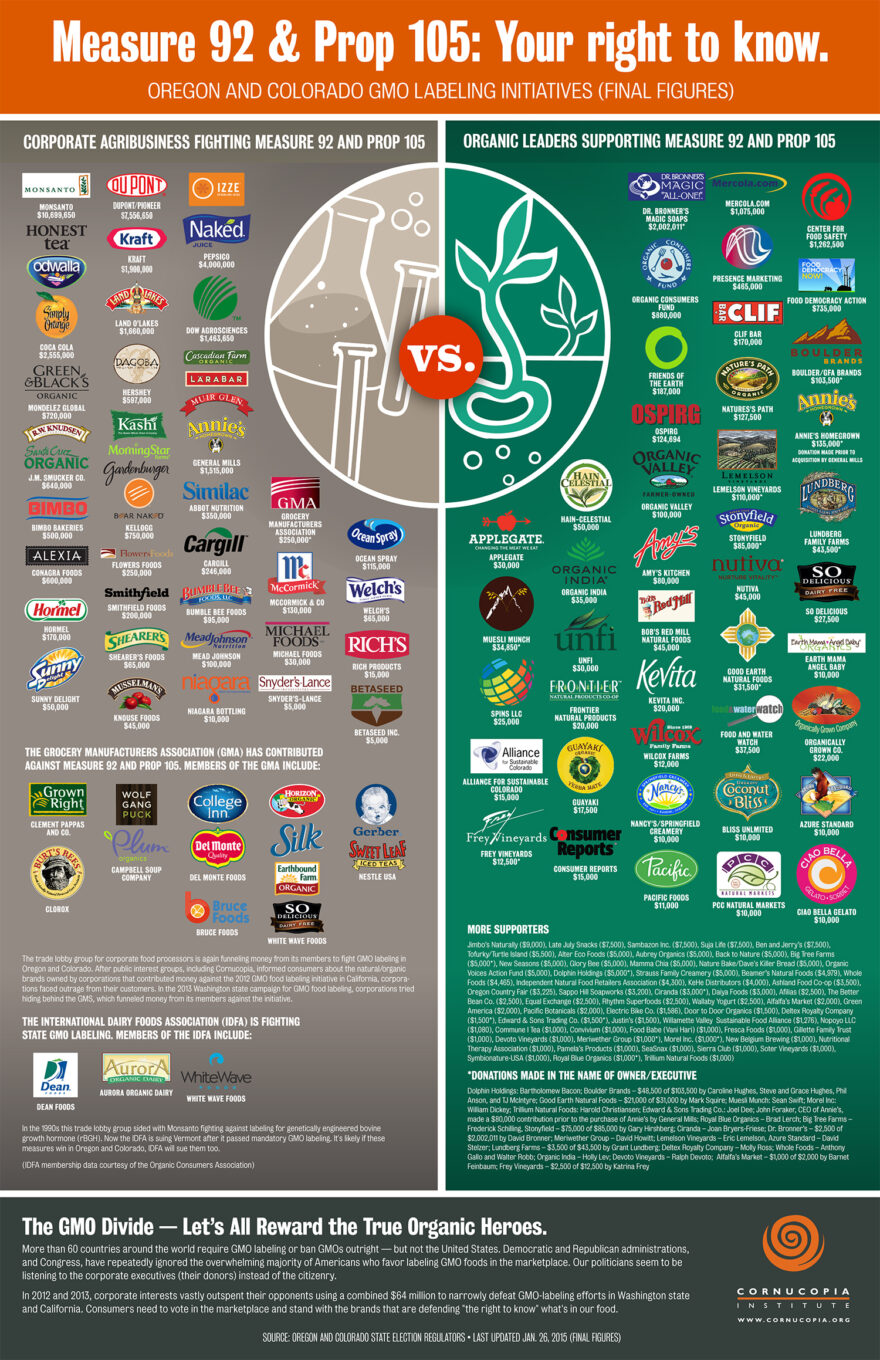 The Cornucopia Institute releases shopper’s guide red-flagging pro/con food brands involved with Colorado and Oregon Initiatives 2014 Last updated February 22, 2016 https://www.cornucopia.org/newsletter/biotech-agribusinesses-spending-heavily-defeat-state-gmo-food-labeling-votes/?utm_source=enews&utm_medium=email&utm_term=2-28-15&utm_campaign=GMOInfographic FOR IMMEDIATE RELEASE Biotech and Agribusinesses Spending Heavily to Defeat State GMO Food Labeling Votes The Cornucopia Institute releases red-flagging pro/con food brands Cornucopia, WI: Citizen initiatives on the November 4 ballots in both Colorado and Oregon would mandate clear labeling of genetically engineered (GE) ingredients on food packages. The pending votes have sparked a high-priced battleground pitting consumer and farmer advocates against multi-billion-dollar agribusiness corporations.
Opposition to the state food labeling measures is coming from giant biotech companies (DuPont, Dow and Monsanto), that sell genetically engineered crops, and the well-heeled Grocery Manufacturers Association (GMA), a national business lobbying organization. Millions of dollars are being spent on the two campaigns with advertising blitzes underway.
Now The Cornucopia Institute has released a detailed infographic that reveals which food companies are supporting or opposing the food labeling initiatives (with many of the major manufacturers opposing passage owning leading brands in the natural/organic marketplace).
“Many consumers will likely be surprised to learn that owners and management of some of their favorite organic and natural brands are fighting against the right of consumers to know what is in their food,” says Mark Kastel, Codirector of The Cornucopia Institute, a farm policy research group. “We want to spotlight this issue so that consumers can vote in the marketplace for manufacturers and brands that reflect their personal values.”
Mandatory labeling of genetically engineered food ingredients (commonly called GMOs — standing for genetically modified organisms) at the state level is viewed as a watershed event by many industry observers, given the prolonged inaction at the federal level. Earlier this year Vermont passed a state law requiring GMO food ingredient labeling, and the states of Connecticut and Maine has adopted similar legislation that will take effect when other neighboring states pass such laws.
Last year a state GMO food labeling initiative was narrowly defeated in Washington by a 51-49 percent margin. In California in 2012, a GMO food labeling initiative lost by a similarly slim margin. Biotech interests spent close to $50 million opposing the initiatives in California and Washington. And the GMA and the International Dairy Foods Association (IDFA), another trade-lobby group, are now suing Vermont over its legislatively adopted food labeling law.
At the national level, Monsanto, its biotech allies, and the GMA in particular, have been credited for bottlenecking action on a federal law although they have recently rallied behind a new proposal that would outlaw state GMO food labeling laws while permitting “voluntary” labeling by companies of such ingredients (voluntary labeling is already being allowed by the FDA).
More than 60 countries around the world require the labeling of foods containing GMO ingredients. “Interestingly, in Europe where GMO labeling is required, consumers overwhelming choose to buy organic and non-GMO products,” said Kastel. “The industrial food lobby is fully cognizant of the European experience and what’s at stake — that’s why they’re fighting like hell against these grassroots efforts in states like Colorado and Oregon.”
North America’s largest independent organic breakfast foods manufacturer, Nature’s Path, has been actively promoting and funding a “yes” vote. “Nature’s Path USA has supported citizens’ fundamental right to know if their food contains GMOs, with a simple label declaration. Then they can choose whether or not they want to buy it,” says Arran Stephens, the company’s CEO and cofounder.
“One of many great qualities of organic agriculture is in the superior taste and higher nutrient profile — the natural result of a farming system that emphasizes long term soil fertility, farm family security and non-toxic ecological balance,” Stephens added.
Other prominent commercial backers of state citizen initiatives, viewed as heroes in the organic movement, include Dr. Bronner’s and Bob’s Red Mill.
“As a lover of science and as an activist, it’s clear to me that labeling genetically engineered food just makes sense. Consumers have a right to know whether the food they’re eating has been genetically engineered to withstand huge amounts of pesticide that contaminates our food, wreaks havoc in the environment and ends up on our dinner plates,” says the company’s CEO David Bronner, describing why the company has donated $715,500 to the state initiative campaigns.
Additional organizations throwing their financial weight behind the consumer’s right to know include theOrganic Consumer’s Fund, Food Democracy Action and Mercola.com and Presence Marketing.
The biggest single donor to the “NO” vote is biotech giant Monsanto, having poured more than $6.3 million into the state campaigns. Pepsi has donated $2 million and General Mills has donated more than $1.5 million. Other heavyweight opponents include Kraft, Dow AgroSciences, J.M. Smucker, Land O’ Lakes and ConAgra.
All told, opponents of the consumers’ right-to-know what is in their food have already raised more than $15.1 million, while supporters of the state initiatives have gathered nearly $3.3 million.
“We doubt if loyal customers of Naked Juice (PepsiCo), Dagoba chocolate (Hershey’s) RW Knutson orSanta Cruz juices (Smuckers) realize that their corporate parents are taking the profits from their patronage and stabbing them in the back by investing to defeat GMO labeling on food packages,” the Cornucopia’s Kastel lamented.
“Consumers are increasingly interested in ‘voting with their forks,’ and many want to support companies that share their values,” notes Jason Cole, a researcher for Cornucopia who compiled the data for the infographic. “We hope the information we are providing on corporate involvement with the upcoming votes on food labeling will help consumers make informed choices in grocery store aisles.” – 30 – MORE: Supporters of Measure 92, the GMO food labeling initiative in Oregon, have raised $2.96 million with opponents of the initiative collecting $5.41 million according to state records.
In Colorado, supporters of Proposition 105, the GMO food labeling initiative, have raised $320,000 while opponents of the initiative have collected $9.7 million.
The Cornucopia Institute’s board of directors has formally endorsed the Oregon state initiative (they have yet to meet and take action regarding the Colorado initiative). |
||||||||||||||||||||||||||||||||||||||||||||||||||||||||||||||||||||||||||||||||||||||||||||||||||||||||||||||||||||||||||||||||||||||||||||||

Breakfast With a Dose of Roundup?Weed Killer in $289 Million Cancer Verdict Found in Oat Cereal and Granola BarsWEDNESDAY, AUGUST 15, 2018 By Alexis Temkin, Ph.D., Toxicologist https://www.ewg.org/childrenshealth/glyphosateincereal/#.W3WZJLh9g2y
UPDATE: A second round of tests commissioned by EWG, published on October 24, 2018, found the glyphosate in every sample of popular oat-based cereal and other oat-based food marketed to children that we tested. See the new results here.
Popular oat cereals, oatmeal, granola and snack bars come with a hefty dose of the weed-killing poison in Roundup, according to independent laboratory tests commissioned by EWG.
Glyphosate, an herbicide linked to cancer by California state scientists and the World Health Organization, was found in all but two of 45 samples of products made with conventionally grown oats. Almost three-fourths of those samples had glyphosate levels higher than what EWG scientists consider protective of children’s health with an adequate margin of safety. About one-third of 16 samples made with organically grown oats also had glyphosate, all at levels well below EWG’s health benchmark.
Glyphosate is the active ingredient in Roundup, the Monsanto weed killer that is the most heavily used pesticide in the U.S. Last week, a California jury ordered Monsanto to pay $289 million in damages to a man dying of cancer, which he says was caused by his repeated exposure to large quantities of Roundup and other glyphosate-based weed killers while working as a school groundskeeper.
EWG tested more than a dozen brands of oat-based foods to give Americans information about dietary exposures that government regulators are keeping secret. In April, internal emails obtained by the nonprofit US Right to Know revealed that the Food and Drug Administration has been testing food for glyphosate for two years and has found “a fair amount,” but the FDA has not released its findings.
Source: EWG, from tests by Eurofin Analytical Laboratories *EWG’s child-protective health benchmark for daily exposure to glyphosate in food is 160 ppb. ** ND = none detected *** Two product samples tested both had 20 ppb glyphosate concentration. **** Lucky Charms Frosted Toasted Oat Cereal with Marshmallows. Marshmallows were manually removed from the samples prior to shipping to the lab and testing for glyphosate. Each year, more than 250 million pounds of glyphosate are sprayed on American crops, primarily on “Roundup-ready” corn and soybeans genetically engineered to withstand the herbicide. But when it comes to the food we eat, the highest glyphosate levels are not found in products made with GMO corn.
Increasingly, glyphosate is also sprayed just before harvest on wheat, barley, oats and beans that are not genetically engineered. Glyphosate kills the crop, drying it out so that it can be harvested sooner than if the plant were allowed to die naturally.
Roundup was produced for decades by Monsanto, which this year merged with the German pharmaceutical company Bayer AG. In the case decided last week, the jury found that Monsanto knew for decades of the product’s hazards and not only failed to warn customers, but schemed to publicly discredit the evidence. The California case that ended Friday was the first of reportedy thousands of lawsuits against Monsanto. These suits have been brought by farm workers and others who allege that they developed cancer from years of exposure to Roundup.
In 2015, the International Agency for Research on Cancer, part of the World Health Organization, reviewed extensive U.S., Canadian and Swedish epidemiological studies on glyphosate’s human health effects, as well as research on laboratory animals. The IARC classified the chemical as probably carcinogenic to humans, and has steadfastly defended that decision despite ongoing attacks by Monsanto.
In 2017, California listed glyphosate in its Proposition 65 registry of chemicals known to cause cancer. The state’s Office of Environmental Health Hazard Assessment, or OEHHA, has proposed a so-called No Significant Risk Level for glyphosate of 1.1 milligrams per day for an average adult of about 154 pounds. That level of exposure is more than 60 times lower than the safety level set by the Environmental Protection Agency.
California’s level represents an increased lifetime risk of cancer of one in 100,000 for an average adult. But for many cancer-causing drinking water contaminants, OEHHA’s lifetime risk factor is set at one in 1 million. Additionally, because children and developing fetuses have increased susceptibility to carcinogens, the federal Food Quality Protection Act supports including an additional 10-fold margin of safety. With this additional children’s health safety factor, EWG calculated that a one-in-a-million cancer risk would be posed by ingestion of 0.01 milligrams of glyphosate per day.
To reach this maximum dose, one would only have to eat a single 60-gram serving1 of food with a glyphosate level of 160 parts per billion, or ppb. The majority of samples of conventional oat products from EWG’s study exceeded 160ppb, meaning that a single serving of those products would exceed EWG’s health benchmark. As part of a glyphosate risk assessment, the EPA estimated potential highest dietary exposure levels for children and adults. The EPA has calculated that 1-to-2-year-old children are likely to have the highest exposure, at a level twice greater than California’s No Significant Risk Level and 230 times EWG’s health benchmark.
Studies suggest that glyphosate-sprayed crops such as wheat and oats are a major contributor to glyphosate in the daily diet. In EWG lab tests, 31 of 45 samples made with conventionally grown oats had 160 ppb or more of glyphosate. Oat-Based Samples that Exceeded 400ppb on Average.The highest levels, greater than 1,000 ppb, were detected in two samples of Quaker Old Fashioned Oats. Three samples of Cheerios had glyphosate levels ranging from 470 ppb to 530 ppb. Twelve of the food samples had levels of glyphosate lower than EWG’s health benchmark, ranging from 10 ppb to 120 ppb. Only two samples had no detectable glyphosate.
Glyphosate was also detected at concentrations of 10 ppb to 30 ppb in five of 16 samples made with organic oats. The five samples came from two brands of organic rolled oats: Bob’s Red Mill and Nature’s Path. A third brand of organic rolled oats and all other organic oat products tested did not contain detectable concentrations of glyphosate.
How does glyphosate get into organic foods? It could come from glyphosate drifting from nearby fields of conventionally grown crops, or by cross-contamination during processing at a facility that also handles non-organic crops. Nature’s Path explains:
The problem of glyphosate contamination of organic foods underscores the need to restrict pre-harvest uses of glyphosate and the need for more data on glyphosate levels in products, an area where U.S. federal agencies are falling short.
Two years ago, under pressure from the Government Accountability Office, the FDA began testing for glyphosate in a limited number of foods. At the 2016 North American Chemical Residue Workshop, an FDA scientist presented data showing that glyphosate has been detected in several oat-based food products.
After a Freedom of Information Act request by US Right to Know, earlier this year the FDA released documents that said the agency has found “a fair amount” of glyphosate in several processed foods. The results have not been released, but could be made public later this year or in early 2019.
The EPA has calculated that 1-to-2-year-old children are likely to have the highest exposure, at a level 2x greater than California’s No Significant Risk Level and 230x EWG’s health benchmark.
In 2016, the non-profit Food Democracy Now tested for glyphosate in single samples of a variety of popular foods. “Alarming levels” of glyphosate were found in a number of cereals and other products, including more than 1,000 ppb in Cheerios. More recently, the Center for Environmental Health tested single samples of 11 cereal brands and found glyphosate levels ranging from about 300 ppb to more than 2,000 ppb.
EPA has denied that glyphosate may increase the risk of cancer, and documents introduced in the recent California trial showed how the agency and Monsanto worked together to promote the claim that the chemical is safe. EWG has been urging the EPA to review all evidence linking glyphosate to increased cancer risk and other adverse health effects in human and animal studies. The EPA should limit the use of glyphosate on food crops, including pre-harvest application.
Oat-based foods are a healthy source of fiber and nutrients for children and adults, and oat consumption is linked to health benefits such as lowered cholesterol and decreased cardiovascular risk. Parents should not have to wonder whether feeding their children these heathy foods will also expose them to a pesticide that increases the risk of cancer.
Glyphosate does not belong in cereal. Act and urge the EPA to restrict pre-harvest applications of glyphosate and tell companies to identify and use sources of glyphosate-free oats. |
||||||||||||||||||||||||||||||||||||||||||||||||||||||||||||||||||||||||||||||||||||||||||||||||||||||||||||||||||||||||||||||||||||||||||||||

DDT pesticide exposure during pregnancy now scientifically linked to autismThursday, August 23, 2018 by: Isabelle Z. https://www.naturalnews.com/2018-08-23-ddt-pesticide-exposure-during-pregnancy-now-scientifically-linked-to-autism.html (Natural News) Autism and its causes can be a loaded subject. For every person who believes that it’s connected to vaccines and environmental toxins, there will be someone else who wants to convince you that it’s simply a random occurrence. However, there is now little doubt about one potential cause of autism: pesticide exposure.
This link has been discussed for many years, and a new study has found that pregnant women who have higher levels of one pesticide in particular are more likely have children who are diagnosed with autism.
The pesticide in question, DDT, is actually banned but is still found in many foods today. After it was developed in the 1940s, it was used widely to help stem insect-borne diseases like typhus and malaria, in addition to being used on farms. By the late 1950s, however, it became obvious that it was having a negative impact on the environment; the EPA then banned it in the United States in 1972 because of its harmful effects on human health.
Unfortunately, it is still showing up in our food today as it breaks down extremely slowly over the course of several decades. It can be found in meat, fish, dairy products, and vegetables. Even the EPA concedes that it is “very persistent in the environment.” Making matters worse is the fact the chemical transfers across the placenta in greater concentrations than in the mother’s blood. Study links DDT exposure to autism and autism with intellectual disabilityIn a new study published in the American Journal of Psychiatry, an international group of researchers led by scientists from Columbia University Mailman School of Public Health looked at more than a million pregnancies in Finland. They compared maternal serum samples for more than 700 children with autism with matched control cases of children without autism with similar ages and genders to the autistic cases.
They discovered that mothers who had levels of DDE, a metabolite of DDT, in their blood at levels in the top quartile of those studied had children whose risk of autism with intellectual disability was twice as high. When it came to the overall sample of autism cases, the children of mothers with elevated maternal DDE levels had a one third higher chance of autism. The statistics held true after making adjustments for factors like a psychiatric history and maternal age.
The study also looked at another class of environmental pollutants, PCBs, but they did not find any association between maternal PCBs and autism. The researchers put forth two theories for why DDE could be related to autism even though PCB is not. First, maternal DDE is also associated with low birth weight, which is another risk factor for autism; PCB exposure hasn’t been linked to a low birth weight. In addition, DDE can inhibit the important neurodevelopment process known as androgen receptor binding like that seen in rat models of autism. PCBs, in contrast, raise androgen receptor transcription.
According to the authors, this is the first biomarker-based evidence that maternal insecticide exposure is associated with autism in their offspring. They caution the further research is needed to replicate their finding, but it nevertheless provides a promising lead in preventing autism and understanding its mechanisms.
It’s particularly useful when you consider the fact that according to estimates from the World Health Organization, one out of every 160 children around the world has autism. Unfortunately, DDT is still used in Africa for controlling mosquito populations, where it lingers in water and soil for decades and builds up inside the animals and plants that consume it. Next, the researchers would like to look at other organic chemicals in the same Finnish database to ascertain whether they have an impact on fetuses by interacting with DDT. Sources for this article include: |
||||||||||||||||||||||||||||||||||||||||||||||||||||||||||||||||||||||||||||||||||||||||||||||||||||||||||||||||||||||||||||||||||||||||||||||

After Reading This, You’ll Probably Never Want To Eat Genetically-Modified Food Againby Tyler Durden 25May2019 https://www.zerohedge.com/news/2019-05-25/after-reading-youll-probably-never-want-eat-genetically-modified-food-again Authored by Michael Snyder via The End of The American Dream blog, Every single day, most Americans eagerly gobble down foods that contain ingredients that have been genetically-modified without ever considering the consequences. Most of us simply assume that the federal government would never allow us to eat GMOs if they were not safe. Unfortunately, it appears that the federal government has completely failed us. The material that I am about to share with you is deeply disturbing, and after reading this article there is a very good chance that you will never want to eat genetically-modified food ever again. But at this point it is almost impossible to completely avoid GMOs, because they are in almost everything. Unless they are specifically designated “organic”, most corn, soy, canola and sugar beets grown in America today have been genetically modified, and almost all packaged foods contain ingredients derived from at least one of those sources.
We’ll get into some of the potential health effects of eating foods derived from GMO crops in a moment, but first I want to discuss a new trend that is potentially even more dangerous.
In recent years, researchers have been pushing the boundaries of biology in order to come up with new “plant-based” alternatives to existing food products. Essentially, “synthetic biology” is being used “to create life forms from scratch”…
But of course nobody really knows what the long-term health effects will be once humans start eating “synthetic proteins” on a massive scale.
And once these gene-edited organisms start spreading their genetic material in the wild, it could be a complete and total environmental nightmare. According to Rebecca Burgess, these food companies are “not considering the future of genetic pollution”…
This is an even bigger issue in the agricultural world, and at this point “genetic drift” has become a global problem…
We are monkeying around with life itself, and we really have no idea what the long-term consequences will look like.
But what we do know is that a number of scientific studies seem to indicate that GMO food is not healthy. According to a paper released by the American Academy of Environmental Medicine, animal studies have linked GMO food with a whole host of health problems…
None of us would willingly sign up for any of those conditions, but that is what we are potentially doing when we regularly consume food that has been genetically modified.
For those that are skeptical, I would like for you to consider what scientists discovered when they fed genetically-modified soy to rats…
Could this be a clue as to why there is a “fertility crisis” in the United States today? Researchers have also discovered that livestock experienced similar issues when they were fed genetically-modified crops…
If this is what the hard science is telling us, why in the world are we doing this to ourselves? In the end, it all comes down to greed. Four giant corporations have a virtual monopoly on the seed market today, and billions of dollars are at stake. So an enormous amount of time and energy is spent trying to convince the American public that there is nothing to be concerned about, and massive amounts of money is poured into the campaigns of politicians that support GMO food.
But they can’t keep a lid on the truth forever, and an increasing number of doctors are starting to speak out…
If you want to live a long and successful life, you have got to take care of your health. And most Americans don’t even realize that genetically-modified corn has actually been designed to produce “built-in pesticide in every cell”…
Do you think that it is actually safe to eat such “food”?
Sadly, the health consequences from eating GMO food may not just be temporary. In fact, one study found that the effects of eating genetically-modified food could last for a lot longer that anyone had anticipated…
Personally, I am going to re-evaluate my own diet, because doing research for this article has kind of freaked me out.
Most of the packaged foods that we eat today are not safe, and it is getting worse with each passing year. |
||||||||||||||||||||||||||||||||||||||||||||||||||||||||||||||||||||||||||||||||||||||||||||||||||||||||||||||||||||||||||||||||||||||||||||||

Throwing Biotech Lies at TomatoesJeffrey Smith Published on December 31, 2010 09:29 PM ET Updated on December 6, 2017 10:00 PM ET” http://www.huffingtonpost.com/jeffrey-smith/throwing-biotech-lies-at_b_803139.html Throwing Biotech Lies at Tomatoes – Part 1: Killer Tomatoes
Remember the pictures of the fish tomatoes? For years they were an unofficial emblem of the anti-GMO movement. They depicted how anti-freeze genes from an Arctic fish were forced into tomato DNA, allowing the plants to survive frost. Scientists really did create those Frankentomatoes, but they were never put on the market. (Breyers low-fat ice cream, however, does contain anti-freeze proteins from Arctic fish genes, but that’s another story.)
The tomato that did make it to market was called the Flavr Savr, engineered for longer shelf life. Fortunately, it was removed from the shelves soon after it was introduced.
Although there are no longer any genetically modified (GM) tomatoes being sold today, the FDA’s shady approval process of the Flavr Savr provides a lesson in food safety—or rather, the lack of it—as far as gene-spliced foods are concerned. We know what really went on during the FDA’s voluntary review process of the Flavr Savr in 1993, because a lawsuit forced the release of 44,000 agency memos.
(Those same memos, by the way, also showed that FDA scientists had repeatedly warned their superiors about the serious health risks of genetically modified organisms [GMOs]. They were ignored by the political appointees in charge, who allow GMOs onto the market without any required safety studies.) Bleeding stomachs Calgene, the tomatoes’ creator-in-chief (now a part of Monsanto), voluntarily conducted three 28-day rat feeding studies. Before I share the gory details, I must commend the Calgene scientists who were committed to transparency and full disclosure with the FDA. Unlike all other subsequent voluntary submissions from biotech firms to the agency, Calgene provided detailed feeding study data and full reports. Dr. Belinda Martineau, one of Calgene’s tomato makers, writes in First Fruit about their commitment to an open process while they attempted to introduce the world’s first GM food crop.
Calgene tested two separate Flavr Savr tomato lines. Both had the same gene inserted into the same type of tomato. The process of insertion and the subsequent cloning of the cells into GM plants can cause lots of unique and unpredicted consequences. The two lines, therefore, were not considered identical.
The rats that ate one of these Flavr Savr varieties probably wished they were in a different test group. Out of 20 female rats, 7 developed stomach lesions—bleeding stomachs. The rats eating the other Flavr Savr, or the natural tomatoes, or no tomatoes at all, had no lesions.
If we humans had such effects in our stomachs, according to Dr. Arpad Pusztai, a top GMO safety and animal feeding expert, it “could lead to life-endangering hemorrhage, particularly in the elderly who use aspirin to prevent thrombosis.”
The lab that performed the study for Calgene acknowledged that the results “did suggest a possible treatment related“ problem. FDA scientists repeatedly asked Calgene to provide additional data in order to resolve what they regarded as outstanding safety questions. The director of FDA’s Office of Special Research Skills wrote that the tomatoes did not demonstrate a “reasonable certainty of no harm,” which is the normal standard of safety. The Additives Evaluation Branch agreed that “unresolved questions still remain,” and the staff pathologist stated, “In the absence of adequate explanations by Calgene, the issues raised by the Pathology Branch … remain and leave doubts as to the validity of any scientific conclusion(s) which may be drawn from the studies’ findings.” Oh yeah, some rats died The team that had obtained the formerly secret FDA documents sent the full Flavr Savr studies to Dr. Pusztai for review and comment. While reading them, he happened across an endnote that apparently the FDA scientists either did not see or chose to ignore. The text nonchalantly indicated that 7 of the 40 rats fed the Flavr Savr tomato died within two weeks. The dead rats had eaten the same tomato line as those that developed lesions. In the other groups, fed the other Flavr Savr line, a natural tomato control, or a water control, only one rat had died.
But the endnote summarily dismissed the cause of death as husbandry error, and no additional data or explanation was provided. The dead rats were simply replaced with new ones.
When I discussed this finding with Dr. Pusztai over the phone, he was beside himself. He told me emphatically that in proper studies, you never just dismiss the cause of death with an unsupported footnote. He said that the details of the post mortem analysis must be included in order to rule out possible causes or to raise questions for additional research. Furthermore, you simply never replace test animals once the research begins. Questionable follow-up study Calgene repeated the rat study. This time, one male rat from the non-GM group of 20, and two females from the GM-fed group of 15, showed stomach lesions. Calgene claimed success. They said that the necrosis (dead tissue) and erosions (inflammation and bleeding) were “incidental” and not tomato-related. The FDA staff pathologist, however, was not convinced. He responded that “the criteria for qualifying a lesion as incidental were not provided.” Further, he said that the disparity between the studies “has not been adequately addressed or explained.”
In reality, the new study was not actually a “repeat.” They used tomatoes from a different batch and used a freeze-dried concentrate rather then the frozen concentrate used in the previous trial. Dr. Martineau explained to me that by freeze-drying, it allowed them to put more of the concentrated tomato into each rat. But Dr. Pusztai said that altering the preparation of the food can lead to different results. He also pointed out that humans were more likely to consume frozen concentrate compared with freeze-dried.
In spite of the outstanding issues, the political appointees at the FDA concluded that the lesions were not related to the GM tomatoes. To be on the safe side, however, Calgene on its own chose not to commercialize the tomato line that was associated with the high rate of stomach lesions and deaths. The other line went onto supermarket shelves in 1994. Faulty science rules the day This was the very first GM food crop to be consumed in the US. It was arguably the most radical change in our food in all of human history. It was the product of an infant science that was prone to side-effects. Yet it was placed on the market without required labels, warnings, or post-marketing surveillance. One hopes that the FDA would have been exhaustive in their approval process, holding back approvals until all doubts were extinguished. But the agency was officially mandated with promoting biotechnology and bent over backwards to push GMOs onto the market. As a result, their evaluation was woefully inadequate.
Having discovered problems in the stomach, for example, Dr. Pusztai said they should have looked further down the digestive system at the intestines as well, but they didn’t. They should have increased the number of animals in the experiment to strengthen the findings, but they didn’t. And they should have used young (e.g. month-old) and pregnant animals as is done with pharmaceutical studies, but they didn’t.
They did, however, use rats with vast differences in starting weights. This invalidates any conclusions that there were no significant differences in weight gain, feed intake, or organ weights between GM- and non-GM-fed groups. The starting weights in the Flavr Savr experiment ranged from 130 to 258 grams for males, and 114 to 175 grams for females. Contrast that with the hundreds of rat feeding trials conducted by Dr. Pusztai, where the starting weights were within a range of 1 or 2 grams.
Dr. Pusztai also pointed out that the experimental tomatoes were grown at different locations and harvested at different times, which further increases the variability of results.
The FDA’s defense that the bleeding stomachs did not come from the Flavr Savr diet was also an exercise in faulty science. They blamed the lesions on mucolytic agents in the tomato (i.e. components that dissolves thick mucus); but according to Dr. Pusztai, tomatoes are not known to contain mucolytic agents. The FDA also claimed that it might be the food restriction in the rats’ diet—but the rats ate as much as they wanted. Or maybe it was the animal restraint—but the rats were not restrained.
The explanation that stuck to the wall was that the process of force-feeding the tomatoes through tubes was the reason for the stomach lesions. But as Dr. Pusztai and FDA scientists both observed, there was no adequate explanation as to why the rats fed GM tomatoes in the earlier study had the higher rate of lesions.
Dr. Pusztai said the “study was poorly designed and executed and, most importantly, led to flawed conclusions.” He warned, “the claim that these GM tomatoes were as safe as conventional ones is at best premature and, at worst, faulty.”
Fortunately, the Flavr Savr tomatoes lacked flavor. They also got mushy (unless they were handled in such a way that the company spent more money getting them to market than it could sell them for). They were taken off the market by the time Monsanto bought Calgene in 1997.
After the Flavr Savr’s superficial review and controversial approval, no subsequent GMO producer has ever presented such detailed safety test data to the FDA. International bestselling author and filmmaker Jeffrey M. Smith is the executive director of the Institute for Responsible Technology. His first book, Seeds of Deception: Exposing Industry and Government Lies About the Safety of the Genetically Engineered Foods You’re Eating, is the world’s bestselling and #1 rated book on GMOs. His second, Genetic Roulette: The Documented Health Risks of Genetically Engineered Foods, documents 65 health risks of the GM foods Americans eat everyday. Both are distributed by Chelsea Green Publishing. To help you choose healthier, non-GMO brands, use the Non-GMO Shopping Guide. |
||||||||||||||||||||||||||||||||||||||||||||||||||||||||||||||||||||||||||||||||||||||||||||||||||||||||||||||||||||||||||||||||||||||||||||||

Throwing Biotech Lies at Tomatoes – Part 2: The LiarsBy Jeffrey Smith Published on December 31, 2010 Updated on December 6, 2017 http://www.huffingtonpost.com/jeffrey-smith/throwing-biotech-lies-at_b_802872.html
I write about the Flavr Savr in Genetic Roulette: The Documented Health Risks of Genetically Engineered Foods. Two biotech advocates, Drs. Chassy and Tribe, created a GMO disinformation site that allegedly discredits all 65 health risks highlighted in the work. I have already shown that their attack on the first risk, Dr. Pusztai’s potatoes, was based on pure PR spin and scientific sleight-of-hand. Below I respond to their accusations regarding the Flavr Savr. 1. (Chassy and Tribe) FDA records clearly show that experts stated that the process of introducing stomach tubes can damage the rats’ stomachs and/or end up placing test material in the lungs. . . The reader is not told that regulators approved the tomato because their concerns had been fully satisfied that the GM tomato was not toxic.
As indicated in Part 1, the actual scientists at the FDA wrote memo after memo declaring that the higher rates of lesions in the GM-fed group could not be explained away, and that they were not fully satisfied by the explanations. The discrepancy between what the political appointees at the agency stated publicly, and the concerns expressed in private memos by the scientific staff, has been clearly documented.
In fact, one memo reveals that during their Flavr Savr review, the FDA was making blatant and possibly illegal exceptions. One person wrote, “It has been made clear to us that this present submission [Flavr Savr] is not a food additive petition and the safety standard is not the food additive safety standard. It is less than that but I am not sure how much less.” According to attorney Steven Druker, who is an expert in US food safety law, the FDA’s own regulations clearly state that a lower standard should not have been applied in this instance.
As for the stomach lesions, without repeating the study with the same tomatoes, in the same concentration, with larger sample sizes, we can’t be confident that the GM line was the cause. But likewise, we can’t be confident that they were not. It’s another example of too few data.
2. No real differences were seen between groups of animals in the study. Contrary to Smith’s claims, expert pathologists stated that mild gastric erosions were seen at similar levels in both GM and non-GM fed rats.
This is quite a bizarre statement, given that seven female rats had stomach lesions in the first study, compared to none in the other feeding groups. Even the experimenters said that the results suggest a treatment-related effect. I guess if you completely ignore the main rat study in question, which apparently Chassy and Tribe would like us all to do, then you will not see significant differences. But putting blinders on to ignore inconvenient evidence does not prove safety or demonstrate good science.
3a. Rats might have been injured . . . by accidental administration of test material into the lung instead of the stomach.
3b. Gastric lesions can be caused by acidosis brought on by fasting.
Neither of these arguments address why 7 of 20 females fed GM tomatoes had lesions while the controls, reared under the same conditions, did not. Furthermore, since the rats did not fast but ate as much as they wanted, why would they throw in this irrelevant point (if not to obscure the truth)?
Believe it! The FDA approves lethal products all the time. According to a report by the United States General Accounting Office, more than half of the drugs approved by the FDA between 1976 and 1985 had severe or fatal side-effects that had not been detected during the agency’s review and testing. In other words, after drug companies spent an estimated 12 years and $231 million dollars to research, test, and secure new drug approval through a very hands-on FDA approach, most of the drugs had to be taken off the market or required major label changes due to missed safety issues.
With GMOs, the situation is far more dangerous. The FDA doesn’t require a single study, the complex biology of GM crops may produce far more side-effects than drugs, GM foods are fed to the entire population, and they are not labeled or monitored, so symptoms are difficult or impossible to track.
5. There is no evidence of animal deaths. . . . Smith may have confused the words necrosis and dead cells with animal deaths. Careful reading reveals that the regulatory record does not mention any animal deaths which surely would have been of concern had they occurred. . . . This claim (in Pusztai and others 2003) appears to be blatantly untrue.
They would hope it was untrue. But just because they didn’t have access to the 44,000 documents made public from the lawsuit does not mean that the deaths did not occur. I can assure you they did, and that Dr. Pusztai, widely recognized as the world’s leading expert in his field and author of more than 300 studies, would not mistake dead cells for animal deaths.
The reason why the FDA scientists did not raise this issue is that they apparently either did not read the endnote, or simply accepted the unsupported conclusion on face value, which said that the necroscopy suggested that the deaths were due to a husbandry error and not test-article related. Even the Calgene scientists didn’t raise eyebrows at the finding. It wasn’t until a highly experienced animal feeding study expert like Dr. Pusztai reviewed the original papers that this oversight became apparent.
It is odd that Chassy and Tribe first claim that no rats died and then try to argue that if rats did die, tomato overdose could be the culprit. Since all the rats were fed under similar conditions, their killer-tomato argument fails to explain why 7 of 40 GM-fed animals died, compared to only 1 in the other groups.
7. These products are assessed carefully for safety before they are marketed, and—more importantly—there is no scientific reason to believe they pose and (sic) new or different risks. To claim that there are no new potential health hazards from GMOs is absurd. Fran Sharples, the Director of the Board on Life Sciences at the US National Academy of Sciences (NAS), told me, “The academies have issued numerous reports on assessing the risks of transgenic plants. If the academy believed there were no such potential risks, why would we have delved into these matters in these reports?” One of those NAS reports even acknowledged that the current system of regulating GMOs might not detect “unintended changes in the composition of the food.”
The Royal Society of Canada stated that it is “scientifically unjustifiable” to presume that GM foods are safe and that the “default presumption” is that unintended, potentially hazardous side-effects are present. A WHO spokesperson said that current regulations are not adequate to determine the health effects; the Indian Council of Medical Research called for a complete overhaul of existing regulations; and the American Academy of Environmental Medicine called for a moratorium of GM foods altogether.
Since Chassy and Tribe are fond of using the FDA policy as support for their position, I am happy to quote Linda Kahl, an FDA compliance officer, who directly contradicts their ridiculous assertion. In a memo that summarized the position of FDA scientists about GMOs, she stated, “the processes of genetic engineering and traditional breeding are different, and according to the technical experts in the agency, they lead to different risks.”
What’s Chassy and Tribe’s real motive? Many of the arguments presented by Chassy and Tribe are easily and completely countered by the evidence. If one were feeling especially generous, one might guess that they simply weren’t aware of the strong concerns voiced in quotes by FDA scientists, the incidence of stomach lesions in the first study, or the fact that the rats didn’t fast. But these points were contained within the very passage of Genetic Roulette that they were supposedly critiquing. If they actually read the book, which we must assume they did, then they absolutely knew that their counter-arguments were directly contradicted by FDA memos and study reports, and thus were utterly false.
Why then did they construct their website in the first place? It appears that they are not really motivated to make cogent scientific counter-arguments, but instead are hoping that the readers blindly accept their baseless condemnation of Genetic Roulette and never actually read the book.
This tactic is similar to other techniques used by the biotech industry that I describe in Genetic Roulette. GMO advocates, for example, often write up lengthy studies or reports that hardly anyone ever reads in detail. Instead, people generally look at the abstract and/or conclusion and accept the authors’ declaration that the findings demonstrate GMO safety. But when an expert actually takes the time to go through the details, he or she discovers that the conclusions are entirely unsupported and unjustified. In some cases, they are in direct opposition to the data.
It took the biotech industry three years to create their so-called academic review of Genetic Roulette. The mere fact that after all that time they could not put together even the most basic scientific arguments is a tribute to the authenticity of the book. If they could have used science to counter it, they would have. But they didn’t. They used spin.
It will continue to be my delight to go through each of their pages to expose their “scientific” sleight-of-hand. But I am much more motivated to spend my time taking steps that will end the genetic engineering of the food supply, rather than trying to convince the handful of people who accidentally wander onto Chassy and Tribe’s disinformation site. So have patience. International bestselling author and filmmaker Jeffrey M. Smith is the executive director of the Institute for Responsible Technology. His first book, Seeds of Deception: Exposing Industry and Government Lies About the Safety of the Genetically Engineered Foods You’re Eating, is the world’s bestselling and #1 rated book on GMOs. His second, Genetic Roulette: The Documented Health Risks of Genetically Engineered Foods, documents 65 health risks of the GM foods Americans eat everyday. Both are distributed by Chelsea Green Publishing. To help you choose healthier, non-GMO brands, use the Non-GMO Shopping Guide. |
||||||||||||||||||||||||||||||||||||||||||||||||||||||||||||||||||||||||||||||||||||||||||||||||||||||||||||||||||||||||||||||||||||||||||||||

The Future of GMOs, Meat Safety and Organics Under the Influence of the Same Corrupt, Corporate-Lapdog: the USDA
by Jérôme Rigot, PhD Last updated September 25, 2015 http://www.cornucopia.org/2015/09/the-future-of-gmos-meat-safety-and-organics-under-the-influence-of-the-same-corrupt-corporate-lapdog-the-usda/ Can we be sure that the “organic” in the USDA Certified Organic seal retains its meaning and remains true to its mandate of assuring consumers that food under this label is truly healthy and grown or raised with minimal impact to the environment and respects the health and well-being of the workers and animals involved?There are growing concerns that the organic label may be losing its meaning.
Indeed, the Consumers Union, publisher of Consumer Reports, recently downgraded their rating of the USDA’s organic seal and label. Dr. Urvashi Rangan, the director of the Consumer Safety and Sustainability Center for Consumer Reports, told the National Organic Standards Board (NOSB) late last year, “Organic is slipping. And as a result, we have downgraded its rating from highly meaningful to meaningful.” Dr. Rangan explained that the role of Consumer Reports “is to help educate people about what organic means as well as what it doesn’t mean.”
What is fueling such concerns?
As an example, The Cornucopia Institute filed formal legal complaints with the USDA in December 2014 against 14 giant poultry and dairy CAFOs (read: concentrated animal feeding operations or “factory farms”) for allegedly violating the USDA organic regulations requiring outdoor and pasture access. Each complaint was summarily dismissed, without an investigation, by the enforcement division of the National Organic Program (NOP), which stated, “The NOP has reviewed these complaints and has determined that investigation is unwarranted.”
Considering that hundreds of high resolution photographs, satellite imagery and state regulatory documents were submitted to the NOP, one would have thought that the doubts raised by this compelling body of evidence would have at least motivated some type of investigation.Kevin Englebert, a dairy farmer and former NOSB board member who manages the nation’s first certified organic dairy, clearly states his discontent about this latest National Organic Program lapse:
For the NOP to not even investigate these facilities means one of three things: 1) the personnel who made that decision are inept, 2) they are too close and friendly with corporate lobbyists and multimillion-dollar certifiers that are involved in the process, or 3) the most likely scenario, corrupt politicians are preventing them from enforcing the law.
The one possible scenario that Englebert did not offer as an option: all of the above!
What does “business as usual” mean? It means making money at all cost, regardless of the impact to the integrity of the organic label or to people’s lives.
This is well-exemplified in a recent Frontline episode, “The Trouble with Chicken,” which aired on PBS May 12, 2015. The program closely examined a deadly outbreak of salmonella which had spread over 29 states and gone unchecked by the USDA for 16 months.
This largest salmonella outbreak in US history occurred in 2013. It was linked to Foster Farms, the largest poultry producer on the West Coast. Although over 600 people became seriously ill, the USDA failed to force a recall for almost a year and half after the onset of the outbreak because salmonella in chicken is not legally considered an “adulterant” – as is the deadly strain of E. coli, 1057:H7, when it contaminates beef. It’s no coincidence that the poultry industry fought long and hard against efforts to regulate deadly strains of salmonella the same as E. coli. It appears that making money was more important than the lives of the people threatened by this outbreak.
Below is a video clip from “The Trouble with Chicken” of Congresswoman Rosa DeLauro grilling USDA Secretary Tom Vilsack.
The video reports: Last year, with more severe strains of salmonella emerging, Congresswoman Rosa DeLauro questioned Secretary Vilsack about the problem. She pointedly asked him whether he wanted Congress to give him the authority to recall chicken. The Secretary sat, literally speechless, looking like a deer caught in the headlights, and, repeatedly, refused to answer the Congresswoman’s question. (A full transcript can be found at the end of this post.) https://www.cornucopia.org/USDA/TheTroubleWithChickenVilsack.mp4?_=1 At another point in the “The Trouble with Chicken,” Congresswoman Rosa DeLauro is asked by David Hoffman, Frontline investigator:
Thus, this incident seems to clearly illustrate that USDA Secretary Vilsack has allowed powerful agribusiness lobbyists influence the USDA’s enforcement actions, as have most of his predecessors appointed by presidents of both political parties.
The National Organic Program is a very small part of the USDA, but a number of large corporations are significantly vested in organics, especially the processed food industry (General Mills, WhiteWave, Smuckers, Coca-Cola, etc.).
Circumstantial evidence makes it reasonable to conclude that the same type of undue industry influence that appears to have prevented Vilsack and the USDA from acting quickly to end the Salmonella outbreak and limit the health toll is behind efforts to dilute the federal organic standards, control the NOP leadership, and limit or obstruct the ability of the congressionally authorized National Organic Standard Board from doing its job efficiently and with integrity.
Here is a telling example: When Miles McEvoy, the chief of the USDA’s National Organic Program, was asked in a recent Washington Post interview if organic food is safer and healthier than conventional food, he would not answer, stating that the NOP is a regulatory program and thus the question is not relevant to his role.
The NOP regulates the organic label “to ensure that anything that has that label meets the requirements.”
However, these requirements were established to ensure healthier and safer food or food products, and considering that the NOP was put in place to ensure that the organic label meets the organic production requirements, the implication is that organic food is safer and healthier, otherwise the NOP would not exist!
It is disturbing that the chief of the USDA’s organic program refuses to state the obvious, but the underlying truth is that he could not make such a statement. The USDA, run by appointees of the Obama administration, oversees conventional agriculture in the US and is, seemingly, uncomfortable promoting organics.
Actually, this isn’t anything new. During the congressional debate, running up to the 1990 farm bill, the USDA testified before Congress stating that they didn’t want any part of regulating the nascent organic industry (the Organic Foods Production Act of 1990 passed without the agency’s support).
It would be appropriate for the organic program to be a cheerleader for organics. After all, the NOP is part of the USDA’s Agricultural Marketing Service (AMS), the agency’s marketing branch tasked with the international promotion of various American agricultural commodities, including genetically engineered food. But under the USDA’s apparent gag order, the NOP cannot acknowledge that food grown without poisonous chemicals might have societal or environmental benefits.
Which brings us back to the USDA and food safety. It is safe to assume in light of its failure to address the 2013 salmonella outbreak that the USDA is a captured agency. Instead of acting in the public interest, it advances the commercial interests and agendas of interest groups, such as those of the chicken industry in the salmonella outbreak.
Would that influence extend to the National Organic Program?
It does without a doubt. To start with, “independent” NOSB board members are appointed by the Secretary of Agriculture and as a result of a corrupt process, in recent years the board has been stacked with agribusiness operatives, as described in the Organic Watergate report by The Cornucopia Institute.
For example, Congress set aside four seats on the 15-member board for farmers who “own or operate” certified organic farms. Currently sitting on the board is an employee of Driscoll’s, the giant California berry producer (mostly conventional), and an executive with Vital Farms, a national egg distributor that contracts with farmers to produce their conventional and organic eggs. It’s no coincidence that their voting records on the NOSB radically differ from the two, legitimate, working organic farmers on the board.
Then in 2013 several actions were taken unilaterally by the NOP without public notice or opportunity to comment that radically changed organic governance and favored corporate influence.
Basically, the NOP limited the National Organic Standards Board’s ability to provide independent advice to the Secretary of Agriculture and took various actions that were designed to minimize and undermine the overall influence of the board. USDA bureaucrats further squashed the NOSB’s ability to determine its own work plan and set its own agenda.
On September 16, 2013, the NOP arbitrarily and unilaterally imposed radical changes on the way the Sunset Review process was being conducted, which resulted in a significant weakening of the role played by the National Organic Standards Board in maintaining the integrity of the organic program. Congress originally mandated that the NOSB, every five years, at “Sunset,” reviews all synthetic and non-organic materials allowed for use in organics. Under the changes, it is now nearly impossible to remove any of these approved synthetic and non-organic materials — even if healthier or safer alternatives are developed. The agribusinesses that have invested in organics are now, effectively, in control.
Such changes not only threaten to water down the organic standards and to significantly decrease the public trust in the organic label, but favor the corporate organic industry, an industry that wants to minimize any modification to its way of doing business even if doing so may potentially impact public health.
Thus, the USDA did it again! The corrupted agency bowed to the influence of the corporate organic ag and food industry, just as they have looked the other way on a myriad of other food safety concerns, to ensure that the industry’s interests would be protected first, ahead of public interest and health.
For the full “flavor” of the tainted chicken scandal, and the tainted regulators that have overseen the process, we encourage you to view the full video on the NPR website.
Below is the transcript from the previously noted excerpt from “The Trouble with Chicken” concerning the USDA’s decision to put industry interest ahead of public health interests.
Source: |
|

Corrupt EPA official found guilty of money laundering, fraudOctober 08, 2013 by: L.J. Devon, http://www.naturalnews.com/042387_epa_corrupt_officials_money_laundering.html (NaturalNews) The government agency entrusted to take care of the environment, the EPA, has become a center for corruption. The American people are learning that a governing body like the EPA cannot even responsibly manage tax dollars, let alone responsibly manage the environment. One corrupt EPA official has just been found guilty of fraud against the US and sentenced for wasteful money laundering schemes that would make any hard working American grit their teeth in disgust. What do you get when you trust the EPA?For one, you get more chemicals like glyphosate blasted into the environment.
Wait, wasn’t the EPA supposed to regulate chemicals and keep the public safe?
This can’t happen because the EPA works directly with corporations like Monsanto. Since 1970, the EPA has hired at least twelve high-level employees who had previously worked for chemical juggernaut Monsanto and Waste Management Inc.
The EPA consistently sells out to corporations like Monsanto. Earlier this year, the EPA raised the allowable levels of Monsanto’s pesticides used en masse on Monsanto’s genetically modified crops. What kind of environment are the people getting from the EPA? It seems as though the EPA’s standards continue to fall, giving the people more toxins in their soil, plants and water. The EPA welcomes Monsanto’s widespread use of glyphosate, which disrupts human gut bacteria, compromising immune system function.
What else happens when the people auction off their responsibilities, entrusting government agencies for their well being?
Millions of taxpayer dollars are wasted, go missing and are laundered, as the people’s hard work is squandered away in government fraud schemes. This couldn’t be truer than in the case arising from New Jersey. EPA manager guilty on ten charges of fraudThe Justice Department has recently brought up ten charges on a former EPA project manager, Gordon McDonald. McDonald was initially responsible for cleaning up two New Jersey superfund sites, the Diamond Alkali in Newark and the Federal Creosote in Manville.
An EPA superfund site is set up when an environment is declared a hazardous waste site. The superfund cleanup is funded through taxes on petroleum and chemical industries, an environmental tax on corporations and other general tax revenues, including trust funds and hazardous waste superfunds.
After seven years of managing the sites, between 2000 and 2007, McDonald was investigated for laundering money and blowing taxpayer dollars, while he received kickbacks on the side. McDonald rigged bids, accepted kickbacks from subcontractors and awarded insiders with big money payoffs.
A New Jersey jury has returned guilty verdicts on all ten charges that were filed back in 2009. The kickbacks that McDonald received totaled over 1.5 million dollars. The convictions also revolve around a network of eight other individuals, including three companies who have pleaded guilty for co-conspiring.
Bill Baer, Assistant Attorney General for the Justice’s Antitrust Division, says, “Today’s guilty verdict sends a clear message that corrupt purchasing officials will be held accountable for engaging in fraudulent schemes designed to undermine the government’s competitive contracting practices.” EPA manager guilty of accepting 1.5 million in kickbacks while accepting highest bids from companies he initially tipped offMcDonald and co-conspirators from his former company indulged in several kickbacks over a seven year period, awarding subcontractors big paying jobs at two EPA cleanup sites. McDonald went as far as tipping off Bennett Environmental Inc. from Canada about competitor’s bids. McDonald accepted Bennett’s kickbacks, which totaled in excess of 1.5 million dollars, and in return, McDonald accepted Bennett’s over-the-top bids, brushing off any low bids from competitors.
Furthermore, McDonald indulged in kickbacks from the owner of JMJ Environmental Inc., a waste water treatment and chemical supply company. The two of them rigged bids and designated subcontracts at bloated prices for services and treatment supplies provided at the federal cleanup site at Creosote.
Those involved are scheduled for sentencing on January 6, 2014. Five individuals have already been sentenced, which includes over 6 million dollars in fines and ten years of prison time. Sources for this article include http://www.courthousenews.com/2013/10/01/61654.htm |
|

Breaking: New USDA Report Proves Environmental Impact of GMO is ‘Questionable’By Christina Sarich Posted On February 26, 2014 https://naturalsociety.com/breaking-new-usda-report-proves-environmental-impact-gmo-questionable/ US farmers are on the front lines of the GMO debate, and while they may have seen some benefits from using GMO corn, soy, and sugar beets in the beginning, those ‘benefits’ are dwindling. Dwindling so much so that numerous other nations and communities have banned GMOs altogether, Now, even the U.S. Department of Agriculture admits that one of the herbicides in use to support GM farming is an ‘ongoing cause for concern.’
The report prepared by the Economic Research Services (ERS) arm of the USDA, states, “We are not characterizing them (GMO crops) as bad or good. We are just providing information.” That ‘information’ is mounting, and it looks as if even US government agencies can no longer ignore it. Financial and Legal Liability isn’t Enough: GMO DangersThis report, released online February 20th, comes at a pivotal time in the genetically modified crop debate. Mandatory labeling would force corporations who ruin our food supply to be liable for the damage they cause. But even beyond legal and monetary liability- can you really replace millions of butterflies, or repopulate bee colonies? Can you undo the cross-pollination of organic crops once they’ve been polluted with GM seed? Or can we undo the bodily damage we’ve induced on animals and ourselves?
Weeds are becoming more resistant, not less, creating super weeds, and insects are following the same pattern – becoming super-mutated super-bugs. Biotech’s tactic of trying to kill everything is coming back to haunt us like a bad sci-fi blockbuster. Our over-sterilization of Mother Nature is causing the ‘pests’ to become worse. There are deep ramifications for allowing this juggernaut to keep crushing our voices, and ruining our planet. Read: What MUST Be Done to Stop GMO Destruction Fortunately, the collective cries for food justice have forced authorities to look more closely at GM, Big Ag, and Biotech. If you ask the right questions, you can get the right answers. If you ask nothing at all – well – you just stay ignorant and uniformed. At least the new USDA report admits genetically modified crops should be examined more closely. It seems that the scientific reports proving GM crops are linked to increased disease and illness are helping.
The USDA and Environmental Protection Agency (EPA) have also released this report as they are trying to approve the commercialization of a new GMO crop and chemical product created by Dow AgroScience, a subsidiary of Dow Chemical – as if unleashing more toxic stuff on our plants and animals would be an intelligent thing to do. It is notable to observe the word ‘chemical’ in Dow’s company name. It isn’t a true farmer’s, or food-grower’s company. It is a business that makes millions off of polluting everything they touch – just like Monsanto. These companies have a long history of global irresponsibility, yet they lie – outright – to us all, and have been for years:
GMOs are FailingSince the mid-1990s, through Monsanto’s propaganda campaign to farmers promising higher yields and insect-resistant crops, RoundUp Ready soybeans, corn, cotton, canola, and other crops have been sewn across our nation.
About half the total land in the United States was planted with GMO crops just last year – about 169 million acres, according to the USDA report. Patented seeds were sewn the most often – that is, seeds with planned obsolescence – so that farmers have to keep buying more seed, and more RoundUp chemicals to grow them. The price for these seeds – those which cannot be saved for future plantings, have risen in price by more than 50% in the last decade. The report points out one glaringly obvious fact – GMO seeds have not increased potential crop yields:
“. . .in fact the yields of herbicide-tolerant or insect-resistant seeds may be occasionally lower than the yields of conventional varieties.” Many researchers have found no difference between the yield from a GMO herbicide tolerant farm and an organic one. Some researchers have even proven that organic farms are not only higher yielding, but also more bio-diverse and less environmentally damaging.
The report also states that while insecticide use is down, herbicide use is through the roof. Our over-reliance on Monsanto’s favorite poison – glyphosate, has actually caused us to become dependent upon them for any ‘food,’ though it shouldn’t be called that in the least. It makes crop production harder, not easier, and much more expensive. Along with causing monetary insolvency, it causes absolute havoc on our ecosystem. We now have 14 different weed species that are supposedly ‘glyphosate resistant,’ but what of all the super weeds that are still becoming apparent? I guess quadrupling our herbicide use from 100 million to over 400 million pounds annually isn’t helping – it is only making problems worse.
The ERS reports thousands of possible new strains of GMO crops. Tests are already under way for: 7,800 approved releases for genetically engineered (GE) corn, more than 2,200 for GE soybeans, more than 1,100 for GE cotton, and about 900 for GE potatoes. Of those releases, 6772 were for GE varieties with herbicide tolerance, 4,809 for insect resistance, and 4,896 for product quality such as flavor or nutrition, and 5,190 for drought resistance.
Monsanto has the most authorized field releases with 6,782, followed by DuPont Pioneer, with 1,405.
What the report failed to say is that this obvious disregard for public health and environmental vigor will be stopped. It is you who has forced the USDA, FDA and Grocery Manufacturer’s Association to step up their game. Don’t stop. We will succeed if we stand and win together. |
|
The Natural EffectOnly Organic January 28, 2014 Beware of ‘natural’ pretender foods that pose as organicApril 02, 2014 by: Ethan A. Huff, http://www.naturalnews.com/044552_all_natural_organic_food_deceptive_labeling.html (NaturalNews) Thanks to lax enforcement by the U.S. Food and Drug Administration (FDA) of regulations guiding the proper use of the word natural on food product labels, many organic pretender brands are now shamelessly using the trendy term to sell junk food disguised as healthy. But one organic advocacy group is trying to change this with a new awareness campaign, exposing these pretenders and helping the public make better food purchasing decisions.
Advocating organic as the real natural, the non-profit group Only Organic is on a mission to lift the veil of deception covering much of the natural products industry. All sorts of products labeled as “natural,” explains the group, contain harmful toxins like chemical pesticides, antibiotics, growth hormones and genetically modified (GM) ingredients like corn and soy. And regulatory authorities have yet to take action to protect the public from this blatant duplicity.
“Food labels that claim a food is ‘natural’ may not guarantee that food is good for you or for nature,” notes the group. “FDA considers ‘natural’ food to mean ‘nothing artificial or synthetic (including colors regardless of source) is included in, or has been added to, the product that would not normally be expected to be there.’ But, federal regulators do not enforce the policy. And, many heavily processed foods containing ‘unnatural’ ingredients designed to make food look better or last longer carry the ‘natural’ label.” Many ‘natural’ dairy products made with milk from cows fed GMOsYogurt is one example of a health food item that, depending on the brand, may not actually be all that healthy. As you may recall, Whole Foods Market recently pulled the Chobani brand of Greek yogurt from its shelves because the milk used to make it appears to come from cows fed GM corn and soy, which is anything but natural. The same is true for other brands like Dannon and Yoplait, both of which are likely getting their milk from cows fed GMOs, not to mention adding processed sugar from GM sugar beets to their flavored varieties.
The Organic Consumers Association (OCA) has actually filed a lawsuit against Chobani and a number of other “natural” brands for violating the law and deceiving consumers. Not only is this blatant mislabeling harming the organics industry, which is required to abide by enforceable standards for clean food production, but it is also tainting the reputations of other natural food producers that actually avoid chemical toxins and GMOs.
“The real threat to organic comes not from non-GMO claims but from ‘natural’ claims that confuse consumers into thinking foods made with GMOs — and lots of other things you wouldn’t find in nature — are the same as organic food,” explains a report by Only Organic’s Gary Hirshberg. “In the case of organic, tough environmental and animal welfare standards are backed by the USDA and subject to inspections.”
“By contrast, there is no official definition for ‘natural’ and companies routinely include GE ingredients in foods labeled as ‘natural,'” Hirshberg adds. Other ‘all natural’ pretenders include vegetable oils, snack chips and granolaSome other examples of this include so-called “all natural” vegetable oils, which more often than not are derived from GM soy, canola, corn, cottonseed and other unhealthy oils. Granola bars and snack chips from many “natural” brands are also often tainted with GM ingredients, including the infamous high-fructose corn syrup, or HFCS, which is typically derived from GM corn. To learn more, be sure to check out Only Organic: Sources for this article include: |
|

Organic food vastly more nutritious than genetically modified food: huge new science study reveals the differencesMarch 24, 2016 by: S. Johnson http://www.naturalnews.com/053416_GMO_food_organic_nutritional_comparison.html
(NaturalNews) Proponents of genetically modified organisms (GMOs) purport that there is no real difference between organic and non-organic foods, since both are molded by the hands of man. Once the surface of non-organic food is scratched and the layers are pealed back, however, the nutritional quality unearthed is by no means similar to whole organic food. That is at least what the largest study thus far comparing organic to non-organic animal products suggests.
The study reviewed more than 200 scientific papers, which examined the difference between organic and non-organic milk and meat products. The researchers found that organic meat and milk products had far higher levels of omega-3 fatty acids in comparison to non-organic contenders.
The human body can produce most fats from raw ingredients and other fat. This isn’t true with respect to omega-3 fatty acids, however. They are essential fats, meaning the body cannot produce them by itself but must obtain them from food. The human brain is largely made up of omega-3 fatty acids, meaning organic food is literally brain food.
It is of course no secret that organic food has better nutritional quality than non-organic food. For years, however, GMO proponents have purported that there is no real difference between the two. Those who peddle this tired argument will have to resort to other lines of reasoning to justify their eating habits, as it flies in the face of the most current scientific research.
“People choose organic milk and meat for three main reasons: improved animal welfare, the positive impacts of organic farming on the environment, and the perceived health benefits,” said Carlo Leifert from Newcastle University, who headed the study. “But much less is known about impacts on nutritional quality, hence the need for this study.” Comparing apples to plastic orangesTo analyze the difference between the two products, the researchers examined 170 peer reviewed papers on a host of animal products, like cheese, butter and milk, as well as 67 papers on various meats, making it unprecedented in this respect. The results of the study were published in the British Journal of Nutrition.
The team found that organic meats had on average 47 percent more omega-3 fatty acids than non-organic meats; and organic milk products had on average 56 percent more omega-3 fatty acids than non-organic milk products.
What is responsible for this difference? The researchers did not look for a specific cause, but suggest the way in which organic animals are raised and the amount of grass they consume bear some responsibility. It should be emphasized that these results were not bound to organic food, however, but encompassed any products grown without pesticides and fertilizers.
“Differences in content such as fatty acids or iodine occur primarily because organic animals are fed more of a forage-based diet, such as grass, than their non-organic counterparts,” Ian Givens, a professor of nutrition at the University of Reading, who wasn’t involved in the research, told sources. “You get the same kind of changes in food composition if non-organic animals are fed forage-rich diets too. It’s the choice of feed, not the organic farming method, which makes the difference.”
It should also be noted that organic milk had 14 percent less of the adult daily iodine requirement than non-organic milk. Those who choose to consume only whole organic products should make sure that they meet their daily iodine needs. High quality iodine supplements are available here.
Although the analysis focused on the abundance of omega-3 fatty acids, a separate comprehensive scientific analysis found that organic food has more antioxidants associated with better health than conventional food, as well as lower levels of toxic metals and pesticides. Teeming with antioxidantsThe latter study was published in the same respected scientific journal, the British Journal of Nutrition, which analyzed 343 peer-reviewed studies from across the globe. At the time, it was the largest study to analyze the difference between organic and non-organic fruits, vegetables and cereals.
Professor Carlo Leifert at the Newcastle University, who led the study, found that there is a, “statistically significant, meaningful” difference between organic and non-organic food, the former of which had 19 to 69 percent more antioxidants than the latter.
According to the team, the increased levels of antioxidant are on par with, “one to two of the five portions of fruits and vegetables recommended to be consumed daily and would therefore be significant and meaningful in terms of human nutrition, if information linking these [compounds] to the health benefits associated with increased fruit, vegetable and whole grain consumption is confirmed.”
Once again, researchers proposed that the superior nutritional content of organic food is thanks to how it is grown. Plants already produce antioxidant compounds that combat pest infestation. Since organic crops do not use chemical sprays, their antioxidant levels tend to be higher. In addition, organic food is bred for toughness and is not drowned in artificial fertilizers.
The researchers also found higher concentrations of cadmium, a toxic heavy metal, in standard crops. In particular, pesticide residues were four times higher in conventional crops compared to organic crops. The study received funding from the EU and an organic farming charity.
Unfortunately, the EU food standards are not reflected in the US. Approximately 80 percent of all packaged food in the U.S. contains genetically modified ingredients. This is one of the few places in the developed world where food producers are not required to disclose whether their products have been laced with genetically modified ingredients.
That is why Mike Adams, the Health Ranger, personally tests all the products sold at the Natural News store. Although consumers cannot be sure where all their food comes from, they can rest assured that all the products that make their way to the Natural News store have passed meticulous testing for toxic heavy metals, microbiology, pesticides and more.
The science is in and the results are clear. The nutritional difference between organic and non-organic food is not a fiction found only in the imagination of the new food movement. The difference is real. Don’t let anyone tell you otherwise. Sources include: (1) ScienceAlert.com (2) HSPH.Harvard.edu (4) HSPH.Harvard.edu (5) FastCoExist.com (6) NaturalNews.com |
 Infographic unveiled: Infographic unveiled:
Top Ten GMO Foods to Avoid EatingJune 01, 2012 by: J. D. Heyes http://www.naturalnews.com/036063_GMOs_foods_infographics.html (NaturalNews) We here at NaturalNews.com pride ourselves in providing our readers with the most valuable, up-to-date news and information on a wide range of health-related issues, but we especially like to discuss nutrition because so much of our health depends on what we put in our bodies – and what we don’t put in them.
See the NaturalNews infographic at: http://www.naturalnews.com/Infographic-Top-10-GMO-Foods-to-Avoid-Eating.html Be aware and bewareWith that latter thought in mind, we’ve developed an infographic to highlight the top 10 GMO (genetically modified organism) foods to avoid, in no particular order:
1. Zucchini: It goes without saying that many biotech companies say genetically modified foods are safe for you, but as GMO science expands, reseachers are finding more evidence that such foods can harm your health. One of those is zucchini. While not as potentially harmful as other GM foods, zucchini is nonetheless “engineered” to resist some strains of virus.
2. Cotton: Considered a food item because its oil can be consumed, cotton – in particular, genetically modified Bt cotton, common to India and China – has damaging consequences. According to recent Chinese research, while Bt cotton is capable of killing bollworms without the use of insecticides, its decreased use has increased the presence of other crop-harming pests. Also, Bt cotton production has been linked to drastic depletion of soil nutrients and lower crop yields, as well as much higher water requirements.
3. Canola: This is probably one of the most misunderstood, misguided “healthy” food choices out there right now, but there is little about canola – and similar oils – that is good for you. Extracted from rapeseed, canola oil and others must be chemically removed from the seeds, then deodorized and altered, in order to be utilized in foods. They are among the most chemically altered foods in our diets.
4. Aspartame: An artificial sweetener found in a number of products, aspartame – discovered by accident in 1965 by a chemist testing an anti-ulcer drug – accounts for as many as 75 percent of adverse reactions to food additives reported to the Food and Drug Administration (FDA), according to some reports. Some seizures and even some deaths have been blamed on aspartame.
5. Dairy: A disturbingly high number – as many as one-fifth – of dairy cows in the U.S. today are given growth hormones to increase milk production, a figure that has been rising since the FDA approved a genetically engineered recombinant bovine growth hormone known as rbGH or rbST for use in dairy cows in 1993. While said to boost production by 5-15 percent, scientists have expressed concern that the increased levels of IGF-1 (insulin growth factors-1) from hormone-treated cows may boost the risks of colon and breast cancer. Since 2008, Hiland Dairy has stopped using milk from dairy farmers who inject their cows with growth hormone.
6. Corn: Modified now to create its own insecticide, as many as half of all U.S. farms growing corn for Monsanto are using genetically modified corn, with tons of it now being introduced for human consumption, according to the FDA. Doctors at Sherbrooke University Hospital in Quebec recently found Bt toxin from modified corn in the blood of pregnant women and their babies, as well as in non-pregnant women.
7. Papayas: Genetically modified papayas have been grown in Hawaii commercially since 1999, designed to combat the Papaya Ringspot Virus. Approved for sale and consumption in the U.S. and Canada, GM papayas cannot be imported or sold in the European Union.
8. Sugar: Sugar from genetically modified sugar beets hit the market in the U.S. in 2009. They were modified by the Monsanto Corporation to be resistant to the company’s Roundup herbicide. In 2010 a group of Oregon farmers sued to stop planting that year of Monsanto’s genetically altered sugar beets over fears the crops could cross-contaminate other nearby fields.
9. Soy: Like other foods, soy, too, has been genetically modified to resist herbicides. Soy is included in soy flour, tofu, soy beverages, soybean oil and scores of other products, especially baked goods and pastries. According to one report, “[a]fter feeding hamsters for two years over three generations, those on the GM diet, and especially the group on the maximum GM soy diet, showed devastating results. By the third generation, most GM soy-fed hamsters lost the ability to have babies. They also suffered slower growth, and a high mortality rate among the pups.”
10. Yellow squash Like zucchini, yellow squash is also a fast-rising GMO crop in the U.S., and as such, should cause you concern. If you like squash – and scores of Americans do – check out a farmer’s market that doesn’t sell GMO squash or grow your own using non-modified seed.
Sources for this article include: http://www.naturalnews.com/Infographic-Top-10-GMO-Foods-to-Avoid-Eating.html http://www.naturalnews.com/035734_GMOs_foods_dangers.html http://www.hilanddairy.com/green/no-artificial-growth-hormones Learn more: http://www.naturalnews.com/036063_GMOs_foods_infographics.html#ixzz34WZwJMrZ |
|

Kosher Certification Bans All GMO IngredientsAuthor Daisy Luther 25April2013 http://www.theorganicprepper.ca/kosher-certification-program-bans-all-gmo-ingredients-04252013 One group after another is denouncing the genetically modified poison on grocery store shelves, adding to the chorus of voices demanding real untainted food.
Natural Food Certifiers has announced today that any food product that contains GMOs is no longer eligible to be certified as kosher under their “Apple K” kosher certification program. A press release stated:
Over the next 12 months, the company will phase out the certification of any product that contains GMO ingredients, and will no longer accept applications for certification of products that contain GMOs.
NFC has numerous natural food certification programs, including USDA Organic certification, Kosher
Each product submitted by a manufacturer for approval is carefully analyzed. The press release explains the process for all of the certification categories. “The process may include, but is not limited to, a request and review of the ingredient deck including country of origin and certificate of analysis, product testing, as well as inspection of manufacturing facilities.”
Whether or not your faith requires you to follow the Kosher food laws, this news should be celebrated by anyone who hopes to see the demise of Monsanto and the products created by their mad scientists. While countries across the world are banning GMOs, the wheels are moving slowly in North America to even have GMOs labeled so that consumers can make an informed decision. To have a large demographic refuse to allow genetically modified material in their food is yet another volley against the corruption that is evident in the unholy alliance of the FDA and Monsanto. Learn more about why you should not consume GMOs… Learn more about GMOs and Kosher…. Learn more about the sinister agenda of the FDA… About the author: Daisy Luther is a freelance writer and editor. Her website, The Organic Prepper, offers information on healthy prepping, including premium nutritional choices, general wellness and non-tech solutions. You can follow Daisy on Facebook and Twitter, and you can email her at daisy@theorganicprepper.ca |
|

Shopping Guidehttps://gmo.mercola.com/sites/gmo/shopping-guide.aspx How to Avoid Foods Made With Genetically Modified OrganismsThe unsavory truth is that you have a 75 percent chance of picking food made with genetically modified organisms (GMOs) at the supermarket, because at least seven out of every 10 items have been genetically modified!
It’s not impossible, however, to make wise, non-GMO food buys. And there may be more non-GMO options than you think.
You can find a comprehensive list of GMO free products in this Non-GMO Shopping Guide. FREE and in handy PDF format, this brochure prepared by Dr. Mercola and the Non-GMO Project (NGP) lists manufacturers who produce GMO free:
Tips for Avoiding GMO Crops
Now there’s hardly any reason for you not to avoid GMO-laced products. They pose a barrage of potential risks to your health, not to mention allow you to get conned by their profiteering producers!
This definitive list of non-GMO brands will guide you through serving delicious yet healthy and organic meals to your family. Make that wise, pro-health decision and download this guide today.
|
|

Top 7 Myths About GMO Foods & Monsantoby Christina Sarich June 17th, 2013 Updated 05/07/2014 https://naturalsociety.com/top-7-myths-about-gmo-foods-monsanto/ With all the controversy circling in the mainstream media about the necessity of GMO farming due to world population explosions and a diminishing global food supply, it is time to debunk some of the biggest myths about GMO foods. Don’t be fooled by the propaganda being fed to you by Monsanto and other corporate industrialists who want to keep you on their fishing line with lies about the ‘importance’ of genetic modification. Natural Society is here to bust the myths with solid proof:
1. GMO seeds are sterile. FALSE. However, GMO seeds have been called suicide seeds or terminator seeds because they have an approximate termination date so that farmers have to keep purchasing new seed from the companies that make them, like Monsanto. This, in turn, allows those companies to maintain a monopoly on the world food supply. Once all our major crops are sewn with patented seeds with specific termination dates, Monsanto and its cohorts will be able to collect royalties just like Michael Jackson’s family does on the song ‘Thriller.’
2. GMO foods taste as good or better than organics. FASLE. Most people can taste the difference between an organic apple and a poison one. Even squirrels can taste the difference in organic vs. non-organic food.
3. Monsanto can sue farmers who grow organic crops but later grow ‘contaminated’ or GMO cross-bred plants – FALSE. However, organic farmers recently lost a federal court battle with Monsanto when they tried to sue the company for contaminating their organic fields. The U.S. Court of Appeals for the Federal Circuit affirmed a previous ruling that found ‘organic growers had no reason to try to block Monsanto from suing them as the company had pledged it would not take them to court if biotech crops accidentally mix in with organics.” This still makes Monsanto-crops a concern for farmers who don’t trust that Monsanto will be good for their word. Monsanto, is after all, suing farmers who save seed, claiming they are violating patents.
4. You can keep bio-tech seeds and organic or heirloom seeds separate. FALSE. Mother nature will always blend seed. Wind, rain, storms, bees, etc. can’t be controlled. Recently two organic farmers in Australia talked about how easily their crops were cross-contaminated with GMO seed after a big storm. The more GMO seed that is planted, the more acreage it covers, the more we need to worry about a non-GMO seed supply. Read: Top 10 Worst GMO Foods for Your GMO Foods List
5. We need GMO seed to feed the world. FALSE. Consider this statement from 24 delegates from 18 African countries who addressed the United Nations Food and Agriculture Organization:
Also consider one March, 2012 report by Anthony Gucciardi that reveals over 900 scientists working under the United Nations were forced to admit that traditional farming actually outperformed GMO crops following their research.
6. GMO foods are good for our health. FALSE. There is so much proof in this department, it is insulting that Monsanto would tell us otherwise. The French have proven GMO causes cancer. Other scientific research proves that GMOs cause birth-defects and miscarriage. GMO corn has been linked to organ failure. The list of genetically modified foods’ damaging effects is long, and the evidence is continually mounting against it. GMO even changes our DNA via interference with our micro RNA!
7. GMO foods are good for the planet. FALSE. Billions of dollars have been spent to convince us that GMO seed is good for the planet, but if there is any area where the debate is strongest, it’s related to environmental safety. It hurts the planet, wildlife and even microorganisms.
Do you have other myths about GMO foods you want to debunk? Please comment on them with appropriate links below. |
|

10 GMO Myths Monsanto Wants You To BelieveMonsanto and their biotech buddies would have you believe that they are super-heroes, set on saving hungry children from starvation wearing a dazzling fake-green cape.By Daisy Luther TheOrganicPrepper.ca July 20, 2013 http://www.theorganicprepper.ca/the10-gmo-myths-that-monsanto-wants-you-to-believe-07202013 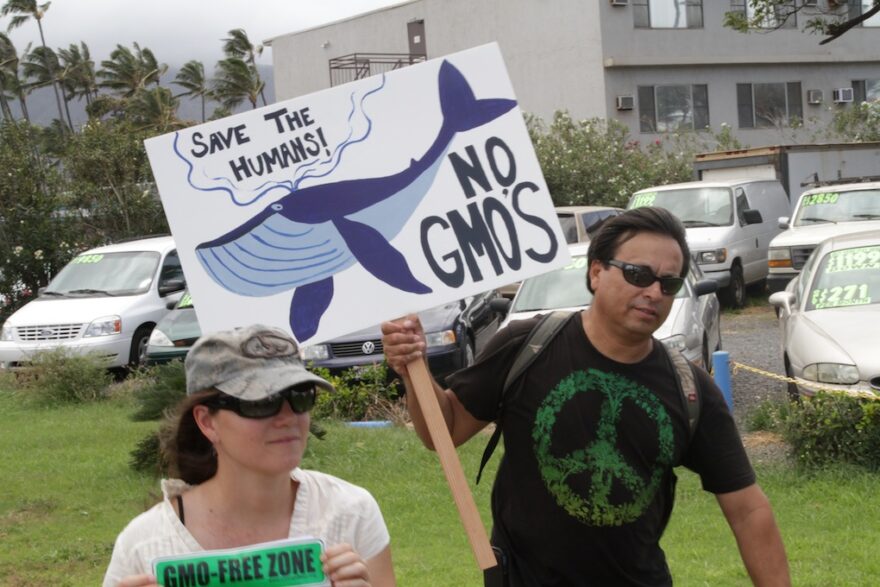 KAHULUI, HAWAII – March Against Monsanto protestors hold up a sign as they march down the main road in protest of Monsanto’s GMO foods. (Photo: Shepard Ambellas/Intellihub.com) Monsanto and their biotech buddies would have you believe that they are super-heroes, set on saving hungry children from starvation wearing a dazzling fake-green cape. In fact, in a recent attack on activists, Monsanto’s CEO Hugh Grant said that because critics “can afford” organic food, we don’t care about the plight of those who can’t afford it. “There is this strange kind of reverse elitism: If I’m going to do this, then everything else shouldn’t exist,” said Grant. “There is space in the supermarket shelf for all of us.”
Even Monsanto’s website is on the defense, with page after page attempting to justify what the biotech industry is doing to our food supply. It must be true if even leading “philanthropists” (and I use this term loosely) like Bill and Melinda Gates are behind the distribution of Monsanto crops across the globe. Right?
Actually, it’s all about the public’s perception. The push for acceptance of GMO foods has, thus far, been all about which team has the most money. Monsanto and their ilk can afford more television ads and more PR than anti-GMO activists can. Because the biotech companies, Big Food, and Big Agri can pay to spread their message, many people are convinced by their pure propaganda that GMOs are a necessary evil if the Third World is to avoid millions of slow, agonizing deaths by starvation. Because biotech is able to afford to blanket the media with their perspective, their view point is accepted as the correct one because that is the only perspective that many people ever hear.
But just because they shout the loudest, that doesn’t make it true.
How we address these misconceptions can mean the difference between swaying people to examine these claims more closely or causing them to stick their fingers in their ears and sing, “lalalalala…” to block us out. Here are some of the most common myths that Monsanto and friends would like you to believe about the wonderful world of GMOs. Myth #1: No one has ever proven that GMOs are harmful to people.Monsanto mouthpieces have been quoted time, time, and time again stating the untruth that genetically modified organisms have never been proven to harm people. It seems that they believe, like Joseph Goebbels, the uncontested King of Propaganda, that if you repeat a lie often enough, and with enough conviction, that it becomes the accepted truth.
The reality: Just a few of the results of a GMO diet (based on peer-reviewed studies) are: grotesque tumors, premature death, organ failure, gastric lesions, liver damage, kidney damage, severe allergic reactions, a viral gene that disrupts human functions…you can read more HERE. Myth #2: GMO crops are the only way to solve world hunger.The most common pro-GMO argument that you will hear these days is that genetically modified crops are the only way to feed the worlds burgeoning population. Without them, proponents claim that hunger will claim the lives of millions over the next decade. In the gospel of biotech, GMOs are the answer to world hunger. If you protest against GMO technology, you are cast as a cold-hearted elitist and the deaths of all of those suffering children in ***** (pick-a-3rd-world-country) rest firmly on your doorstep.
The reality: Sustainable agricultural practices are the answer to world hunger. GMO farming practices are not sustainable. Farmers who plant GMOs are not able to save their seeds from year to year due to patent infringement and poor fertility in the seeds. Therefore, after getting the first year of good harvests, the following year they must continue buying seeds, leading to perpetual debt and enough financial despair in India (the Bt Cotton scandal) that an Indian farmer took his own life every 30 minutes, after becoming the indentured servant of Monsanto and drowning in insurmountable debt. Well over a quarter of a million farmers died by suicide before the country banned the sale of Bt cotton seeds.
Real Change News agrees that biotech farming methods are not the answer to world hunger. They recommend “agroecology”:
Myth #3: GMOs need less pesticide spraying.Monsanto claims that their Bt products require less spraying. It’s right HERE on their website (emphasis mine):
Crops with a Bt trait have been modified to produce a protein that is toxic to various forms of insect larvae. Bt proteins have long been used as topical sprays in conventional and organic agriculture because they are effective and can be used safely. Crops that are genetically engineered to carry the Bt trait allow farmers to protect their crops while eliminating or significantly decreasing the amount of pesticides sprayed.
The reality: Unfortunately, the best laid schemes of mice, men, and Monsanto often go awry. The Cornucopia Institute reports that was true for the first couple of years, but then use of pesticides and herbicides increased dramatically. (This, of course, resulted in a hefty profit for the producers of those chemicals who are…yep, you guessed it, Monsanto and the other biotech companies who produce the seeds.)
Other organizations concur and even the mainstream media has been forced to report that pesticide and herbicide usage is on the rise. Check out these recent articles from Huffington Post and Reuters for more information. Myth #4: GMO technology is comparable to the cross-breeding that our ancestors did to create hardier versions of heritage crops.Check out this condescending blurb, straight from the horse’s …ummm….mouth (the Monsanto website):
The reality: What our ancestors did, and what responsible farmers do, is cross-pollination of different varieties of the same plant. It is a low tech method that can occur naturally – but they just gave it a little bit of help in order to bring forth the desirable characteristics, like the drought-hardiness of one type of wheat combined with the shorter growing season required for another type of wheat. This is selective breeding. Genetically modifying seeds is a whole different ballgame, however. Here’s a great explanation from the Food Renegade website:
What’s even worse is that biotech has the ability to produce their seeds with a built in “terminator technology.” This means that the seeds cannot be saved from one year to the next (unlike the cross-pollinated seeds with which they try to claim kinship). Monsanto has patented the technology (called gene use restriction technology) but claims not to use it. This would produce sterile, lifeless seeds that could not be reused, leaving the farmers utterly dependent on the biotech companies for future crops while providing an ongoing stream of income for those companies. At this point they maintain their monopoly through a series of contracts and patents that require the repurchase of seeds annually. Myth #5: If the FDA and the USDA allow GMO’s, they must be safe to consume.Organizations like the FDA, the EPA, and the USDA all wear a shiny halo. They receive their power and influence from the mere fact that the public believes that their number one priority is the health and safety of the citizens they are supposed to be serving. All of the agencies vow that they are there to protect the public on their websites: The FDA:
The Vision Statement of the USDA:
The EPA:
The reality: All of the above is just feel-good, warm and fuzzy rhetoric. Perhaps there are employees that truly believe in what they’re doing, but the leadership is as sickeningly tainted as Bt Corn.
Part of the reason Monsanto has been so successful in the courtroom has been the company’s incestuous ties to the US de facto government. Despite the blatant conflicts of interest, Monsanto executives have held Cabinet, judicial and policy-making positions in the Bush, Clinton and Obama administrations. When you’re sleeping with the enemy, the enemy tends to get away with all manner of crimes.
Make no mistake, the commissioners, directors, and secretaries of these agencies are put in place for a reason. That reason is to grease the wheels for the wealthy biotech firms (and drug companies and Big Food companies and…well, you get the idea). Through an abuse of trust placed in them by the American people, they abuse their power and practice deception on the grandest scale imaginable.
If the FDA, USDA, or the EPA approve something, you might want to view it with more suspicion than acceptance. If they can say that radiation and pesticides are acceptable in your food, but that raw milk isn’t acceptable for consumption…well, there’s something incredibly wrong here.
(Read more about the abuses and deceptions of the EPA and the FDA.) Myth #6: There is no nutritional difference between GMO’s and non-GMO’s.Biotech will tell you that there is absolutely no nutritional difference between genetically modified food and its organic counterpart. They will cite the calories, the fiber, and all of the macronutrients, pointing out that they are identical. They will scoff and roll their collective eyes at the “ignorance” of people who pay double to triple the price to avoid GMOs in their kitchens. Even television’s Dr. Oz came out on his show in support of the nutritional equality of GMO foods, saying that organic food was “undemocratic”.
The reality: A shocking report released on the blog Moms Across America last March revealed that the nutritional differences in GMO vs non-GMO corn were astounding. The report was from the non-GMO corn company De Dell, in Canada. Not only are the nutritional values different, but the levels of poison in the corn are toxic:
There is more evidence of higher nutrient levels in non-GMO, organic foods:
Myth #7: GMOs are impossible to avoid.It’s true that GMOs lurk in over 70% of the processed foods that line the grocery store shelves. Even the mainstream media has reported on the omnipresence of genetically modified ingredients. This makes it very difficult to avoid them. The biotech companies have spent millions and millions of dollars in the fight against GMO labeling in an attempt to convince the public that the grocery costs will go up without their seeds.
The reality: It’s difficult but not impossible! Here are some tips to banish GMOs from your kitchen once and for all:
Myth #8: Monsanto has our best interests in mind.All you need to do is read Monsanto’s website and it becomes clear. These people are the benevolent saviors of all mankind and their genetically modified seeds are the vehicle with which all of the world will be fed. Monsanto’s CEO Hugh Grant writes:
At the risk of your breakfast, click HERE to learn more about Monsanto’s commitment to integrity, dialogue, transparency, sharing, benefits, respect, acting as owners to achieve results, and creating a great place to work. The reality: A German magazine, Sustainable Pulse, views it a little differently. Last week they came out with an article that outlined the mysterious mishaps that have been befalling activists and researchers across Europe. Here’s a link to the enlightening article (English version). Last month, just days before researchers were to present a damaging study, their computers were attacked by sophisticated hackers. The scheduled press conference had to be cancelled.
The article above also speculates that the US government itself is on board with spying on anti-Monsanto activists…it’s a must-read.
There’s more. This do-good company has hired the notorious mercenaries from the former Blackwater to help deal with activists. An article by Jeremy Scahill of the Nation explains that Monsanto has already given them over half a million dollars to help deal with activists:
Monsanto is taking surreptitious action against the movement, whether on their own or through the use of “contractors”. They have engaged in a social media war against activists. Mysterious things have been occurring on the social networks: posts have disappeared, some posts are hidden from the timelines of readers, and trolls abound on pages like March Against Monsanto and Occupy Monsanto. Readers often have difficulty sharing pertinent anti-GMO articles on social media. The internet war is ON. Myth #9: GMOs are not harmful to the environment.Biotech would have you believe that the farming of GMOs is as green an industry as organic farming, bringing prosperity and abundance to all.
The reality: We need look no further than the island of Molokai in Hawaii to see the horrible environmental damage wrought by Monsanto. Air quality and water quality are deadly because of Monsanto’s almost-2000 acre test facility. The story of the island is heartbreaking: people are dying horrible deaths, infertility is rampant, and other farms are being tainted by cross pollination from the frankencorn growing there. Workers wear head to toe protective gear during spraying, including respirators. Nearby residents, however, are not provided with such equipment and have no option but to breathe in the toxic dust that comes from the fields. This is not merely anecdotal to the small island – worldwide, many areas around GMO farms report horrific bloody skin rashes, an uptick in asthma, and toxic pesticides that leach into the groundwater. Myth #10: Get used to it. GMOs are here to stay.Biotech wants you to believe that there is no sense in fighting them. They want you to just accept what they have to say and eat their tainted products. They hope that people feel like they are too powerful to fight and like the battle has already been won.
The reality: There is a war against GMOs and we, the resistance, are gaining ground. By sharing information like this and informing the public of the poisons that are being grown in our own back yard, we can fight back against biotech. By using the power of social media, by organizing and demonstrating like millions of people did during the March Against Monsanto, we can say no.
By refusing to purchase any products that contain GMOs , by refusing to consume GMOs at restaraunts, and by spreading the word about the dangers, we can make a difference. By educating the public and letting them know that we have been deceived by the biotech industry, by Big Agri, and by Big Food, and that we have been betrayed by the elected officials and the agencies of our own government, we can stand united against these monolithic companies. We can remind them that the only way they will stay in business is if we, the consumers, purchase their products, and that we, the consumers, will not allow them to poison our families and our environment anymore. Become a grocery store revolutionary.This is war. If something could mean the difference between life and death for your children, between health and disease, between fertility or barrenness, wouldn’t you do anything to keep them safe? That’s why we can’t just sit there and watch this go on from the sidelines, shaking our heads.
It really is as simple as just saying no to GMOs but we all have to do it. We have to refuse to eat these so-called foods and we have to let people know why. We have to publicly expose these myths for the fiction that they are. We have to use social media, talk to our friends, demonstrate, write letters to the editor…we have to shine the light on the lies. Education and information are the weapons for this fight.
Make no mistake – the encroaching takeover of our food supply is an extinction level event. Will you just watch it happen? Credit: Thank you to the wonderful social media community that generously contributed to this article! Your activism makes the fight possible! Excellent resource: Earth Open Source offers a deeply scientific analysis in their own report, GMO MYTHS AND TRUTHS REPORT |
|

GMOs: The ultimate solutionSunday, December 30, 2012 by: Hesh Goldstein https://www.naturalnews.com/038544_gmos_solution_monsanto.html#ixzz2OKAcfiQm (NaturalNews) By now, most of us are aware of the GMO problem and the political corruption akin to it.
Monsanto claims that GMOs are safe. This was the same comment made by the tobacco companies back in the 40s and early 50s regarding cigarette smoking.
Now we know without a doubt that smoking and lung and throat cancer are kissing cousins. Because GMOs have been around for 15 years or so, with no long-term studies other than Monsanto’s being done, we only have Monsanto’s word that GMOs are safe.
Fortunately, there have been studies done by Michael Antoniou of Earth Open Source and Dr. Giles-Eric Seralini of the University of Caan in France that say otherwise.
What Antoniou and Seralini have found is that GMOs, which are inundated with pesticides like RoundUp Ready containing glyphosate and 2-4-D, the active ingredient in Agent Orange, create numerous health problems, including birth defects, cancer, neurological imbalances, embryonic deaths, DNA damage, and fetal death. It’s not rocket science to understand that when you eat a steady diet of these horrible chemicals, you will suffer disastrous health ramifications despite the fact that the GMO crops are designed to resist the heavy poisoning of the pesticides and herbicides.
So, where does the corruption tie in? Obviously with the politicians.
We know that when Obama campaigned in 2008, he promised he would label GMOs. When elected, not only did he renege on that promise but immediately appointed former Monsanto VP and attorney Michael Taylor, aka “Monsanto Mike”, as the Head of Food Safety at the Fraud and Drug Administration and Tom Vilsack, another biotech hooker, as the Secretary of Agriculture.
I don’t know about other States, but in Hawaii, from the Governor on down, almost all the Legislators have been bought, with none wanting to bite the hand that feeds them.
In Hawaii, Monsanto has six registered lobbyists – John Radcliffe, George “Red” Morris, Dawn Bicoy, Paul Koehler, Alan Takemoto, Fred Perlak, and Alicia Maluafiti. Radcliffe and Morris have an iron grip on our politicians and Maluafiti is the Executive Director of the Hawaii Crop Improvement Association and along with Radcliffe and Morris, they have bought off with thousands of dollars our, if you will pardon the expression, lawmakers. The other biotech monsters are Syngenta, Pioneer (DuPont), Bayer (aspirin anyone?), and BASF, each having their own lobbyists as well.
Recently at our City Council we had endless hearings on GMO labeling. Of the seven Council members, five were bought off and recommended that labeling should be done at the Federal level and put in the hands of the President, the FDA, and the Agriculture Department. Talk about frustration.
Yet, despite this endless array of governmental corruption, there is a bright note. Recently the Hawaii Board of Water Supply denied Monsanto’s request to use 2.6 million gallons of water a day to water their highly pesticide laden poisonous so-called food. Maybe there’s hope for use yet.
When studying the world we find that the countries of Austria, Bulgaria, Germany, Greece, Hungary, Ireland, Japan, Luxembourg, Madeira, New Zealand, Peru, South Australia, and Switzerland have rejected GMO and kicked out Monsanto.
In California, believe it or not, the counties of Mendocino, Trinity and Marin have banned GMOs.
The countries caring little for their people are Canada, China, England, the European Union, Philippines, South Africa, and the good ol’ U S of A.
Thailand and France are on the fence. Damned if they do and damned if they don’t. And if India had its way, Monsanto would be gone in a heart’s beat.
Recently, Jon Rappaport wrote and incredible article talking about how Monsanto loves the labeling issue and could not care less one way or another.
When I go into any of the mainstream supermarkets in Hawaii and watch the shoppers it blows me away. They go to a shelf, pick a product, and put it in their cart. Never once does anyone ever read the label. And, I see basically the same thing in the natural food stores.
What that tells me is that for the most part the people are clueless with any part of any issue with GMOs. In fact, if you ask most people what they know about GMOs, their response is usually, Whaaaaaaat?
And Monsanto loves that. So if labeling happens or doesn’t happen it’s a win-win situation for them. The few people that know about GMOs and read labels will not buy them but the clueless ones that never read labels anyway will continue to buy them. And Monsanto will continue laughing all the way to the bank.
So, I say, the hell with labeling. Let’s fight to BAN GMOs in the United States. Trust me, that’s a fight that will really get Monsanto’s attention. And if that happens, so many cockroaches will come out of the woodwork it will make your head swim.
For those of you that have never seen the film “Soylent Green”, please get it and watch it and realize that in the generations to come, if we do not unite and fight, Monsanto will ultimately open the first Soylent Green factory.
In closing and to apologize for saying the same thing over and over in every article I write about GMOs, if the following do NOT say non-GMO or organic, DO NOT BUY THEM – soy, corn, cotton.
Those are the big three to stay away from. Canola, whether it says organic or non-GMO, do not touch it with a 10 foot pole unless you can tell me how an industrial solvent can be organic and good for your health.
The biotech demons are also getting into alfalfa, sugar beets, and potatoes. So sprout your own alfalfa seeds or buy them from a reputable place where you can ascertain they are not GMO.
Stay way from sugar and go with honey or maple syrup. And for the most part, buy and eat as much organically grown vegetables and grains as you can to be safe.
And for you non-vegetarians out there, your dead animals are fed GMO grains as well as the feathers, blood, the dead, dying, diseased, and decayed animals not fit for sale, as well as road-kill. And if you are so fixed on the range-fed scam, it’s the saturated fat that found in all animal flesh that gives you just about every disease known to mankind.
Oh yeah, all the fish in the world are loaded with mercury, radiation, heavy metals and toxic wastes. And now, Frankensalmon does not have to be labeled as such.
Aloha! About the author: After being vaccinated with the DTP vaccine as a child I developed asthma. After taking the organic sulfur crystals (they are harvested from the pine trees in Louisiana) in November of 2008 for 10 days my asthma reversed and has not come back over 4 years later, 18 cases, so far, of autism have been reversed, as has cancer, Alzheimer’s and Parkinson’s disease, osteoarthritis, joint pain, astigmatism, gum disease, increased sexual activity, heavy metal and radiation elimination, parasite elimination, free radicals elimination, faster athletic recovery time, increased blood circulation, reduced inflammation, resistance to getting the flu, reduction of wrinkles, allergy reduction, reduced PMS and monthly period pain, nausea, migraines and so much more. And it’s only possible because of the oxygen it releases that floods the cells of the body. The sulfur, as proven by the University of Southampton in England, enables the body to produce vitamin B12 and the essential amino acids. You can find out more about this incredible nutrient also on my website – www.healthtalkhawaii.com -. |
|

Match Made In Hell: Bayer-Monsanto Partnership Signals Death Knell for HumanityTyler Durden Sat, 06/30/2018 – 19:00 https://www.zerohedge.com/news/2018-06-30/match-made-hell-bayer-monsanto-partnership-signals-death-knell-humanity
On what plane of reality is it possible that two of the world’s most morally bankrupt corporations, Bayer and Monsanto, can be permitted to join forces in what promises to be the next stage in the takeover of the world’s agricultural and medicinal supplies?
Warning, plot spoiler: There is no Mr. Hyde side in this horror story of epic proportions; it’s all Dr. Jekyll. Like a script from a David Lynch creeper, Bayer AG of poison gas fame has finalized its $66 billion (£50bn) purchase of Monsanto, the agrochemical corporation that should be pleading the Fifth in the dock on Guantanamo Bay instead of enjoying what amounts to corporate asylum and immunity from crimes against humanity. Such are the special privileges that come from being an above-the-law transnational corporation.
Unsurprisingly, the first thing Bayer did after taking on Monsanto, saddled as it is with the extra baggage of ethic improprieties, was to initiate a rebrand campaign. Like a Hollywood villain falling into a crucible of molten steel only to turn up later in some altered state, Monsanto has been subsumed under the Orwellian-sounding ‘Bayer Crop Science’ division, whose motto is: “Science for a better life.”
Yet Bayer itself provides little protective cover for Monsanto considering its own patchy history of corporate malfeasance. Far beyond its widely known business of peddling pain relief for headaches, the German-based company played a significant role in the introduction of poison gas on the battlefields of World War I.
Despite a Hague Convention ban on the use of chemical weapons since 1907, Bayer CEO Carl Duisberg, who sat on a special commission set up by the German Ministry of War, knew a business opportunity when he saw one.
Duisberg witnessed early tests of poison gas and had nothing but glowing reports on the horrific new weapon:
Bayer, which built a department specifically for the research and development of gas agents, went on to develop increasingly lethal chemical weapons, such as phosgene and mustard gas. “This phosgene is the meanest weapon I know,” Duisberg remarked with a stunning disregard for life, as if he were speaking about the latest bug spray. “I strongly recommend that we not let the opportunity of this war pass without also testing gas grenades.”
Duisberg got his demonic wish. The opportunity to use the battlefield as a testing ground and soldiers as guinea pigs came in the spring of 1915 as Bayer supplied some 700 tons of chemical weapons to the war front. On April 22, 1915, it has been estimated that around 170 tons of chlorine gas were used for the first time on a battlefield in Ypres, Belgium against French troops. Up to 1,000 soldiers perished in the attack, and many more thousands injured.
In total, an estimated 60,000 people died as a result of the chemical warfare started by Germany in the First World War and supplied by the Leverkusen-based company.
According to Axel Koehler-Schnura from the Coalition against BAYER Dangers:
The criminal-like behavior has continued right up until modern times. Mike Papantonio, a US attorney and television presenter discussed one of the more heinous acts committed by this chemical company on Thomas Hartmann’s program, The Big Picture: “They produced a clotting agent for hemophiliacs, in the 1980s, called Factor VIII. This blood-clotting agent was tainted with HIV, and then, after the government told them they couldn’t sell it here, they shipped it all over the world, infecting people all over the world. That’s just part of the Bayer story.”
Papantonio, citing Bayer’s 2014 annual report, said the company is facing 32 different liability lawsuits around the world. For the 2018 Bayer liability report, click here.
Before flushing your Bayer products down the toilet, you may want to put aside an aspirin or two because the story gets worse.
One of the direct consequences of the ‘Baysanto’ monster will be a major hike in prices for farmers, already suffering a direct hit to their livelihood from unsustainable prices.
Yet it’s hard to imagine the situation getting any worse for the American farmer, who is now facing the highest suicide rate of any profession in the country. The suicide rate for Americans engaged in the field of farming, fishing and forestry is 84.5 per 100,000 people – more than five times that of the broader population.
This tragic trend echoes that of India, where about a decade ago millions of Indian farmers began switching from farming with traditional farming techniques to using Monsanto’s genetically modified seeds instead. In the past, following a millennia-old tradition, farmers saved seeds from one harvest and replanted them the following year. Those days of wisely following the rhythms and patterns of the natural world are almost over. Today, Monsanto GMO seeds are bred to contain ‘terminator technology’, with the resulting crops ‘programmed’ not to produce seeds of their own. In other words, the seed company is literally playing God with nature and our lives. Thus, hundreds of thousands of Indian farmers are forced to buy a new batch of seeds – together with Monsanto pesticide Round Up – each year and at a very prohibitive cost.
But should the world have expected anything different from the very same company that was involved in the production of Agent Orange for military use during the Vietnam War (1961-1971)? More than 4.8 million Vietnamese suffered adverse effects from the defoliant, which was sprayed over vast tracts of agricultural land during the war, destroying the fertility of the land and Vietnam’s food supply. About 400,000 Vietnamese died as a result of the US military’s use of Agent Orange, while millions more suffered from hunger, crippling disabilities and birth defects.
This is the company that we have allowed, together with Bayer, to control about one-quarter of the world’s food supply. This begs the question: Who is more nuts? Bayer and Monsanto, or We the People?
It’s important to mention that the Bayer – Monsanto convergence is not occurring in a corporate vacuum. It is all part of a race on the part of the global agrochemical companies to stake off the world’s food supplies. ChemChina has bought out Switzerland’s Syngenta for $43 billion, for example, while Dow and DuPont have forged their own $130 billion empire.
However, none of those companies carry the same bloodstained reputations as Bayer and Monsanto, a match made in hell that threatens all life on earth. |
|
JerusalemCats History:
Zyklon B Use in the Holocaust
In early 1942, Zyklon B emerged as the preferred killing tool of Nazi Germany for use in extermination camps during the Holocaust.[20] The chemical was used to kill roughly one million people in gas chambers installed in extermination camps at Auschwitz-Birkenau, Majdanek, and elsewhere.[21] Most of the victims were Jews, and by far the majority killed using this method died at Auschwitz.[22][23][b] Zyklon B was supplied to concentration camps at Mauthausen, Dachau, and Buchenwald by the distributor Heli, and to Auschwitz and Majdanek by Testa. Camps also occasionally bought Zyklon B directly from the manufacturers.[25] |
|
Effects of Monsanto’a Agent Orange on the Vietnamese people
The government of Vietnam says that 4 million of its citizens were exposed to Agent Orange, and as many as 3 million have suffered illnesses because of it; these figures include their children who were exposed.[3] The Red Cross of Vietnam estimates that up to 1 million people are disabled or have health problems due to contaminated Agent Orange.[4] The United States government has challenged these figures as being unreliable.[5] Bayer + Monsanto = A Match Made in Hell
|
|
From Rabbi Lazer Brody: Bayer and Monsanto: Axis of EvilMonday, 13 August 2018 http://lazerbrody.typepad.com/lazer_beams/2018/08/gmo-bayer-and-monsanto-axis-of-evil-.html  Block 10 was the medical experimentation block in Auschwitz. German doctors, most of whom also participated in selections applied for permission to come work in Block 10 at Auschwitz with human subjects
The closer we get to Moshiach, the more we see Divine justice settling unfinished scores. An apparently innocuous item on the international newswire reveals an iceberg of evil that Hashem’s fiery wrath will soon erase from the face of the earth. The shares of Bayer Pharmaceuticals just fell 10%, the result of their subsidiary Monsanto’s failure to warn of the cancer risks posed by its infamous weed killer, Roundup.
Before I tell you who Bayer is, they bought Monsanto earlier this year for $63 Billion. Our sages teach that evil attaches itself to evil. In short, Monsanto is a conglomerate of evil that creates pesticides that destroy every type of viable seed – not only weeds – except for seeds that Monsanto genetically engineers. So, once you spray your field with Roundup, your soil is poisoned to regular seeds and you can only use Monsanto’s genetically-engineered seeds. But, new types of weeds set in that are immune to conventional weed killers, which require more and newer Monsanto weed killers. With mafia-like tactics, Monsanto has gone around the world, not only impoverishing farmers, poisoning their soil and indenturing them into virtual slavery, but causing an epidemic of farmer suicides, especially in India.
Monsanto also hijacks faculties of agriculture in the world’s universities, so that agronomy students will learn to use their products only. Thank goodness I majored in horticulture and deciduous orchards, where Monsanto’s poisoned hands didn’t yet reach my teachers. Fortunately, you can grow an apple, a peach or a plum without spraying Roundup…
Back to Bayer, who owns Monsanto. Do you know who Bayer is? Have you ever heard of IG Farben?
Both my pulse and my mind are racing much faster than I can type (chill, Lazer!) – let’s take it slow.
Do you know that IG Farben was behind the Nazi’s mutilation of our holy teacher, Rav Shalom Arush’s spiritual guide, Rabbi Yehuda Zev Leibowitz of saintly and blessed memory? That’s why he could never have children. Let me be more specific:
IG Farben financed Hitler’s electoral campaign and became a staunch supporter of the Nazis. IG Farben worked closely with the Nazi party to take over manufacturing plants when the Germans invaded other European countries. IG Farben also held stock in and was represented on the board of the company which produced the gas used in the Holocaust gas chambers. IG Farben tested its products on the concentration-camp prisoners of Auschwitz. Even more, IG Farben had its own concentration camp. Josef Mengele, the gruesome butcher of Auschwitz, the SS doctor (sic) and Hitler’s right-hand man in the planned annihilation of European Jewry, worked with IG Farben in doing his experimentation on human guinea pigs, one of whom was our sacred and beloved teacher Rabbi Yehuda Zev Leibowitz who succeeded in surviving the Holocaust.
Bayer is the successor and continuation of IG Farben. Monsanto belongs to Bayer.
Is the GMO and GE domination of our fields, crops and foodstuffs a continuation of the Nazi conspiracy to dominate the world? You make your own conclusions.
For anyone who seeks my advice, eat natural and organic as much as possible. Steer clear of US commercially grown corn and soybeans as well as processed foods that are full of such derivatives as corn syrup solids and soy isolate. If you have a headache, don’t take Bayer aspirin. Chances are that your headache – and many other ills, such as your close friend’s, your relative’s or your own autistic child – come from the use of Roundup in growing the food you eat.
The closer we get to Moshiach, the more we’ll see evil’s foundations crumble. Meanwhile, don’t lose heart, because the darkest darkness is right at the end of night, before the dawn of a new day. |
|
|
Monsanto’s History of Death and DestructionSeeds of Death Monsanto ExposedSEEDS OF DEATH – Dangerous GMO The Complete History of Monsanto, “The World’s Most Evil Corporation”By E Hanzai Global Research, November 25, 2019 https://www.globalresearch.ca/the-complete-history-of-monsanto-the-worlds-most-evil-corporation/5387964
First published by Waking Times, posted by Global Research in May 2014, this article provides a historical viewpoint. It is of particular relevance in relation to the Monsanto-Bayer merger. Monsanto-Bayer is relentlessly pushing the Worldwide adoption of glyphosate, which is carcinogenic.
Recent articles on Global Research have documented the devastating impacts of Glyphosate on human health. ***
Of all the mega-corps running amok, Monsanto has consistently outperformed its rivals, earning the crown as “most evil corporation on Earth!” Not content to simply rest upon its throne of destruction, it remains focused on newer, more scientifically innovative ways to harm the planet and its people.
1901: The company is founded by John Francis Queeny, a member of the Knights of Malta, a thirty year pharmaceutical veteran married to Olga Mendez Monsanto, for which Monsanto Chemical Works is named. The company’s first product is chemical saccharin, sold to Coca-Cola as an artificial sweetener.
Even then, the government knew saccharin was poisonous and sued to stop its manufacture but lost in court, thus opening the Monsanto Pandora’s Box to begin poisoning the world through the soft drink.
Even though PCBs were eventually banned after fifty years for causing such devastation, it is still present in just about all animal and human blood and tissue cells across the globe. Documents introduced in court later showed Monsanto was fully aware of the deadly effects, but criminally hid them from the public to keep the PCB gravy-train going full speed!
1930s: Created its first hybrid seed corn and expands into detergents, soaps, industrial cleaning products, synthetic rubbers and plastics. Oh yes, all toxic of course!
1940s: They begin research on uranium to be used for the Manhattan Project’s first atomic bomb, which would later be dropped on Hiroshima and Nagasaki, killing hundreds of thousands of Japanese, Korean and US Military servicemen and poisoning millions more.
The company continues its unabated killing spree by creating pesticides for agriculture containing deadly dioxin, which poisons the food and water supplies. It was later discovered Monsanto failed to disclose that dioxin was used in a wide range of their products because doing so would force them to acknowledge that it had created an environmental Hell on Earth.
1950s: Closely aligned with The Walt Disney Company, Monsanto creates several attractions at Disney’s Tomorrowland, espousing the glories of chemicals and plastics. Their “House of the Future” is constructed entirely of toxic plastic that is not biodegradable as they had asserted. What, Monsanto lied? I’m shocked!
Monsanto’s Disneyfied vision of the future:
1960s: Monsanto, along with chemical partner-in-crime DOW Chemical, produces dioxin-laced Agent Orange for use in the U.S.’s Vietnam invasion. The results? Over 3 million people contaminated, a half-million Vietnamese civilians dead, a half-million Vietnamese babies born with birth defects and thousands of U.S. military veterans suffering or dying from its effects to this day!
Monsanto is hauled into court again and internal memos show they knew the deadly effects of dioxin in Agent Orange when they sold it to the government. Outrageously though, Monsanto is allowed to present their own “research” that concluded dioxin was safe and posed no negative health concerns whatsoever. Satisfied, the bought and paid for courts side with Monsanto and throws the case out. Afterwards, it comes to light that Monsanto lied about the findings and their real research concluded that dioxin kills very effectively.
A later internal memo released in a 2002 trial admitted
Monsanto partners with I.G. Farben, makers of Bayer aspirin and the Third Reich’s go-to chemical manufacturer producing deadly Zyklon-B gas during World War II. Together, the companies use their collective expertise to introduce aspartame, another extremely deadly neurotoxin, into the food supply. When questions surface regarding the toxicity of saccharin, Monsanto exploits this opportunity to introduce yet another of its deadly poisons onto an unsuspecting public.
1970s: Monsanto partner, G.D. Searle, produces numerous internal studies which claim aspartame to be safe, while the FDA’s own scientific research clearly reveals that aspartame causes tumors and massive holes in the brains of rats, before killing them. The FDA initiates a grand jury investigation into G.D. Searle for “knowingly misrepresenting findings and concealing material facts and making false statements” in regard to aspartame safety.
During this time, Searle strategically taps prominent Washington insider Donald Rumsfeld, who served as Secretary of Defense during the Gerald Ford and George W. Bush presidencies, to become CEO. The corporation’s primary goal is to have Rumsfeld utilize his political influence and vast experience in the killing business to grease the FDA to play ball with them.
A few months later, Samuel Skinner receives “an offer he can’t refuse,” withdraws from the investigation and resigns his post at the U.S. Attorney’s Office to go work for Searle’s law firm. This mob tactic stalls the case just long enough for the statute of limitation to run out and the grand jury investigation is abruptly and conveniently dropped.
1980s: Amid indisputable research that reveals the toxic effects of aspartame and as then FDA commissioner Dr. Jere Goyan was about to sign a petition into law keeping it off the market, Donald Rumsfeld calls Ronald Reagan for a favor the day after he takes office. Reagan fires the uncooperative Goyan and appoints Dr. Arthur Hayes Hull to head the FDA, who then quickly tips the scales in Searle’s favor and NutraSweet is approved for human consumption in dried products.This becomes sadly ironic since Reagan, a known jelly bean and candy enthusiast, later suffers from Alzheimers during his second term, one of the many horrific effects of aspartame consumption.
Searle’s real goal though was to have aspartame approved as a soft drink sweetener since exhaustive studies revealed that at temperatures exceeding 85 degrees Fahrenheit, it “breaks down into known toxins Diketopiperazines (DKP), methyl (wood) alcohol, and formaldehyde.”(4), becoming many times deadlier than its powdered form!
The National Soft Drink Association (NSDA) is initially in an uproar, fearing future lawsuits from consumers permanently injured or killed by drinking the poison. When Searle is able to show that liquid aspartame, though incredibly deadly, is much more addictive than crack cocaine, the NSDA is convinced that skyrocketing profits from the sale of soft drinks laced with aspartame would easily offset any future liability. With that, corporate greed wins and the unsuspecting soft drink consumers pay for it with damaged healths.
Coke leads the way once again (remember saccharin?) and begins poisoning Diet Coke drinkers with aspartame in 1983. As expected, sales skyrocket as millions become hopelessly addicted and sickened by the sweet poison served in a can. The rest of the soft drink industry likes what it sees and quickly follows suit, conveniently forgetting all about their initial reservations that aspartame is a deadly chemical. There’s money to be made, lots of it and that’s all that really matters to them anyway!
In 1985, undaunted by the swirl of corruption and multiple accusations of fraudulent research undertaken by Searle, Monsanto purchases the company and forms a new aspartame subsidiary called NutraSweet Company. When multitudes of independent scientists and researchers continue to warn about aspartame’s toxic effects, Monsanto goes on the offensive, bribing the National Cancer Institute and providing their own fraudulent papers to get the NCI to claim that formaldehyde does not cause cancer so that aspartame can stay on the market.
The known effects of aspartame ingestion are: “mania, rage, violence, blindness, joint-pain, fatigue, weight-gain, chest-pain, coma, insomnia, numbness, depression, tinnitus, weakness, spasms, irritability, nausea, deafness, memory-loss, rashes, dizziness, headaches, seizures, anxiety, palpitations, fainting, cramps, diarrhoea, panic, burning in the mouth. Diseases triggered/mimmicked include diabetes, MS, lupus, epilepsy, Parkinson’s, tumours, miscarriage, infertility, fibromyalgia, infant death, Alzheimer’s… Source : U.S. Food & Drug Administration.(5)
Further, 80% of complaints made to the FDA regarding food additives are about aspartame, which is now in over 5,000 products including diet and non-diet sodas and sports drinks, mints, chewing gum, frozen desserts, cookies, cakes, vitamins, pharmaceuticals, milk drinks, instant teas, coffees, yogurt, baby food and many, many more!(6) Read labels closely and do not buy anything that contains this horrific killer!
Amidst all the death and disease, FDA’s Arthur Hull resigns under a cloud of corruption and is immediately hired by Searle’s public relations firm as a senior scientific consultant. No, that’s not a joke! Monsanto, the FDA and many government health regulatory agencies have become one and the same! It seems the only prerequisite for becoming an FDA commissioner is that they spend time at either Monsanto or one of the pharmaceutical cartel’s organized crime corps.
1990s: Monsanto spends millions defeating state and federal legislation that disallows the corporation from continuing to dump dioxins, pesticides and other cancer-causing poisons into drinking water systems. Regardless, they are sued countless times for causing disease in their plant workers, the people in surrounding areas and birth defects in babies.
With their coffins full from the massive billions of profits, the $100 million dollar settlements are considered the low cost of doing business and thanks to the FDA, Congress and White House, business remains very good. So good that Monsanto is sued for giving radioactive iron to 829 pregnant women for a study to see what would happen to them.
In 1994, the FDA once again criminally approves Monsanto’s latest monstrosity, the Synthetic Bovine Growth Hormone (rBGH), produced from a genetically modified E. coli bacteria, despite obvious outrage from the scientific community of its dangers. Of course, Monsanto claims that diseased pus milk, full of antibiotics and hormones is not only safe, but actually good for you!
Worse yet, dairy companies who refuse to use this toxic cow pus and label their products as“rBGH-free” are sued by Monsanto, claiming it gives them an unfair advantage over competitors that did. In essence, what Monsanto was saying is “yeah, we know rBGH makes people sick, but it’s not alright that you advertise it’s not in your products.” The following year, the diabolical company begins producing GMO crops that are tolerant to their toxic herbicide Roundup. Roundup-ready canola oil (rapeseed), soybeans, corn and BT cotton begin hitting the market, advertised as being safer, healthier alternatives to their organic non-GMO rivals. Apparently, the propaganda worked as today over 80% of canola on the market is their GMO variety.
A few things you definitely want to avoid in your diet are GMO soy, corn, wheat and canola oil, despite the fact that many “natural” health experts claim the latter to be a healthy oil. It’s not, but you’ll find it polluting many products on grocery store shelves.
Because these GM crops have been engineered to ‘self-pollinate,’ they do not need nature or bees to do that for them. There is a very dark side agenda to this and that is to wipe out the world’s bee population. Monsanto knows that birds and especially bees, throw a wrench into their monopoly due to their ability to pollinate plants, thus naturally creating foods outside of the company’s “full domination control agenda.” When bees attempt to pollinate a GM plant or flower, it gets poisoned and dies. In fact, the bee colony collapse was recognized and has been going on since GM crops were first introduced.
To counter the accusations that they deliberately caused this ongoing genocide of bees, Monsanto devilishly buys out Beeologics, the largest bee research firm that was dedicated to studying the colony collapse phenomenon and whose extensive research named the monster as the primary culprit! After that, it’s “bees, what bees? Everything’s just dandy!” Again, I did not make this up, but wish I had!
During the mid-90s, they decide to reinvent their evil company as one focused on controlling the world’s food supply through artificial, biotechnology means to preserve the Roundup cash-cow from losing market-share in the face of competing, less-toxic herbicides. You see, Roundup is so toxic that it wipes out non-GMO crops, insects, animals, human health and the environment at the same time. How very efficient!
Because Roundup-ready crops are engineered to be toxic pesticides masquerading as food, they have been banned in the EU, but not in America! Is there any connection between that and the fact that Americans, despite the high cost and availability of healthcare, are collectively the sickest people in the world? Of course not! As was Monsanto’s plan from the beginning, all non-Monsanto crops would be destroyed, forcing farmers the world over to use only its toxic terminator seeds. And Monsanto made sure farmers who refused to come into the fold were driven out of business or sued when windblown terminator seeds poisoned organic farms.
This gave the company a virtual monopoly as terminator seed crops and Roundup worked hand in glove with each other as GMO crops could not survive in a non-chemical environment so farmers were forced to buy both.
Their next step was to spend billions globally buying up as many seed companies as possible and transitioning them into terminator seed companies in an effort to wipe out any rivals and eliminate organic foods off the face of the earth. In Monsanto’s view, all foods must be under their full control and genetically modified or they are not safe to eat! They pretend to be shocked that their critics in the scientific community question whether crops genetically modified with the genes of diseased pigs, cows, spiders, monkeys, fish, vaccines and viruses are healthy to eat. The answer to that question is obviously a very big “no way!”
You’d think the company would be so proud of their GMO foods that they’d serve them to their employees, but they don’t. In fact, Monsanto has banned GM foods from being served in their own employee cafeterias. Monsanto lamely responded “we believe in choice.” What they really means is “we don’t want to kill the help.”
It’s quite okay though to force-feed poor nations and Americans these modified monstrosities as a means to end starvation since dead people don’t need to eat! I’ll bet the thought on most peoples’ minds these days is that Monsanto is clearly focused on eugenics and genocide, as opposed to providing foods that will sustain the world. As in Monsanto partner Disney’s Sleeping Beauty, the wicked witch gives the people the poisoned GMO apple that puts them to sleep forever!
2000s: By this time Monsanto controls the largest share of the global GMO market. In turn, the US gov’t spends hundreds of millions to fund aerial spraying of Roundup, causing massive environmental devastation. Fish and animals by the thousands die within days of spraying as respiratory ailments and cancer deaths in humans spike tremendously. But this is all considered an unusual coincidence so the spraying continues. If you thought Monsanto and the FDA were one and the same, well you can add the gov’t to that sorry list now.
The monster grows bigger: Monsanto merges with Pharmacia & Upjohn, then separates from its chemical business and rebrands itself as an agricultural company. Yes, that’s right, a chemical company whose products have devastated the environment, killed millions of people and wildlife over the years now wants us to believe they produce safe and nutritious foods that won’t kill people any longer. That’s an extremely hard-sell, which is why they continue to grow bigger through mergers and secret partnerships.
Because rival DuPont is too large a corporation to be allowed to merge with, they instead form a stealth partnership where each agrees to drop existing patent lawsuits against one another and begin sharing GMO technologies for mutual benefit. In layman’s terms, together they would be far too powerful and politically connected for anything to stop them from owning a virtual monopoly on agriculture; “control the food supply & you control the people!” Not all is rosy as the monster is repeatedly sued for $100s of millions for causing illness, infant deformities and death by illegally dumping all manner of PCBs into ground water, and continually lying about products safety – you know, business as usual.
The monster often perseveres and proves difficult to slay as it begins filing frivolous suits against farmers it claims infringe on their terminator seed patents. In virtually all cases, unwanted seeds are windblown onto farmers’ lands by neighboring terminator-seeded farms. Not only do these horrendous seeds destroy the organic farmers’ crops, the lawsuits drive them into bankruptcy, while the Supreme Court overturns lower court rulings and sides with Monsanto each time.
At the same time, the monster begins filing patents on breeding techniques for pigs, claiming animals bred any way remotely similar to their patent would grant them ownership. So loose was this patent filing that it became obvious they wanted to claim all pigs bred throughout the world would infringe upon their patent.
The global terrorism spreads to India as over 100,000 farmers who are bankrupted by GMO crop failure, commit suicide by drinking Roundup so their families will be eligible for death insurance payments. In response, the monster takes advantage of the situation by alerting the media to a new project to assist small Indian farmers by donating the very things that caused crop failures in the country in the first place! Forbes then names Monsanto “company of the year.” Sickening, but true.
More troubling is that Whole Foods, the corporation that brands itself as organic, natural and eco-friendly is proven to be anything but. They refuse to support Proposition 37, California’s GMO-labeling measure that Monsanto and its GMO-brethren eventually helped to defeat.
Why? Because Whole Foods has been in bed with Monsanto for a long time, secretly stuffing its shelves with overpriced, fraudulently advertized “natural & organic” crap loaded with GMOs, pesticides, rBGH, hormones and antibiotics. So, of course they don’t want mandatory labelling as that would expose them as the Whole Frauds and Whore Foods that they really are! However, when over twenty biotech-friendly companies including WalMart, Pepsico and ConAgra recently met with FDA in favor of mandatory labelling laws, this after fighting tooth and nail to defeat Prop 37, Whole Foods sees an opportunity to save face and becomes the first grocery chain to announce mandatory labelling of their GMO products…in 2018! Uh, thanks for nothing, Whore.
And if you think its peers have suddenly grown a conscience, think again. They are simply reacting to the public’s outcry over the defeat of Prop 37 by crafting deceptive GMO-labelling laws to circumvent any real change, thus keeping the status quo intact.
To add insult to world injury, Monsanto and their partners in crime Archer Daniels Midland, Sodexo and Tyson Foods write and sponsor The Food Safety Modernization Act of 2009: HR 875. This “act” gives the corporate factory farms a virtual monopoly to police and control all foods grown anywhere, including one’s own backyard, and provides harsh penalties and jail sentences for those who do not use chemicals and fertilizers. President Obama decided this sounded reasonable and gave his approval. With this Act, Monsanto claims that only GM foods are safe and organic or homegrown foods potentially spread disease, therefore must be regulated out of existence for the safety of the world. If eating GM pesticide balls is their idea of safe food, I would like to think the rest of the world is smart enough to pass.
As further revelations have broken open regarding this evil giant’s true intentions, Monsanto crafted the ridiculous HR 933 Continuing Resolution, aka Monsanto Protection Act, which Obama robo-signed into law as well.This law states that no matter how harmful Monsanto’s GMO crops are and no matter how much devastation they wreak upon the country, U.S. federal courts cannot stop them from continuing to plant them anywhere they choose. Yes, Obama signed a provision that makes Monsanto above any laws and makes them more powerful than the government itself. We have to wonder who’s really in charge of the country because it’s certainly not him!
There comes a tipping point though when a corporation becomes too evil and the world pushes back…hard! Many countries continue to convict Monsanto of crimes against humanity and have banned them altogether, telling them to “get out and stay out!”
The world has begun to awaken to the fact that the corporate monster does not want control over the global production of food simply for profit’s sake. No, it’s become clear by over a century of death & destruction that the primary goal is to destroy human health and the environment, turning the world into a Mon-Satanic Hell on Earth!
Research into the name itself reveals it to be latin, meaning “my saint,” which may explain why critics often refer to it as “Mon-Satan.” Even more conspiratorially interesting is that free masons and other esoteric societies assigned numbers to each letter in our latin-based alphabet system in a six system. Under that number system, what might Monsanto add up to? Why, of course 6-6-6! Know that all is not lost. Evil always loses in the end once it is widely exposed to the light of truth as is occurring now. The fact that the Monsanto-led government finds it necessary to enact desperate legislation to protect its true leader proves this point. Being evicted elsewhere, the United States is Monsanto’s last stand so to speak.
Yet, even here many have begun striking back by protesting against and rejecting GMO monstrosities, choosing to grow their own foods and shop at local farmers markets instead of the Monsanto-supported corporate grocery chains.
The awakening people are also beginning to see they have been misled by corporate tricksters and federal government criminals poisoned by too much power, control and greed, which has resulted in the creation of the monstrous, out-of-control corporate beast. Notes (1,3) http://bestmeal.info/monsanto/company-history.shtml
The original source of this article is Waking Times
Copyright © E Hanzai, Waking Times, 2019 |
|

The Seeds Of Suicide: How Monsanto Destroys FarmingBy Dr. Vandana Shiva This article was originally published in April 2013 In recent developments, Monsanto and Bayer have merged into a powerful cartel which controls not only what we eat but also politicians, scientists and journalists.
*** Monsanto’s talk of ‘technology’ tries to hide its real objectives of control over seed where genetic engineering is a means to control seed,
These are the promises Monsanto India’s website makes, alongside pictures of smiling, prosperous farmers from the state of Maharashtra. This is a desperate attempt by Monsanto and its PR machinery to delink the epidemic of farmers’ suicides in India from the company’s growing control over cotton seed supply — 95 per cent of India’s cotton seed is now controlled by Monsanto.
Control over seed is the first link in the food chain because seed is the source of life. When a corporation controls seed, it controls life, especially the life of farmers.
Monsanto’s concentrated control over the seed sector in India as well as across the world is very worrying. This is what connects farmers’ suicides in India to Monsanto vs Percy Schmeiser in Canada, to Monsanto vs Bowman in the US, and to farmers in Brazil suing Monsanto for $2.2 billion for unfair collection of royalty.
Through patents on seed, Monsanto has become the “Life Lord” of our planet, collecting rents for life’s renewal from farmers, the original breeders.
Patents on seed are illegitimate because putting a toxic gene into a plant cell is not “creating” or “inventing” a plant. These are seeds of deception — the deception that Monsanto is the creator of seeds and life; the deception that while Monsanto sues farmers and traps them in debt, it pretends to be working for farmers’ welfare, and the deception that GMOs feed the world. GMOs are failing to control pests and weeds, and have instead led to the emergence of superpests and superweeds.
The entry of Monsanto in the Indian seed sector was made possible with a 1988 Seed Policy imposed by the World Bank, requiring the Government of India to deregulate the seed sector. Five things changed with Monsanto’s entry: First, Indian companies were locked into joint-ventures and licensing arrangements, and concentration over the seed sector increased. Second, seed which had been the farmers’ common resource became the “intellectual property” of Monsanto, for which it started collecting royalties, thus raising the costs of seed. Third, open pollinated cotton seeds were displaced by hybrids, including GMO hybrids. A renewable resource became a non-renewable, patented commodity. Fourth, cotton which had earlier been grown as a mixture with food crops now had to be grown as a monoculture, with higher vulnerability to pests, disease, drought and crop failure. Fifth, Monsanto started to subvert India’s regulatory processes and, in fact, started to use public resources to push its non-renewable hybrids and GMOs through so-called public-private partnerships (PPP).
India: We Must Reclaim Our Freedom from Monsanto Like We Did From the British
In 1995, Monsanto introduced its Bt technology in India through a joint-venture with the Indian company Mahyco. In 1997-98, Monsanto started open field trials of its GMO Bt cotton illegally and announced that it would be selling the seeds commercially the following year. India has rules for regulating GMOs since 1989, under the Environment Protection Act. It is mandatory to get approval from the Genetic Engineering Approval Committee under the ministry of environment for GMO trials. The Research Foundation for Science, Technology and Ecology sued Monsanto in the Supreme Court of India and Monsanto could not start the commercial sales of its Bt cotton seeds until 2002.
But it had changed Indian agriculture already.
Monsanto’s seed monopolies, the destruction of alternatives, the collection of superprofits in the form of royalties, and the increasing vulnerability of monocultures has created a context for debt, suicides and agrarian distress which is driving the farmers’ suicide epidemic in India. This systemic control has been intensified with Bt cotton. That is why most suicides are in the cotton belt.
An internal advisory by the agricultural ministry of India in January 2012 had this to say to the cotton-growing states in India — “Cotton farmers are in a deep crisis since shifting to Bt cotton. The spate of farmer suicides in 2011-12 has been particularly severe among Bt cotton farmers.”
The highest acreage of Bt cotton is in Maharashtra and this is also where the highest farmer suicides are. Suicides increased after Bt cotton was introduced — Monsanto’s royalty extraction, and the high costs of seed and chemicals have created a debt trap. According to Government of India data, nearly 75 per cent rural debt is due to purchase inputs. As Monsanto’s profits grow, farmers’ debt grows. It is in this systemic sense that Monsanto’s seeds are seeds of suicide.
The ultimate seeds of suicide is Monsanto’s patented technology to create sterile seeds. (Called “Terminator technology” by the media, sterile seed technology is a type of Gene Use Restriction Technology, GRUT, in which seed produced by a crop will not grow — crops will not produce viable offspring seeds or will produce viable seeds with specific genes switched off.) The Convention on Biological Diversity has banned its use, otherwise Monsanto would be collecting even higher profits from seed.
Monsanto’s talk of “technology” tries to hide its real objectives of ownership and control over seed where genetic engineering is just a means to control seed and the food system through patents and intellectual property rights.
A Monsanto representative admitted that they were “the patient’s diagnostician, and physician all in one” in writing the patents on life-forms, from micro-organisms to plants, in the TRIPS’ agreement of WTO. Stopping farmers from saving seeds and exercising their seed sovereignty was the main objective. Monsanto is now extending its patents to conventionally bred seed, as in the case of broccoli and capsicum, or the low gluten wheat it had pirated from India which we challenged as a biopiracy case in the European Patent office.
That is why we have started Fibres of Freedom in the heart of Monsanto’s Bt cotton/suicide belt in Vidharba. We have created community seed banks with indigenous seeds and helped farmers go organic. No GMO seeds, no debt, no suicides.
Vandana Shiva is a philosopher, environmental activist, and eco feminist.Shiva, currently based in Delhi, has authored more than 20 books and over 500 papers in leading scientific and technical journals. She was trained as a physicist and received her Ph.D. in physics from the University of Western Ontario, Canada. She was awarded the Right Livelihood Award in 1993. She is the founder of Navdanya http://www.navdanya.org/ She is a frequent contributor to Global Research
|
|
 MAY 2008 ISSUE MAY 2008 ISSUE
MONSANTO’S HARVEST OF FEARMonsanto already dominates America’s food chain with its genetically modified seeds. Now it has targeted milk production. Just as frightening as the corporation’s tactics–ruthless legal battles against small farmers–is its decades-long history of toxic contamination.BY DONALD L. BARLETT AND JAMES B. STEELE  No thanks: An anti-Monsanto crop circle made by farmers and volunteers in the Philippines.BY MELVYN CALDERON/GREENPEACE HO/A.P. IMAGES.
Gary Rinehart clearly remembers the summer day in 2002 when the stranger walked in and issued his threat. Rinehart was behind the counter of the Square Deal, his “old-time country store,” as he calls it, on the fading town square of Eagleville, Missouri, a tiny farm community 100 miles north of Kansas City.
The Square Deal is a fixture in Eagleville, a place where farmers and townspeople can go for lightbulbs, greeting cards, hunting gear, ice cream, aspirin, and dozens of other small items without having to drive to a big-box store in Bethany, the county seat, 15 miles down Interstate 35.
Everyone knows Rinehart, who was born and raised in the area and runs one of Eagleville’s few surviving businesses. The stranger came up to the counter and asked for him by name.
“Well, that’s me,” said Rinehart.
As Rinehart would recall, the man began verbally attacking him, saying he had proof that Rinehart had planted Monsanto’s genetically modified (G.M.) soybeans in violation of the company’s patent. Better come clean and settle with Monsanto, Rinehart says the man told him—or face the consequences.
Rinehart was incredulous, listening to the words as puzzled customers and employees looked on. Like many others in rural America, Rinehart knew of Monsanto’s fierce reputation for enforcing its patents and suing anyone who allegedly violated them. But Rinehart wasn’t a farmer. He wasn’t a seed dealer. He hadn’t planted any seeds or sold any seeds. He owned a small—a really small—country store in a town of 350 people. He was angry that somebody could just barge into the store and embarrass him in front of everyone. “It made me and my business look bad,” he says. Rinehart says he told the intruder, “You got the wrong guy.”
When the stranger persisted, Rinehart showed him the door. On the way out the man kept making threats. Rinehart says he can’t remember the exact words, but they were to the effect of: “Monsanto is big. You can’t win. We will get you. You will pay.”
Scenes like this are playing out in many parts of rural America these days as Monsanto goes after farmers, farmers’ co-ops, seed dealers—anyone it suspects may have infringed its patents of genetically modified seeds. As interviews and reams of court documents reveal, Monsanto relies on a shadowy army of private investigators and agents in the American heartland to strike fear into farm country. They fan out into fields and farm towns, where they secretly videotape and photograph farmers, store owners, and co-ops; infiltrate community meetings; and gather information from informants about farming activities. Farmers say that some Monsanto agents pretend to be surveyors. Others confront farmers on their land and try to pressure them to sign papers giving Monsanto access to their private records. Farmers call them the “seed police” and use words such as “Gestapo” and “Mafia” to describe their tactics.
When asked about these practices, Monsanto declined to comment specifically, other than to say that the company is simply protecting its patents. “Monsanto spends more than $2 million a day in research to identify, test, develop and bring to market innovative new seeds and technologies that benefit farmers,” Monsanto spokesman Darren Wallis wrote in an e-mailed letter to Vanity Fair. “One tool in protecting this investment is patenting our discoveries and, if necessary, legally defending those patents against those who might choose to infringe upon them.” Wallis said that, while the vast majority of farmers and seed dealers follow the licensing agreements, “a tiny fraction” do not, and that Monsanto is obligated to those who do abide by its rules to enforce its patent rights on those who “reap the benefits of the technology without paying for its use.” He said only a small number of cases ever go to trial.
Some compare Monsanto’s hard-line approach to Microsoft’s zealous efforts to protect its software from pirates. At least with Microsoft the buyer of a program can use it over and over again. But farmers who buy Monsanto’s seeds can’t even do that. The Control of NatureFor centuries—millennia—farmers have saved seeds from season to season: they planted in the spring, harvested in the fall, then reclaimed and cleaned the seeds over the winter for re-planting the next spring. Monsanto has turned this ancient practice on its head.
Monsanto developed G.M. seeds that would resist its own herbicide, Roundup, offering farmers a convenient way to spray fields with weed killer without affecting crops. Monsanto then patented the seeds. For nearly all of its history the United States Patent and Trademark Office had refused to grant patents on seeds, viewing them as life-forms with too many variables to be patented. “It’s not like describing a widget,” says Joseph Mendelson III, the legal director of the Center for Food Safety, which has tracked Monsanto’s activities in rural America for years.
Indeed not. But in 1980 the U.S. Supreme Court, in a five-to-four decision, turned seeds into widgets, laying the groundwork for a handful of corporations to begin taking control of the world’s food supply. In its decision, the court extended patent law to cover “a live human-made microorganism.” In this case, the organism wasn’t even a seed. Rather, it was a Pseudomonas bacterium developed by a General Electric scientist to clean up oil spills. But the precedent was set, and Monsanto took advantage of it. Since the 1980s, Monsanto has become the world leader in genetic modification of seeds and has won 674 biotechnology patents, more than any other company, according to U.S. Department of Agriculture data.
Farmers who buy Monsanto’s patented Roundup Ready seeds are required to sign an agreement promising not to save the seed produced after each harvest for re-planting, or to sell the seed to other farmers. This means that farmers must buy new seed every year. Those increased sales, coupled with ballooning sales of its Roundup weed killer, have been a bonanza for Monsanto.
This radical departure from age-old practice has created turmoil in farm country. Some farmers don’t fully understand that they aren’t supposed to save Monsanto’s seeds for next year’s planting. Others do, but ignore the stipulation rather than throw away a perfectly usable product. Still others say that they don’t use Monsanto’s genetically modified seeds, but seeds have been blown into their fields by wind or deposited by birds. It’s certainly easy for G.M. seeds to get mixed in with traditional varieties when seeds are cleaned by commercial dealers for re-planting. The seeds look identical; only a laboratory analysis can show the difference. Even if a farmer doesn’t buy G.M. seeds and doesn’t want them on his land, it’s a safe bet he’ll get a visit from Monsanto’s seed police if crops grown from G.M. seeds are discovered in his fields.
Most Americans know Monsanto because of what it sells to put on our lawns— the ubiquitous weed killer Roundup. What they may not know is that the company now profoundly influences—and one day may virtually control—what we put on our tables. For most of its history Monsanto was a chemical giant, producing some of the most toxic substances ever created, residues from which have left us with some of the most polluted sites on earth. Yet in a little more than a decade, the company has sought to shed its polluted past and morph into something much different and more far-reaching—an “agricultural company” dedicated to making the world “a better place for future generations.” Still, more than one Web log claims to see similarities between Monsanto and the fictional company “U-North” in the movie Michael Clayton, an agribusiness giant accused in a multibillion-dollar lawsuit of selling an herbicide that causes cancer.  Monsanto brought false accusations against Gary Rinehart—shown here at his rural Missouri store. There has been no apology. PHOTOGRAPHS BY KURT MARKUS. Monsanto brought false accusations against Gary Rinehart—shown here at his rural Missouri store. There has been no apology. PHOTOGRAPHS BY KURT MARKUS. Monsanto’s genetically modified seeds have transformed the company and are radically altering global agriculture. So far, the company has produced G.M. seeds for soybeans, corn, canola, and cotton. Many more products have been developed or are in the pipeline, including seeds for sugar beets and alfalfa. The company is also seeking to extend its reach into milk production by marketing an artificial growth hormone for cows that increases their output, and it is taking aggressive steps to put those who don’t want to use growth hormone at a commercial disadvantage.
Even as the company is pushing its G.M. agenda, Monsanto is buying up conventional-seed companies. In 2005, Monsanto paid $1.4 billion for Seminis, which controlled 40 percent of the U.S. market for lettuce, tomatoes, and other vegetable and fruit seeds. Two weeks later it announced the acquisition of the country’s third-largest cottonseed company, Emergent Genetics, for $300 million. It’s estimated that Monsanto seeds now account for 90 percent of the U.S. production of soybeans, which are used in food products beyond counting. Monsanto’s acquisitions have fueled explosive growth, transforming the St. Louis–based corporation into the largest seed company in the world.
In Iraq, the groundwork has been laid to protect the patents of Monsanto and other G.M.-seed companies. One of L. Paul Bremer’s last acts as head of the Coalition Provisional Authority was an order stipulating that “farmers shall be prohibited from re-using seeds of protected varieties.” Monsanto has said that it has no interest in doing business in Iraq, but should the company change its mind, the American-style law is in place.
To be sure, more and more agricultural corporations and individual farmers are using Monsanto’s G.M. seeds. As recently as 1980, no genetically modified crops were grown in the U.S. In 2007, the total was 142 million acres planted. Worldwide, the figure was 282 million acres. Many farmers believe that G.M. seeds increase crop yields and save money. Another reason for their attraction is convenience. By using Roundup Ready soybean seeds, a farmer can spend less time tending to his fields. With Monsanto seeds, a farmer plants his crop, then treats it later with Roundup to kill weeds. That takes the place of labor-intensive weed control and plowing.
Monsanto portrays its move into G.M. seeds as a giant leap for mankind. But out in the American countryside, Monsanto’s no-holds-barred tactics have made it feared and loathed. Like it or not, farmers say, they have fewer and fewer choices in buying seeds.
And controlling the seeds is not some abstraction. Whoever provides the world’s seeds controls the world’s food supply. Under SurveillanceAfter Monsanto’s investigator confronted Gary Rinehart, Monsanto filed a federal lawsuit alleging that Rinehart “knowingly, intentionally, and willfully” planted seeds “in violation of Monsanto’s patent rights.” The company’s complaint made it sound as if Monsanto had Rinehart dead to rights:
Faced with a federal lawsuit, Rinehart had to hire a lawyer. Monsanto eventually realized that “Investigator Jeffery Moore” had targeted the wrong man, and dropped the suit. Rinehart later learned that the company had been secretly investigating farmers in his area. Rinehart never heard from Monsanto again: no letter of apology, no public concession that the company had made a terrible mistake, no offer to pay his attorney’s fees. “I don’t know how they get away with it,” he says. “If I tried to do something like that it would be bad news. I felt like I was in another country.”
Gary Rinehart is actually one of Monsanto’s luckier targets. Ever since commercial introduction of its G.M. seeds, in 1996, Monsanto has launched thousands of investigations and filed lawsuits against hundreds of farmers and seed dealers. In a 2007 report, the Center for Food Safety, in Washington, D.C., documented 112 such lawsuits, in 27 states.
Even more significant, in the Center’s opinion, are the numbers of farmers who settle because they don’t have the money or the time to fight Monsanto. “The number of cases filed is only the tip of the iceberg,” says Bill Freese, the Center’s science-policy analyst. Freese says he has been told of many cases in which Monsanto investigators showed up at a farmer’s house or confronted him in his fields, claiming he had violated the technology agreement and demanding to see his records. According to Freese, investigators will say, “Monsanto knows that you are saving Roundup Ready seeds, and if you don’t sign these information-release forms, Monsanto is going to come after you and take your farm or take you for all you’re worth.” Investigators will sometimes show a farmer a photo of himself coming out of a store, to let him know he is being followed.
Lawyers who have represented farmers sued by Monsanto say that intimidating actions like these are commonplace. Most give in and pay Monsanto some amount in damages; those who resist face the full force of Monsanto’s legal wrath. Scorched-Earth TacticsPilot Grove, Missouri, population 750, sits in rolling farmland 150 miles west of St. Louis. The town has a grocery store, a bank, a bar, a nursing home, a funeral parlor, and a few other small businesses. There are no stoplights, but the town doesn’t need any. The little traffic it has comes from trucks on their way to and from the grain elevator on the edge of town. The elevator is owned by a local co-op, the Pilot Grove Cooperative Elevator, which buys soybeans and corn from farmers in the fall, then ships out the grain over the winter. The co-op has seven full-time employees and four computers.<
In the fall of 2006, Monsanto trained its legal guns on Pilot Grove; ever since, its farmers have been drawn into a costly, disruptive legal battle against an opponent with limitless resources. Neither Pilot Grove nor Monsanto will discuss the case, but it is possible to piece together much of the story from documents filed as part of the litigation.
Monsanto began investigating soybean farmers in and around Pilot Grove several years ago. There is no indication as to what sparked the probe, but Monsanto periodically investigates farmers in soybean-growing regions such as this one in central Missouri. The company has a staff devoted to enforcing patents and litigating against farmers. To gather leads, the company maintains an 800 number and encourages farmers to inform on other farmers they think may be engaging in “seed piracy.”
Once Pilot Grove had been targeted, Monsanto sent private investigators into the area. Over a period of months, Monsanto’s investigators surreptitiously followed the co-op’s employees and customers and videotaped them in fields and going about other activities. At least 17 such surveillance videos were made, according to court records. The investigative work was outsourced to a St. Louis agency, McDowell & Associates. It was a McDowell investigator who erroneously fingered Gary Rinehart. In Pilot Grove, at least 11 McDowell investigators have worked the case, and Monsanto makes no bones about the extent of this effort: “Surveillance was conducted throughout the year by various investigators in the field,” according to court records. McDowell, like Monsanto, will not comment on the case.
Not long after investigators showed up in Pilot Grove, Monsanto subpoenaed the co-op’s records concerning seed and herbicide purchases and seed-cleaning operations. The co-op provided more than 800 pages of documents pertaining to dozens of farmers. Monsanto sued two farmers and negotiated settlements with more than 25 others it accused of seed piracy. But Monsanto’s legal assault had only begun. Although the co-op had provided voluminous records, Monsanto then sued it in federal court for patent infringement. Monsanto contended that by cleaning seeds—a service which it had provided for decades—the co-op was inducing farmers to violate Monsanto’s patents. In effect, Monsanto wanted the co-op to police its own customers.
In the majority of cases where Monsanto sues, or threatens to sue, farmers settle before going to trial. The cost and stress of litigating against a global corporation are just too great. But Pilot Grove wouldn’t cave—and ever since, Monsanto has been turning up the heat. The more the co-op has resisted, the more legal firepower Monsanto has aimed at it. Pilot Grove’s lawyer, Steven H. Schwartz, described Monsanto in a court filing as pursuing a “scorched earth tactic,” intent on “trying to drive the co-op into the ground.”
Even after Pilot Grove turned over thousands more pages of sales records going back five years, and covering virtually every one of its farmer customers, Monsanto wanted more—the right to inspect the co-op’s hard drives. When the co-op offered to provide an electronic version of any record, Monsanto demanded hands-on access to Pilot Grove’s in-house computers.
Monsanto next petitioned to make potential damages punitive—tripling the amount that Pilot Grove might have to pay if found guilty. After a judge denied that request, Monsanto expanded the scope of the pre-trial investigation by seeking to quadruple the number of depositions. “Monsanto is doing its best to make this case so expensive to defend that the Co-op will have no choice but to relent,” Pilot Grove’s lawyer said in a court filing.
With Pilot Grove still holding out for a trial, Monsanto now subpoenaed the records of more than 100 of the co-op’s customers. In a “You are Commanded . . . ” notice, the farmers were ordered to gather up five years of invoices, receipts, and all other papers relating to their soybean and herbicide purchases, and to have the documents delivered to a law office in St. Louis. Monsanto gave them two weeks to comply.
Whether Pilot Grove can continue to wage its legal battle remains to be seen. Whatever the outcome, the case shows why Monsanto is so detested in farm country, even by those who buy its products. “I don’t know of a company that chooses to sue its own customer base,” says Joseph Mendelson, of the Center for Food Safety. “It’s a very bizarre business strategy.” But it’s one that Monsanto manages to get away with, because increasingly it’s the dominant vendor in town. Chemicals? What Chemicals?The Monsanto Company has never been one of America’s friendliest corporate citizens. Given Monsanto’s current dominance in the field of bioengineering, it’s worth looking at the company’s own DNA. The future of the company may lie in seeds, but the seeds of the company lie in chemicals. Communities around the world are still reaping the environmental consequences of Monsanto’s origins.
Monsanto was founded in 1901 by John Francis Queeny, a tough, cigar-smoking Irishman with a sixth-grade education. A buyer for a wholesale drug company, Queeny had an idea. But like a lot of employees with ideas, he found that his boss wouldn’t listen to him. So he went into business for himself on the side. Queeny was convinced there was money to be made manufacturing a substance called saccharin, an artificial sweetener then imported from Germany. He took $1,500 of his savings, borrowed another $3,500, and set up shop in a dingy warehouse near the St. Louis waterfront. With borrowed equipment and secondhand machines, he began producing saccharin for the U.S. market. He called the company the Monsanto Chemical Works, Monsanto being his wife’s maiden name.
The German cartel that controlled the market for saccharin wasn’t pleased, and cut the price from $4.50 to $1 a pound to try to force Queeny out of business. The young company faced other challenges. Questions arose about the safety of saccharin, and the U.S. Department of Agriculture even tried to ban it. Fortunately for Queeny, he wasn’t up against opponents as aggressive and litigious as the Monsanto of today. His persistence and the loyalty of one steady customer kept the company afloat. That steady customer was a new company in Georgia named Coca-Cola.
Monsanto added more and more products—vanillin, caffeine, and drugs used as sedatives and laxatives. In 1917, Monsanto began making aspirin, and soon became the largest maker worldwide. During World War I, cut off from imported European chemicals, Monsanto was forced to manufacture its own, and its position as a leading force in the chemical industry was assured.
After Queeny was diagnosed with cancer, in the late 1920s, his only son, Edgar, became president. Where the father had been a classic entrepreneur, Edgar Monsanto Queeny was an empire builder with a grand vision. It was Edgar—shrewd, daring, and intuitive (“He can see around the next corner,” his secretary once said)—who built Monsanto into a global powerhouse. Under Edgar Queeny and his successors, Monsanto extended its reach into a phenomenal number of products: plastics, resins, rubber goods, fuel additives, artificial caffeine, industrial fluids, vinyl siding, dishwasher detergent, anti-freeze, fertilizers, herbicides, pesticides. Its safety glass protects the U.S. Constitution and the Mona Lisa. Its synthetic fibers are the basis of Astroturf.
During the 1970s, the company shifted more and more resources into biotechnology. In 1981 it created a molecular-biology group for research in plant genetics. The next year, Monsanto scientists hit gold: they became the first to genetically modify a plant cell. “It will now be possible to introduce virtually any gene into plant cells with the ultimate goal of improving crop productivity,” said Ernest Jaworski, director of Monsanto’s Biological Sciences Program.
Over the next few years, scientists working mainly in the company’s vast new Life Sciences Research Center, 25 miles west of St. Louis, developed one genetically modified product after another—cotton, soybeans, corn, canola. From the start, G.M. seeds were controversial with the public as well as with some farmers and European consumers. Monsanto has sought to portray G.M. seeds as a panacea, a way to alleviate poverty and feed the hungry. Robert Shapiro, Monsanto’s president during the 1990s, once called G.M. seeds “the single most successful introduction of technology in the history of agriculture, including the plow.”
By the late 1990s, Monsanto, having rebranded itself into a “life sciences” company, had spun off its chemical and fibers operations into a new company called Solutia. After an additional reorganization, Monsanto re-incorporated in 2002 and officially declared itself an “agricultural company.”
In its company literature, Monsanto now refers to itself disingenuously as a “relatively new company” whose primary goal is helping “farmers around the world in their mission to feed, clothe, and fuel” a growing planet. In its list of corporate milestones, all but a handful are from the recent era. As for the company’s early history, the decades when it grew into an industrial powerhouse now held potentially responsible for more than 50 Environmental Protection Agency Superfund sites—none of that is mentioned. It’s as though the original Monsanto, the company that long had the word “chemical” as part of its name, never existed. One of the benefits of doing this, as the company does not point out, was to channel the bulk of the growing backlog of chemical lawsuits and liabilities onto Solutia, keeping the Monsanto brand pure.
But Monsanto’s past, especially its environmental legacy, is very much with us. For many years Monsanto produced two of the most toxic substances ever known— polychlorinated biphenyls, better known as PCBs, and dioxin. Monsanto no longer produces either, but the places where it did are still struggling with the aftermath, and probably always will be. “Systemic Intoxication”Twelve miles downriver from Charleston, West Virginia, is the town of Nitro, where Monsanto operated a chemical plant from 1929 to 1995. In 1948 the plant began to make a powerful herbicide known as 2,4,5-T, called “weed bug” by the workers. A by-product of the process was the creation of a chemical that would later be known as dioxin.
The name dioxin refers to a group of highly toxic chemicals that have been linked to heart disease, liver disease, human reproductive disorders, and developmental problems. Even in small amounts, dioxin persists in the environment and accumulates in the body. In 1997 the International Agency for Research on Cancer, a branch of the World Health Organization, classified the most powerful form of dioxin as a substance that causes cancer in humans. In 2001 the U.S. government listed the chemical as a “known human carcinogen.”
On March 8, 1949, a massive explosion rocked Monsanto’s Nitro plant when a pressure valve blew on a container cooking up a batch of herbicide. The noise from the release was a scream so loud that it drowned out the emergency steam whistle for five minutes. A plume of vapor and white smoke drifted across the plant and out over town.Residue from the explosion coated the interior of the building and those inside with what workers described as “a fine black powder.” Many felt their skin prickle and were told to scrub down.
Within days, workers experienced skin eruptions. Many were soon diagnosed with chloracne, a condition similar to common acne but more severe, longer lasting, and potentially disfiguring. Others felt intense pains in their legs, chest, and trunk. A confidential medical report at the time said the explosion “caused a systemic intoxication in the workers involving most major organ systems.” Doctors who examined four of the most seriously injured men detected a strong odor coming from them when they were all together in a closed room. “We believe these men are excreting a foreign chemical through their skins,” the confidential report to Monsanto noted. Court records indicate that 226 plant workers became ill.
According to court documents that have surfaced in a West Virginia court case, Monsanto downplayed the impact, stating that the contaminant affecting workers was “fairly slow acting” and caused “only an irritation of the skin.”
In the meantime, the Nitro plant continued to produce herbicides, rubber products, and other chemicals. In the 1960s, the factory manufactured Agent Orange, the powerful herbicide which the U.S. military used to defoliate jungles during the Vietnam War, and which later was the focus of lawsuits by veterans contending that they had been harmed by exposure. As with Monsanto’s older herbicides, the manufacturing of Agent Orange created dioxin as a by-product.
As for the Nitro plant’s waste, some was burned in incinerators, some dumped in landfills or storm drains, some allowed to run into streams. As Stuart Calwell, a lawyer who has represented both workers and residents in Nitro, put it, “Dioxin went wherever the product went, down the sewer, shipped in bags, and when the waste was burned, out in the air.”
In 1981 several former Nitro employees filed lawsuits in federal court, charging that Monsanto had knowingly exposed them to chemicals that caused long-term health problems, including cancer and heart disease. They alleged that Monsanto knew that many chemicals used at Nitro were potentially harmful, but had kept that information from them. On the eve of a trial, in 1988, Monsanto agreed to settle most of the cases by making a single lump payment of $1.5 million. Monsanto also agreed to drop its claim to collect $305,000 in court costs from six retired Monsanto workers who had unsuccessfully charged in another lawsuit that Monsanto had recklessly exposed them to dioxin. Monsanto had attached liens to the retirees’ homes to guarantee collection of the debt.
Monsanto stopped producing dioxin in Nitro in 1969, but the toxic chemical can still be found well beyond the Nitro plant site. Repeated studies have found elevated levels of dioxin in nearby rivers, streams, and fish. Residents have sued to seek damages from Monsanto and Solutia. Earlier this year, a West Virginia judge merged those lawsuits into a class-action suit. A Monsanto spokesman said, “We believe the allegations are without merit and we’ll defend ourselves vigorously.” The suit will no doubt take years to play out. Time is one thing that Monsanto always has, and that the plaintiffs usually don’t. Poisoned LawnsFive hundred miles to the south, the people of Anniston, Alabama, know all about what the people of Nitro are going through. They’ve been there. In fact, you could say, they’re still there.
From 1929 to 1971, Monsanto’s Anniston works produced PCBs as industrial coolants and insulating fluids for transformers and other electrical equipment. One of the wonder chemicals of the 20th century, PCBs were exceptionally versatile and fire-resistant, and became central to many American industries as lubricants, hydraulic fluids, and sealants. But PCBs are toxic. A member of a family of chemicals that mimic hormones, PCBs have been linked to damage in the liver and in the neurological, immune, endocrine, and reproductive systems. The Environmental Protection Agency (E.P.A.) and the Agency for Toxic Substances and Disease Registry, part of the Department of Health and Human Services, now classify PCBs as “probable carcinogens.”
Today, 37 years after PCB production ceased in Anniston, and after tons of contaminated soil have been removed to try to reclaim the site, the area around the old Monsanto plant remains one of the most polluted spots in the U.S.
People in Anniston find themselves in this fix today largely because of the way Monsanto disposed of PCB waste for decades. Excess PCBs were dumped in a nearby open-pit landfill or allowed to flow off the property with storm water. Some waste was poured directly into Snow Creek, which runs alongside the plant and empties into a larger stream, Choccolocco Creek. PCBs also turned up in private lawns after the company invited Anniston residents to use soil from the plant for their lawns, according to The Anniston Star.
So for decades the people of Anniston breathed air, planted gardens, drank from wells, fished in rivers, and swam in creeks contaminated with PCBs—without knowing anything about the danger. It wasn’t until the 1990s—20 years after Monsanto stopped making PCBs in Anniston—that widespread public awareness of the problem there took hold.
Studies by health authorities consistently found elevated levels of PCBs in houses, yards, streams, fields, fish, and other wildlife—and in people. In 2003, Monsanto and Solutia entered into a consent decree with the E.P.A. to clean up Anniston. Scores of houses and small businesses were to be razed, tons of contaminated soil dug up and carted off, and streambeds scooped of toxic residue. The cleanup is under way, and it will take years, but some doubt it will ever be completed—the job is massive. To settle residents’ claims, Monsanto has also paid $550 million to 21,000 Anniston residents exposed to PCBs, but many of them continue to live with PCBs in their bodies. Once PCB is absorbed into human tissue, there it forever remains.
Monsanto shut down PCB production in Anniston in 1971, and the company ended all its American PCB operations in 1977. Also in 1977, Monsanto closed a PCB plant in Wales. In recent years, residents near the village of Groesfaen, in southern Wales, have noticed vile odors emanating from an old quarry outside the village. As it turns out, Monsanto had dumped thousands of tons of waste from its nearby PCB plant into the quarry. British authorities are struggling to decide what to do with what they have now identified as among the most contaminated places in Britain. “No Cause for Public Alarm”What had Monsanto known—or what should it have known—about the potential dangers of the chemicals it was manufacturing? There’s considerable documentation lurking in court records from many lawsuits indicating that Monsanto knew quite a lot. Let’s look just at the example of PCBs.
The evidence that Monsanto refused to face questions about their toxicity is quite clear. In 1956 the company tried to sell the navy a hydraulic fluid for its submarines called Pydraul 150, which contained PCBs. Monsanto supplied the navy with test results for the product. But the navy decided to run its own tests. Afterward, navy officials informed Monsanto that they wouldn’t be buying the product. “Applications of Pydraul 150 caused death in all of the rabbits tested” and indicated “definite liver damage,” navy officials told Monsanto, according to an internal Monsanto memo divulged in the course of a court proceeding. “No matter how we discussed the situation,” complained Monsanto’s medical director, R. Emmet Kelly, “it was impossible to change their thinking that Pydraul 150 is just too toxic for use in submarines.”
Ten years later, a biologist conducting studies for Monsanto in streams near the Anniston plant got quick results when he submerged his test fish. As he reported to Monsanto, according to The Washington Post, “All 25 fish lost equilibrium and turned on their sides in 10 seconds and all were dead in 3½ minutes.”  Jeff Kleinpeter, of Baton Rouge, was accused by Monsanto of making misleading claims just for telling customers his cows are free of artificial bovine growth hormone. PHOTOGRAPH BY KURT MARKUS. Jeff Kleinpeter, of Baton Rouge, was accused by Monsanto of making misleading claims just for telling customers his cows are free of artificial bovine growth hormone.
When the Food and Drug Administration (F.D.A.) turned up high levels of PCBs in fish near the Anniston plant in 1970, the company swung into action to limit the P.R. damage. An internal memo entitled “CONFIDENTIAL—F.Y.I. AND DESTROY” from Monsanto official Paul B. Hodges reviewed steps under way to limit disclosure of the information. One element of the strategy was to get public officials to fight Monsanto’s battle: “Joe Crockett, Secretary of the Alabama Water Improvement Commission, will try to handle the problem quietly without release of the information to the public at this time,” according to the memo.
Despite Monsanto’s efforts, the information did get out, but the company was able to blunt its impact. Monsanto’s Anniston plant manager “convinced” a reporter for The Anniston Star that there was really nothing to worry about, and an internal memo from Monsanto’s headquarters in St. Louis summarized the story that subsequently appeared in the newspaper: “Quoting both plant management and the Alabama Water Improvement Commission, the feature emphasized the PCB problem was relatively new, was being solved by Monsanto and, at this point, was no cause for public alarm.”
In truth, there was enormous cause for public alarm. But that harm was done by the “Original Monsanto Company,” not “Today’s Monsanto Company” (the words and the distinction are Monsanto’s). The Monsanto of today says that it can be trusted—that its biotech crops are “as wholesome, nutritious and safe as conventional crops,” and that milk from cows injected with its artificial growth hormone is the same as, and as safe as, milk from any other cow. The Milk WarsJeff Kleinpeter takes very good care of his dairy cows. In the winter he turns on heaters to warm their barns. In the summer, fans blow gentle breezes to cool them, and on especially hot days, a fine mist floats down to take the edge off Louisiana’s heat. The dairy has gone “to the ultimate end of the earth for cow comfort,” says Kleinpeter, a fourth-generation dairy farmer in Baton Rouge. He says visitors marvel at what he does: “I’ve had many of them say, ‘When I die, I want to come back as a Kleinpeter cow.’ ”
Monsanto would like to change the way Jeff Kleinpeter and his family do business. Specifically, Monsanto doesn’t like the label on Kleinpeter Dairy’s milk cartons: “From Cows Not Treated with rBGH.” To consumers, that means the milk comes from cows that were not given artificial bovine growth hormone, a supplement developed by Monsanto that can be injected into dairy cows to increase their milk output.
No one knows what effect, if any, the hormone has on milk or the people who drink it. Studies have not detected any difference in the quality of milk produced by cows that receive rBGH, or rBST, a term by which it is also known. But Jeff Kleinpeter—like millions of consumers—wants no part of rBGH. Whatever its effect on humans, if any, Kleinpeter feels certain it’s harmful to cows because it speeds up their metabolism and increases the chances that they’ll contract a painful illness that can shorten their lives. “It’s like putting a Volkswagen car in with the Indianapolis 500 racers,” he says. “You gotta keep the pedal to the metal the whole way through, and pretty soon that poor little Volkswagen engine’s going to burn up.”
Kleinpeter Dairy has never used Monsanto’s artificial hormone, and the dairy requires other dairy farmers from whom it buys milk to attest that they don’t use it, either. At the suggestion of a marketing consultant, the dairy began advertising its milk as coming from rBGH-free cows in 2005, and the label began appearing on Kleinpeter milk cartons and in company literature, including a new Web site of Kleinpeter products that proclaims, “We treat our cows with love … not rBGH.”
The dairy’s sales soared. For Kleinpeter, it was simply a matter of giving consumers more information about their product.
But giving consumers that information has stirred the ire of Monsanto. The company contends that advertising by Kleinpeter and other dairies touting their “no rBGH” milk reflects adversely on Monsanto’s product. In a letter to the Federal Trade Commission in February 2007, Monsanto said that, notwithstanding the overwhelming evidence that there is no difference in the milk from cows treated with its product, “milk processors persist in claiming on their labels and in advertisements that the use of rBST is somehow harmful, either to cows or to the people who consume milk from rBST-supplemented cows.”
Monsanto called on the commission to investigate what it called the “deceptive advertising and labeling practices” of milk processors such as Kleinpeter, accusing them of misleading consumers “by falsely claiming that there are health and safety risks associated with milk from rBST-supplemented cows.” As noted, Kleinpeter does not make any such claims—he simply states that his milk comes from cows not injected with rBGH.
Monsanto’s attempt to get the F.T.C. to force dairies to change their advertising was just one more step in the corporation’s efforts to extend its reach into agriculture. After years of scientific debate and public controversy, the F.D.A. in 1993 approved commercial use of rBST, basing its decision in part on studies submitted by Monsanto. That decision allowed the company to market the artificial hormone. The effect of the hormone is to increase milk production, not exactly something the nation needed then—or needs now. The U.S. was actually awash in milk, with the government buying up the surplus to prevent a collapse in prices.
Monsanto began selling the supplement in 1994 under the name Posilac. Monsanto acknowledges that the possible side effects of rBST for cows include lameness, disorders of the uterus, increased body temperature, digestive problems, and birthing difficulties. Veterinary drug reports note that “cows injected with Posilac are at an increased risk for mastitis,” an udder infection in which bacteria and pus may be pumped out with the milk. What’s the effect on humans? The F.D.A. has consistently said that the milk produced by cows that receive rBGH is the same as milk from cows that aren’t injected: “The public can be confident that milk and meat from BST-treated cows is safe to consume.” Nevertheless, some scientists are concerned by the lack of long-term studies to test the additive’s impact, especially on children. A Wisconsin geneticist, William von Meyer, observed that when rBGH was approved the longest study on which the F.D.A.’s approval was based covered only a 90-day laboratory test with small animals. “But people drink milk for a lifetime,” he noted. Canada and the European Union have never approved the commercial sale of the artificial hormone. Today, nearly 15 years after the F.D.A. approved rBGH, there have still been no long-term studies “to determine the safety of milk from cows that receive artificial growth hormone,” says Michael Hansen, senior staff scientist for Consumers Union. Not only have there been no studies, he adds, but the data that does exist all comes from Monsanto. “There is no scientific consensus about the safety,” he says.
However F.D.A. approval came about, Monsanto has long been wired into Washington. Michael R. Taylor was a staff attorney and executive assistant to the F.D.A. commissioner before joining a law firm in Washington in 1981, where he worked to secure F.D.A. approval of Monsanto’s artificial growth hormone before returning to the F.D.A. as deputy commissioner in 1991. Dr. Michael A. Friedman, formerly the F.D.A.’s deputy commissioner for operations, joined Monsanto in 1999 as a senior vice president. Linda J. Fisher was an assistant administrator at the E.P.A. when she left the agency in 1993. She became a vice president of Monsanto, from 1995 to 2000, only to return to the E.P.A. as deputy administrator the next year. William D. Ruckelshaus, former E.P.A. administrator, and Mickey Kantor, former U.S. trade representative, each served on Monsanto’s board after leaving government. Supreme Court justice Clarence Thomas was an attorney in Monsanto’s corporate-law department in the 1970s. He wrote the Supreme Court opinion in a crucial G.M.-seed patent-rights case in 2001 that benefited Monsanto and all G.M.-seed companies. Donald Rumsfeld never served on the board or held any office at Monsanto, but Monsanto must occupy a soft spot in the heart of the former defense secretary. Rumsfeld was chairman and C.E.O. of the pharmaceutical maker G. D. Searle & Co. when Monsanto acquired Searle in 1985, after Searle had experienced difficulty in finding a buyer. Rumsfeld’s stock and options in Searle were valued at $12 million at the time of the sale.
From the beginning some consumers have consistently been hesitant to drink milk from cows treated with artificial hormones. This is one reason Monsanto has waged so many battles with dairies and regulators over the wording of labels on milk cartons. It has sued at least two dairies and one co-op over labeling.
Critics of the artificial hormone have pushed for mandatory labeling on all milk products, but the F.D.A. has resisted and even taken action against some dairies that labeled their milk “BST-free.” Since BST is a natural hormone found in all cows, including those not injected with Monsanto’s artificial version, the F.D.A. argued that no dairy could claim that its milk is BST-free. The F.D.A. later issued guidelines allowing dairies to use labels saying their milk comes from “non-supplemented cows,” as long as the carton has a disclaimer saying that the artificial supplement does not in any way change the milk. So the milk cartons from Kleinpeter Dairy, for example, carry a label on the front stating that the milk is from cows not treated with rBGH, and the rear panel says, “Government studies have shown no significant difference between milk derived from rBGH-treated and non-rBGH-treated cows.” That’s not good enough for Monsanto. The Next BattlegroundAs more and more dairies have chosen to advertise their milk as “No rBGH,” Monsanto has gone on the offensive. Its attempt to force the F.T.C. to look into what Monsanto called “deceptive practices” by dairies trying to distance themselves from the company’s artificial hormone was the most recent national salvo. But after reviewing Monsanto’s claims, the F.T.C.’s Division of Advertising Practices decided in August 2007 that a “formal investigation and enforcement action is not warranted at this time.” The agency found some instances where dairies had made “unfounded health and safety claims,” but these were mostly on Web sites, not on milk cartons. And the F.T.C. determined that the dairies Monsanto had singled out all carried disclaimers that the F.D.A. had found no significant differences in milk from cows treated with the artificial hormone.
Blocked at the federal level, Monsanto is pushing for action by the states. In the fall of 2007, Pennsylvania’s agriculture secretary, Dennis Wolff, issued an edict prohibiting dairies from stamping milk containers with labels stating their products were made without the use of the artificial hormone. Wolff said such a label implies that competitors’ milk is not safe, and noted that non-supplemented milk comes at an unjustified higher price, arguments that Monsanto has frequently made. The ban was to take effect February 1, 2008.
Wolff’s action created a firestorm in Pennsylvania (and beyond) from angry consumers. So intense was the outpouring of e-mails, letters, and calls that Pennsylvania governor Edward Rendell stepped in and reversed his agriculture secretary, saying, “The public has a right to complete information about how the milk they buy is produced.”
On this issue, the tide may be shifting against Monsanto. Organic dairy products, which don’t involve rBGH, are soaring in popularity. Supermarket chains such as Kroger, Publix, and Safeway are embracing them. Some other companies have turned away from rBGH products, including Starbucks, which has banned all milk products from cows treated with rBGH. Although Monsanto once claimed that an estimated 30 percent of the nation’s dairy cows were injected with rBST, it’s widely believed that today the number is much lower.
But don’t count Monsanto out. Efforts similar to the one in Pennsylvania have been launched in other states, including New Jersey, Ohio, Indiana, Kansas, Utah, and Missouri. A Monsanto-backed group called AFACT—American Farmers for the Advancement and Conservation of Technology—has been spearheading efforts in many of these states. afact describes itself as a “producer organization” that decries “questionable labeling tactics and activism” by marketers who have convinced some consumers to “shy away from foods using new technology.” AFACT reportedly uses the same St. Louis public-relations firm, Osborn & Barr, employed by Monsanto. An Osborn & Barr spokesman told The Kansas City Star that the company was doing work for AFACT on a pro bono basis.
Even if Monsanto’s efforts to secure across-the-board labeling changes should fall short, there’s nothing to stop state agriculture departments from restricting labeling on a dairy-by-dairy basis. Beyond that, Monsanto also has allies whose foot soldiers will almost certainly keep up the pressure on dairies that don’t use Monsanto’s artificial hormone. Jeff Kleinpeter knows about them, too.
He got a call one day from the man who prints the labels for his milk cartons, asking if he had seen the attack on Kleinpeter Dairy that had been posted on the Internet. Kleinpeter went online to a site called StopLabelingLies, which claims to “help consumers by publicizing examples of false and misleading food and other product labels.” There, sure enough, Kleinpeter and other dairies that didn’t use Monsanto’s product were being accused of making misleading claims to sell their milk.
There was no address or phone number on the Web site, only a list of groups that apparently contribute to the site and whose issues range from disparaging organic farming to downplaying the impact of global warming. “They were criticizing people like me for doing what we had a right to do, had gone through a government agency to do,” says Kleinpeter. “We never could get to the bottom of that Web site to get that corrected.”
As it turns out, the Web site counts among its contributors Steven Milloy, the “junk science” commentator for FoxNews.com and operator of junkscience.com, which claims to debunk “faulty scientific data and analysis.” It may come as no surprise that earlier in his career, Milloy, who calls himself the “junkman,” was a registered lobbyist for Monsanto. Donald L. Barlett and James B. Steele are Vanity Fair contributing editors. |
|
Kalina Androlova – “Monsanto: Control by starvation,” commentary on “Deconstruction” on National RadioThis is a Google Translation of the original post at http://freeoldmen.blog.bg/politika/2013/05/28/monsanto-kontrol-chrez-glada.1114541 I apologize for the translation. Please visit the site and give the artist and author proper credit
|
|
|
One of the greatest minds of Germany, Goethe said something very profound and meaningful indeed true: “A man sees as much as he knows.” Modern political elites superb understand this, so now do not need masses of people to be held as serfs, it is sufficient to control the information. So benighted many people and nations are bound to obedience. Through ignorance gradually become literally owned by large corporations and supranational capital. For example, the company “Monsanto” is practically fascist corporation. “Monsanto” destroys the normal genetic condition of certain crops and also protects the invasion in his own private investigators, private army and so on. |
|
|
Since centuries ago, farmers are simply priced out the best seeds fromthe harvest to have a seed. So naturally evolved better crops. In the 80s, however, the court allows “Monsanto” to patent the form of life – the gene. Specificity of genetically modified crops is that their seeds are not suitable for sowing next year if they want to plant, farmers are required to re-purchase by “Monsanto”. As said Bob Shapiro, former CEO of “Monsanto”, “It’s easy to make huge money from the basic human needs – food, clothing, housing.” |
|
|
Is not that ingenious, by greed to invent fruitless crops!! Sounds like a grim dystopia. Sterile plants, which can not remain seed for sowing, due to the presence of a gene causing his death. But if the grain self-destruction, then what happens to the human oganizam. “Monsanto” is a chemical company. She poisoned with chemicals around 3 million peaceful Vietnamese during the Vietnam War. It produces toxic aspartame, an artificial sweetener that is found in all chewing gum and mints, you know, and in many |
|
|
Factor in the substantial period in its history, “Monsanto” creates different products, including pesticide Round Up, and genetically modified soybeans, which is resistant to Round Up. When posipesh farmland with Round Up this substance destroys everything but the GMO soybeans. In 1996, when “Monsanto” began selling transgenic soybeans, only 2% of the seeds of soybeans in the U.S. contain patented “Monsanto” gene. 2012 to more than 90% of seeds of soybean America contain the genetic modification of “Monsanto” and in Canada organic, natural seed stock is virtually completely destroyed. It is the property of “Monsanto”. |
|
|
Once occurring genetically modified crop contaminates, that is to say, all other cultures. Through cross-pollination gene runs in neighboring cultures, and as a result – all become GM. However, where the gene appears, “Monsanto” legally owns the production. The company blames the free farmers of stealing their patent and forcing them to buy seeds only from her. Special department of 75 people in “Monsanto” deals with the investigation and prosecution of farmers, anyone can be accused of patent infringement. People are frightened, beaten and bullied. Today in Canada, there is no more organic soy, corn, canola. Many of the products we buy contain soy. A GMO contamination in feed and fall in milk and meat of animals which we then happily eat. Gradually “Monsanto” gains control of food in the world at all. |
| Judge for yourself! If “Monsanto” decided to destroy Canada will simply leave the country without an ounce of grain. Is this an independent Canada! Otherwise we love the word diversification. But when it comes to American control, it immediately eliminated. World is coming to a near future, which we may call “opportunity for full control of hunger.”
How “Monsanto” occupied territories! In every way. Here’s one of them – in 1998 the IMF, an organization with very different goals than simply funding literally impose the agenda of India for structural changes to open grain market to international corporations. Then quickly arrives in India “Monsanto” and tens of thousands of Indian farmers sow their trusting GMO grains. Tomorrow or the day after, the huge India can not say gak, whether a nuclear weapon since it would be forced to buy grain only from “Monsanto”. Until recently, France, Germany, Austria, Luxembourg, Hungary and several other countries in Europe is resisting growing genetically modified corn “Monsanto”. These days, however, the European Authority for Food Safety concluded that there is no danger to human health. Words “Monsanto” managed to buy and the EU. Did you know the greatest danger is not just about health. Biggest threat is related to the possibility of full control over feed the world. Therefore fight GMOs will continue to be one of the most important battles of postmodern life. There is a cause worth fighting, we, the regular inhabitants of planet Earth. The point is that we see as much as we know. And we know too little. |
|
|
|
|

Glyphosate Found to Fuel Cancer Cell Growth, Pose Carcinogenic Threatby Mike Barrett June 13th, 2013 Updated 05/07/2014 https://naturalsociety.com/glyphosate-fuel-breast-cancer-cell-growth/ A groundbreaking new study has found that the active ingredient in Monsanto’s best-selling herbicide Roundup is responsible for fueling breast cancer by increasing the number of breast cancer cells through cell growth and cell division. The effects are so potent, in fact, that the cancer cell proliferation is driven even when we’re talking about Roundup in the parts-per-trillion (PPT) range.
The study, which is to be published in the journal Food and Chemical Toxicology, focused on glyphosate, the main chemical ingredient within the most widely used herbicide today – Monsanto’s Roundup. After comparing how hormone-dependent and hormone-independent breast cancer cell lines were affected by glyphosate, the researchers found that glyphosate fuels cancer cell lines that are hormone dependent.
Additionally, the researchers concluded that due to glyphosate’s estrogenic properties, the chemical is likely considered what is known as a “xenoestrogen“. As NaturalSociety has covered before, xenoestrogen is foreign estrogen which mimics real estrogen in our bodies. This type of xenohormone can cause numerous problems, including increased risk of various cancers, infertility, thyroid issues, early onset puberty, and more.
But of course this is far from the only nasty effect Roundup has on the human body. Scientists have found in some research that Monsanto’s best-selling herbicide Roundup causes toxicity to human cells, and actually kills human kidney cells at low doses.
What’s more, other researchers testing Roundup on rats found that within 1 to 48 hours of exposure, testicular cells of the mature rats were either damaged or killed. The study is yet another reminder that ingredients used in pesticides and herbicides have detrimental effects on the human body and should be avoided whenever at all possible. We need to raise awareness on how Monsanto’s chemical creations and herbicides at large are poisoning the mass population. Read more: https://naturalsociety.com/glyphosate-fuel-breast-cancer-cell-growth/#ixzz6c7t2W5jI |
|

Hard-Hitting Report: Pigs Fed GM Diet Experience Significant Health Problemsby Mike Barrett June 12th, 2013 Updated 05/07/2014 https://naturalsociety.com/groundbreaking-pigs-fed-gm-diet-experience-significant-health-problems/
|
|

Analysis Finds Monsanto’s GM Corn Nutritionally Dead, Highly Toxicby Mike Barrett April 28th, 2013 Updated 05/08/2014 https://naturalsociety.com/analysis-monsanto-gm-corn-nutritionally-dead-toxic/
Is GMO corn nutritionally equivalent to non-GMO corn? Monsanto will tell you the answer is a big ‘yes’, but the real answer is absolutely not. And the simple reality is that they are continuing to get away with their blatant misinformation. In fact, a 2012 nutritional analysis of genetically modified corn found that not only is GM corn lacking in vitamins and nutrients when compared to non-GM corn, but the genetic creation also poses numerous health risks due to extreme toxicity.
With the recent passing of the Monsanto Protection Act, there is no question that mega corporations like Monsanto are able to wield enough power to even surpass that of the United States government. The new legislation provides Monsanto with a legal safeguard against federal courts striking down any pending review of dangerous GM crops. It is ironic to see the passing of such a bill in the face of continuous releases of GMO dangers. Non-GMO Corn 20x Richer in Nutrition than GMO CornThe 2012 report, entitled 2012 Nutritional Analysis: Comparison of GMO Corn versus Non-GMO Corn, found numerous concerning and notable differences between GMO and non-GMO corn, none of which are particularly surprising. First, the report found that non-GMO corn has considerably more calcium, magnesium, manganese, potassium, iron, and zinc. Non-GMO corn has 6130 ppm of calcium while GMO corn has 14 – non-GMO corn has 437 times more calcium.
As far as energy content goes, non-GMO corn was found to ‘emit 3,400 times more energy per gram, per second compared to GMO corn’, as reported by NaturalNews. Overall, the paper found that non-GMO corn is 20 times richer in nutrition, energy and protein compared to GMO corn. Image from www.momsacrossamerica.com. GMO Corn Also Found to be Highly ToxicNot surprisingly, the report found what many of us already know – that GMO corn is highly toxic. While non-GMO corn was found to be free of chlorides, formaldehyde, glyphosate (active ingredient in Monsanto’s best selling herbicide Roundup), and other toxic substances, GMO corn is riddled with these toxins.
Based on the Environmental Protection Agency’s regulations, the maximum amount of glyphosate allowed in drinking water is 700 parts per billion, which equates to .7 ppm. The amount is a set “level of protection based on the best available science to prevent potential health problems”. Europe allows even less glyphosate in water, at .2 ppm. The report found that GMO corn contains 13 ppm – that’s 18.5x the “safe amount” set by the EPA.
Similarly, GMO corn contains concerning levels of toxic formaldehyde, at 200 ppm. According to Dr. Don Huber, a respected expert on GMOs, at least one study found that 0.97 ppm of ingested formaldehyde was toxic to animals. The GMO corn was found to contain 200 times more formaldehyde than this ‘maximum’ safety amount. Image from www.momsacrossamerica.com. Biotech Giants Like Monsanto Caught Lying AgainMonsanto has been making the claim for years that genetically modified foods are equivalent or even of higher quality than non-GMOs, but nothing could be further from the truth. Numerous studies have shown us the dangers of GMO foods such as GMO corn, along with the dangers of the massive amount of pesticides that accompany GMO crops. This 2012 report reminds us once again that corporations like Monsanto simply can not be trusted, and that the company will continue making false claims until the end of days in order to profit and slowly genetically engineer the world. — The 2012 report 2012 Nutritional Analysis: Comparison of GMO Corn versus Non-GMO Corn, was reportedly shared with the owners of MomsAcrossAmerica.com by De Dell Seed Company, the only non-GMO seed supplies in Canada. De Dell Seed Company received the document from a company called ProfitPro, based in Minnesota. Additional Sources: About Mike Barrett:
Read more: https://naturalsociety.com/analysis-monsanto-gm-corn-nutritionally-dead-toxic/#ixzz6cDHARXsy
Follow us: @naturalsociety on Twitter | NaturalSociety on Facebook Read more: http://naturalsociety.com/analysis-monsanto-gm-corn-nutritionally-dead-toxic/#ixzz34VeXJ8RO |
|

Voracious Worm Evolves to Eat Biotech Corn Engineered to Kill ItOne of agricultural biotechnology’s great success stories may become a cautionary tale of how short-sighted mismanagement squandered the benefits of genetic modification. After years of predicting that it would happen, scientists have documented the rapid evolution of corn rootworms resistant to modified corn.By Brandon Keim 17March2014 https://www.wired.com/2014/03/rootworm-resistance-bt-corn/
One of agricultural biotechnology’s great success stories may become a cautionary tale of how short-sighted mismanagement can squander the benefits of genetic modification.
After years of predicting it would happen – and after years of having their suggestions largely ignored by companies, farmers and regulators – scientists have documented the rapid evolution of corn rootworms that are resistant to Bt corn.
Until Bt corn was genetically altered to be poisonous to the pests, rootworms used to cause billions of dollars in damage to U.S. crops. Named for the pesticidal toxin-producing Bacillus thuringiensis gene it contains, Bt corn now accounts for three-quarters of the U.S. corn crop. The vulnerability of this corn could be disastrous for farmers and the environment.
“Unless management practices change, it’s only going to get worse,” said Aaron Gassmann, an Iowa State University entomologist and co-author of a March 17 Proceedings of the National Academy of Sciences study describing rootworm resistance. “There needs to be a fundamental change in how the technology is used.”
First planted in 1996, Bt corn quickly became hugely popular among U.S. farmers. Within a few years, populations of rootworms and corn borers, another common corn pest, had plummeted across the midwest. Yields rose and farmers reduced their use of conventional insecticides that cause more ecological damage than the Bt toxin.
By the turn of the millennium, however, scientists who study the evolution of insecticide resistance were warning of imminent problems. Any rootworm that could survive Bt exposures would have a wide-open field in which to reproduce; unless the crop was carefully managed, resistance would quickly emerge.
Key to effective management, said the scientists, were refuges set aside and planted with non-Bt corn. Within these fields, rootworms would remain susceptible to the Bt toxin. By mating with any Bt-resistant worms that chanced to evolve in neighboring fields, they’d prevent resistance from building up in the gene pool.
But the scientists’ own recommendations — an advisory panel convened in 2002 by the EPA suggested that a full 50 percent of each corn farmer’s fields be devoted to these non-Bt refuges — were resisted by seed companies and eventually the EPA itself, which set voluntary refuge guidelines at between 5 and 20 percent. Many farmers didn’t even follow those recommendations.
Fast forward to 2009, when Gassmann responded to reports of extensive rootworm damage in Bt cornfields in northeast Iowa. Populations there had become resistant to one of the three Bt corn varieties. (Each variety produces a different type of Bt toxin.) He described that resistance in a 2011 study; around the same time, reports of rootworm-damaged Bt corn came in from parts of Illinois, Minnesota, Nebraska and South Dakota. These didn’t represent a single outbreak, but rather the emergence, again and again, of resistance.
In the new paper, Gassmann describes further incidents of Bt resistance in other parts of Iowa. He also found rootworms resistant to a second variety of Bt corn. Moreover, being resistant to one variety heightened the chances of resistance to another. That means corn engineered to produce multiple Bt toxins — so-called stacked varieties — won’t do much to slow the evolution of rootworm resistance, as was originally hoped.
Farmers likely won’t stop using Bt corn, as it’s still effective against other pests — but as rootworms become more resistant, said Gassmann, farmers will turn to insecticides, thus increasing their costs and losing the ecological benefits originally gained by using Bt corn. As entomologists concerned by rootworm resistance wrote to the EPA in 2012, “When insecticides overlay transgenic technology, the economic and environmental advantages of rootworm-protected corn quickly disappear.”
Entomologist Bruce Tabashnik of the University of Arizona called Bt resistance “an increasingly serious problem,” and said that refuge sizes need to be increased dramatically and immediately. He and other scientists have pushed the EPA to double current refuge requirements, but so far without success.
“Biotech companies have successfully lobbied EPA for major reductions in refuge requirements,” said Tabashnik.
Entomologist Elson Shields of Cornell University agrees. “Resistance was caused because the farmers did not plant the required refuges and the companies did not enforce the planting of refuges,” said Shields, who has written that “a widespread increase in trait failure may be just around the corner.”
In addition to increasing refuge sizes, farmers also need to vary the crops planted on their fields, rather than planting corn season after season, said Gassmann. Breaks in the corn cycle naturally disrupt rootworm populations, but the approach fell from favor as the high price of corn made continuous planting appealing. “Continuous corn is the perfect habitat for rootworm,” said Gassmann.
Shields also lamented the difficulty he and other academic scientists long experienced when trying to study Bt corn. Until 2010, after organized objections by entomologists at major agricultural universities forced seed companies to allow outside researchers to study Bt corn, the crop was largely off-limits. Had that not been the case, said Shields, resistance could have been detected even earlier, and perhaps stalled before it threatened to become such a problem.
“Once we had legal access, resistance was documented in a year,” Shields said. “We were seeing failures earlier but were not allowed to test for resistance.”
There’s a lesson to be learned for future crop traits, Shields said. Rootworm resistance was expected from the outset, but the Bt seed industry, seeking to maximize short-term profits, ignored outside scientists. The next pest-fighting trait “will fall under the same pressure,” said Shields, “and the insect will win. Always bet on the insect if there is not a smart deployment of the trait.”
|
|

New Study Links GMO Food To LeukemiaSunday, May 12th 2013 at 8:00 am https://www.greenmedinfo.com/blog/new-study-links-gmo-food-leukemia  Journal of Hematology & Thromboembolic Diseases Study: Hematotoxicity of Bacillus thuringiensis as Spore-crystal Strains Cry1Aa,Cry1Ab, Cry1Ac or Cry2Aa in Swiss Albino Mice A groundbreaking new study published in the current issue of the Journal of Hematology & Thromboembolic Diseases reveals the potential “leukemogenic” properties of the Bt toxin biopesticides engineered into the vast majority of GMO food crops already within the US food supply.
Last September, the causal link between cancer and genetically modified food was confirmed in a French study, the first independent long-term animal feeding study not commissioned by the biotech corporations themselves. The disturbing details can be found here: New Study Finds GM Corn and Roundup Causes Cancer In Rats
Now, a new study published in the Journal of Hematology & Thromboembolic Diseases indicates that the biopesticides engineered into GM crops known as Bacillus Thuringensis (Bt) or Cry-toxins, may also contribute to blood abnormalities from anemia to hematological malignancies (blood cancers) such as leukemia.[i]
A group of scientists from the Department of Genetics and Morphology, Institute of Biological Sciences, University of Brasilia, Brasilia/DF, Brazil set out to test the purported human and environmental biosafety of GM crops, looking particularly at the role that the Bt toxin found within virtually all GM food crops plays on non-target or non-insect animal species.
The research was spurred by the Brazilian Collegiate Board of Directors of the National Sanitary Surveillance Agency (ANVISA), who advocated in 2005 for evaluations of toxicity and pathogenicity of microbiological control agents such as Bt toxins, given that little is known about their toxicological potential in non-target organisms, including humans.
While Bacillus Thurigensis spore-crystals have been used since the late 1960’s in agriculture as a foliar insecticide, it was only after the advent of recombinant DNA biotechnology that these toxin-producing genes (known as delta endotoxins) were first inserted into the plants themselves and released into commercial production in the mid-90’s, making their presence in the US food supply and the bodies of exposed populations ubiquitous.
What the new study revealed is that various binary combinations and doses of Bt toxins are capable of targeting mammalian cells, particularly the erythroid (red blood cell) lineage, resulting in red blood cell changes indicative of significant damage, such as anemia. In addition, the study found that Bt toxins suppressed bone marrow proliferation creating abnormal lymphocyte patterns consistent with some types of leukemia.
The researchers also found that one of the prevailing myths about the selective toxicity of Bt to insects, the target species, no longer holds true:
The study also found:1) That Cry toxins are capable of exerting their adverse effects when suspended in distilled water, not requiring alkalinization via insect physiology to become activated as formerly believed.
2) That a dose of Cry1Ab as low as 27 mg/kg, their lowest tested dose, was capable of inducing hypochromic anemia in mice – the very toxin has been detected in blood of non-pregnant women, pregnant women and their fetuses in Canada, supposedly exposed through diet.
3) Whereas past reports have found that Bt toxins are generally nontoxic and do not bioaccumulate in fatty tissue or persist in the environment, the new study demonstrated that all Cry toxins tested had a more pronounced effect from 72 hours of exposure onwards, indicating the opposite is true.
4) That high-dose Cry toxin doses caused blood changes indicative of bone marrow damage (damage to “hematopoietic stem cell or bone marrow stroma”).
The authors noted their results “demonstrate leukemogenic activity for other spore-crystals not yet reported in the literature.” They concluded:
Did you get that? Their conclusion is that it is premature to consider GM toxins to be safe in mammals. Billions have already been exposed to Bt toxins, in combination with glyphosate-based herbicide formulations such as Roundup, and yet, most biotech research scientists and industry regulators still claim they are unequivocally safe. This has much to do with the well-known relationship that biotech corporations like Monsanto have with so-called ‘check book’ science firms who are basically paid to obfuscate adverse health outcomes of their products, such as the GMO-Cancer link. [see: Monsanto-Funded Science Denies Emerging Roundup Cancer Link]
Consider also that the question of combined toxicity of Cry toxins and glyphosate-based residues within plants have not been sufficiently explored, and that glyphosate exposure has already been linked to non-Hodgkins lymphoma and hairy cell leukemia in the biomedical literature.[ii]
The reality is that we no longer have time to wait around for additional research to accumulate on the adverse health effects of GMOs, especially considering the biotech industry has far more capital to infuse into their own faux research on the topic.
Some, in fact, argue that we should not be waiting around for the corrupt legislative process to compel manufacturers to label GMOs, rather, we should be fighting to ban them altogether, advocating for the precautionary principle before it is too late to undo the damage to our biosphere.
In the meantime, you can join the growing movement to March Against Monsanto, occurring world wide on May 25th, as a way of expressing your desire for real change, as well as vote with your forks, the only immediately effective tool we have against biological and environmental harms caused by the dominant GMO-based food system. Additional important research resources on GreenMedInfo.com
Sayer Ji is founder of Greenmedinfo.com, a reviewer at the International Journal of Human Nutrition and Functional Medicine, Co-founder and CEO of Systome Biomed, Vice Chairman of the Board of the National Health Federation, Steering Committee Member of the Global Non-GMO Foundation.
Disclaimer: This article is not intended to provide medical advice, diagnosis or treatment. Views expressed here do not necessarily reflect those of GreenMedInfo or its staff. |
|

Lab-cultured, GMO-laden fake “meat” is a toxic abomination to be avoided at all costs24June2022 By Ethan Huff https://frankenfood.news/2022-06-24-lab-gmo-fake-meat-toxic-abomination.html It was never enough just to tamper with your produce and grains. The biotechnology industry is now setting its sights on replacing all meat with genetically engineered (GMO) impostors, too.
Beef, poultry, fish, and dairy products are all on the chopping block as the architects behind the Great Reset shift society away from real, nutritious food and straight into laboratory abominations from hell.
Using technologies like synthetic biology and precision fermentation, mad scientists are concocting cultured “meat” synthetics along with other cell-based and gene-edited parodies of real food.
“Transitioning to cultured meat, made from animal cells grown in a petri dish, is a Great Reset goal for the global food industry,” warns Dr. Joseph Mercola. “The aim is to control populations by creating dependence on private companies that control the food supply.”
The Wellcome Trust co-founded what is known as the “EAT Forum,” which developed a concept called “The Planetary Health Diet” that will be forced on the global population – at least that which remains following the great fulling.
“It entails cutting meat and dairy intake by up to 90%, and replacing it largely with foods made in laboratories, along with cereals and oil,” Mercola further explains. Aborted baby cows are used to create fake cell-based “meat”Back in 2017, we reported about the launch of Impossible Foods, a fake meat corporation backed by Bill Gates and Google.
Not surprising was the revelation at that time that each glob of Impossible Foods fake meat mush is packed with GMOs, monosodium glutamate (MSG) derivatives, and other chemical horrors.
It turns out that Impossible Foods had been just the start of a global transition effort to eradicate real food from animals and replace it with chemical “foods” from a laboratory – and more importantly to the globalists, chemical “foods” that enrich wealthy billionaires at the expense of family farms.
Creating cultured meat, also known as cell-based meat, involves a disturbing process by which fetal bovine serum (FBS), or the blood of cow fetuses – aborted, of course – is extracted and placed in petri dishes to grow what looks and supposedly tastes like real meat.
“So, cultured beef relies on the slaughter of both cows and unborn calves, which are drained of their blood while still alive,” Mercola writes.
The end product is nothing close to the real meat, bearing a composition that is unhealthy and, quite frankly, toxic. And this is exactly what the globalists want: a sick and dying human “herd” that is easily manageable and unable, both physically and cognitively, to resist their own tyranny and enslavement.
We are almost there as our society has been drenched in toxic industrial seed oils and so-called “plant-based” foods, which contain no animal fats. These processed food products contain high levels of linoleic acid (LA), which is now understood to be a primary driver of chronic disease.
None of this would be possible without private central banks and the fraudulent stock market pumping up these endeavors with endless fiat cash infusions, by the way. The “investments” that go into creating fake meat do not reflect what actual humans want, but rather what the powers that be want for all of humanity – except for themselves, of course (assuming the globalists are even really human…).
The really disturbing part is that many of these toxic, lab-centric “foods” are being marketed as “natural.” Plant-based has become part of the healthy eating vernacular, even though it represents the opposite of real health.
“It seems that even with all the smarts and savvy in the natural products community, we have failed to understand that we are being targeted by a coordinated global campaign to force the adoption of synthetics in natural channels,” warned Alan Lewis, vice president of advocacy at Natural Grocers.
“The campaign is a spawn of the notorious GMO lobby, now emboldened and backed by technology moguls.”
More stories like this one can be found at Frankenfood.news. Sources include: |
|

McDonald’s McRib Sandwich a Franken Creation of GMOs, Toxic Ingredients, Banned IngredientsBy Natural Society Posted On January 8, 2013 https://naturalsociety.com/mcdonalds-mcrib-sandwich-a-franken-creation-of-gmos-toxic-ingredients-banned-ingredients/ It’s ‘McRib season,’ and thousands across the nation are scrambling to use online websites like the ‘McRib locator‘ to stuff the McDonald’s McRib sandwich down their throats. A sandwich that is not only full of genetically modified ingredients, a medley of toxic fillers and preservatives, but also some ingredients that are actually banned in other nations around the world. But honestly, are you surprised?
The McRib is the result of intensive marketing by McDonald’s. Utilizing the basics of supply and demand through creating scarcity over the McRib by only unleashing the culinary abomination for a fraction of the year that is only known once it is released, McDonald’s fans have been known to ‘hoard’ McRib sandwiches and eat them in extreme excess.
It’s even a topic of the popular documentary Super Size Me, where filmmaker Morgan Spurlock (who gorges himself with McDonald’s for 30 days only to find serious health consequences) encounters ‘McRib hunters’ who actually travel the country eating McRib sandwiches.
Related: 3 Fast Food Secret Ingredients McDonald’s even made McRib fans sign a petition to ‘save the McRib’ online, bringing out a conglomerate of fans to bring back their favorite franken sandwich. What’s Inside a McDonald’s McRib Sandwich?But what’s really inside the McRib specifically that makes it such a food abomination? Containing over 70 ingredients, the McRib is full of surprises — including ‘restructured meat’ technology that includes traditionally-discarded animal parts brought together to create a rib-like substance. Here’s some of the disturbing substances found within the McDonald’s McRib sandwich: A flour-bleaching agent used in yoga matsOut of the 70 ingredients that make up the ‘pork’ sandwich, a little-known flour-bleaching agent known as azodicarbonamide lies among them. At first glance, this strange ingredient sounds concerning enough to look into. After a little research, you will find that even mainstream media outlets have generated content revealing how azodicarbonamide is actually used in the production of foamed plastics. Foamed plastics like yoga mats and more.
What’s more? In Australia and Europe, the use of azodicarbonamide as a food additive is banned. In Singapore specifically, use of this substance in food can result in a $450,000 fine and 15 years in jail. Thank you McDonald’s for supplying the nation with such healthful ingredients. ‘Restructured Meat’ from Pig Heart, Tongue, StomachMcDonald’s McRib is famous in some circles for utilizing what’s known as ‘restructured meat’ technology. Since McDonald’s knows you’d never eat a pig heart, tongue, or stomach on your plate, they decided instead to grind up these ingredients and put them into the form of a typical rib. That way, consumers won’t know what they’re putting into their mouths. As the Chicago Mag reported, the innovator of this technology back in 1995 said it best:
So in other words, it’s not actually a rib. Instead, it’s a combination of unwanted animal scraps processed down in major facilities and ‘restructured’ into the form of a rib. Then, 70 additives, chemicals, fillers, and GMO ingredients later, you have a ‘meat’ product that tastes like ribs.
For a visual representation with a full list, here’s an image summarizing what it calls the ‘McDiabetes McRib’ — complete with GMO indicators (click to enlarge):
Read more: https://naturalsociety.com/mcdonalds-mcrib-sandwich-a-franken-creation-of-gmos-toxic-ingredients-banned-ingredients/#ixzz6cDfwHotu |
|

Chemicals in Fast Food: 3 Fast Food Ingredient Secretsby Natural Society Posted on
Most health-conscious individuals avoid fast food restaurants like McDonald’s at all costs, and for good reason. Fast food chains often use genetically modified ingredients, artificial sweeteners in sodas, heavy metals across the board, high-fructose corn syrup as a cheap yet deadly sweetener, and a variety of other toxic chemicals. In fact, oftentimes fast food ‘meat’ products are comprised of synthetic meat ingredients — it even says so on the official recipe. Here are 3 fast food ingredient secrets about chemicals in fast food.
1. Wendy’s FrostyWendy’s Frosty is loaded with corn syrup, artificial flavors, and a long list of thickening agents. In fact, it takes 14 ingredients to create this fast food milkshake over the traditional two: ice cream and milk. Chemicals in fast food for this item are guar gum, cellulose gum, and carrageenan – all used in the recipe to artificially create the thickness and texture of the drink. What truly reaches a new level in synthetic toxicity, however, is Wendy’s new Coffee Toffee Twisted Frosty.
With the addition of ‘coffee syrup’ and ‘coffee toffee pieces’ comes an extra 25 ingredients, including a laxative chemical known as propylene glycol that is also used as a filler in electronic cigarettes. Along with the synthetic laxative comes 7 sugars including high-fructose corn syrup, and 3 different oils. Coffee, the main focus of the beverage, is listed at the very end of the nutrition label — number 8 out of the 10 total base ingredients.
2. Chicken McNuggetsChicken McNuggets would appear to contain bread and chicken, perhaps a bit of seasoning for flavor. What it actually contains has given it a reputation as one of the worst food items on the planet. The meat alone in McNuggets is compromised of 7 different ingredients, many of which are made up of several other ingredients. Some ingredients that make up the ‘meat’ include sodium phosphate, safflower oil, wheat starch, dextrose, and a particularly dangerous substance known as autolyzed yeast extract. Autolyzed yeast extract is similar to MSG, an artificial sweetener that has been linked to obesity and other health conditions.
Frighteningly, these are not the worst chemicals found in McNuggets. Dimethylpolysiloxane, a type of silicone, is added as an anti-foaming agent to the nuggets. This is the same ingredient that is used in breast implants and silly putty, yet McNuggets are marketed towards children with complete disregard for their health. Chicken McNuggets truly represent the crazy use of chemicals in fast food
Although not quite as common today, PDMS has also been used in breast implants as a filler fluid. In addition, it is also widely in cosmetics and consumer products.
Dimethylpolysiloxane is being phased out as a breast plant filler due to safety concerns, yet McDonald’s has been using it in their McNuggets which are being consumed by millions worldwide. 3. McDonald’s SaladsMcDonald’s salads, often pushed as a healthier alternative to other fast food items on the menu, contain cilantro lime glaze and the orange glaze. Within the glaze lies propylene glycol — a chemical that is not legal to use in cat food because its safety has not yet been proven. In addition, propylene glycol is also used “as the killing and preserving agent in pitfall traps, usually used to capture ground beetles.”
McDonald’s salads also contain two ingredients that divulge the presence of MSG: disodium inosinate, and disodium guanylate. Chemical-loaded salads are no better than other menu items which have similar recipes and equally-devastating ingredients. Fast food establishments as a whole are extremely harmful to human health worldwide, contributing not only to soaring obesity rates, but to cancer, diabetes, and other crippling diseases as well. It is important to remember that the ingredients are key to determining the health of a food item, and they should be thoroughly examined before making the purchase. Unfortunately, there are also chemicals in fast food wrappers that are causing harm to your health. These are only some of the countless reasons to avoid fast food at all costs.
|
|

Genetic Engineers Agree: GMOs Neither Safe Nor NecessaryBy Heather Callaghan May 20, 2014 https://www.activistpost.com/2014/05/genetic-engineers-agree-gmos-neither.html Two years ago, a free report was published by the following genetic engineers and one researcher (respectively): Dr. John Fagan, Dr. Michael Antoniou and Claire Robinson. GMO Myths and Truths delved deep into the available research about the bigger picture of genetic modification.
It showed why consumer concern over the health and environmental effects of consuming GMOs were not the result of ignorant activist-stoked wrath. Perhaps more importantly, it showed that it was never correct to say the entire society of science backed this rogue corporate creation. Furthermore, it annihilates the myth that genetic modification is the only way to feed the world.
Fast forward to present day and you can have a free, fully loaded new addition that features important updates like getting the real scoop on the French GMO-fed rat study led by Professor Gilles-Eric Séralini. Think: pictures all over the internet of tumor-bloated lab rats. The PDF book features summaries of many studies that were recently conducted on the results of GMO proliferation.
Here is Earth Open Source’s annotated list of important additions in the new report, and their page numbers:
Author Claire Robinson added:
As Earth Open Source points out, the authors and their featured researchers are not alone in exposing the detrimental nature of GMOs – late last year, almost 300 scientists and legal experts signed a statement affirming that there was “No scientific consensus on GMO safety.”
Would you like a free copy of this report? Be forewarned, it is 330 pages, nearly three times as large as the first edition, but it’s hard to pass up all that valuable information. You can head over to Earth Open Source where the press release first appeared and submit a form for a free download link.
Here is a video by them, two years ago, when their first report was published: Genetically Modified Organism (GMO) – Myths and TruthsMercola September 20, 2012 Heather Callaghan is a natural health blogger and food freedom activist. You can see her work at NaturalBlaze.com and ActivistPost.com. Like at Facebook. |
|

Europe rejects GMO crops; kinder gentler America seeks labelingJon Rappoport Activist Post June 4, 2013 https://www.activistpost.com/2013/06/europe-rejects-gmo-crops-kinder-gentler.html
It’s a scandal.
Monsanto has just announced it’s giving up on most of Europe: people there don’t want GMO food. In America, the struggle is for labeling GMOs.
This is some kind of “fairness doctrine.” Let the US consumer decide what kind of food to buy. Choice. It’s the American way, right?
No, actually it isn’t. The evidence gathered over the last 10 years is staggering. GMO food and the herbicides sprayed on them constitute a major health hazard, to say the least.
And this doesn’t begin to cover the lying business practices of Monsanto, who promised farmers that Roundup would kill weeds in the fields. Instead, the weeds have proliferated to the point where the farmers have to kill everything growing with stronger, more dangerous herbicides, like Paraquat.
In the US, laws exist to prosecute crimes involving endangerment of health and crimes related to false marketing practices. These laws are on the books. When it comes to Monsanto, they’re gathering dust on the shelves.
Choice and fairness apply to competitive products that are safe. The consumer picks one type of tomato over another. The consumer buys walnuts rather than pecans. The consumer chooses black olives over green olives.
Choosing non-GMO corn instead of GMO corn still leaves dangerous GMO corn in produce bins.
Should a bottle of cyanide sit on a store shelf next to a bottle of salt, just to be fair to the consumer? To give him a choice?
Three or four federal law-enforcement agencies would arrest and prosecute the store owners who sell cyanide, as well as the distributors, and the packagers.
But in the case of GMO food, the FDA and USDA, the relevant agencies, do nothing. Neither does the Dept. of Justice.
Aside from several counties in America that have banned the growing of GMO crops, the big push is for labeling of GMO food in stores. That’s it.
The theory is, when consumers have a choice, they’ll overwhelmingly reject GMOs and put a serious crimp in Monsanto’s business. That may or may not happen (if labeling is widespread), but the theory doesn’t directly address Monsanto’s crimes.
The “kinder, gentler” approach is based on two assumptions. One, American consumers need soft activism. They won’t demand legal rejection of GMO food. They will, however, choose the right food.
And two, Monsanto has made such a powerful inroad on food-crop farming, it’s too late to take it back. It’s too late to declare all the GMO crops illegal.
“You see, so many people are taking Vioxx, we can’t go to court over it. It’s a done deal, even though patients are dropping like flies.”
It wasn’t a done deal.
Neither are GMOs.
In a previous article, “Meet Monsanto’s number-one lobbyist: Barack Obama,” I detailed Obama’s horrendous record when it comes to allowing new GMO crops to enter the food chain, and his outrageous appointments of ex-Monsanto stalwarts to important and key positions in his administration.
But Obama is “a good man.” He must be doing the right thing. He’s popular, so it wouldn’t be wise to attack him on the issue. Better to lay back, paste a smile on our faces, and try to secure labeling for GMOs.
Of course, that’s exactly the wrong strategy. But as in all campaigns, the longer people wait and do nothing and remain timid, the less likely it is they can succeed, if and when they decide to move.
That’s why Monsanto now has so many acres of GMO food growing in the United States. That’s why Monsanto has been able to push its unconscionable propaganda down the throat of the American consumer.
That’s why Whole Foods and other major health-food companies decided to surrender the real battles and opt for co-existence with Monsanto.
When there is continuing crime in a community, the people, the citizens have to go after and expose the public officials who are doing nothing about it, who are indeed profiting from it. In the case of Monsanto, the officials are, among others, President Barack Obama, Tom Vilsack, head of the USDA, and Michael Taylor, food czar at the FDA.
But health-food companies, who should be leading the battle, are either friendly or neutral toward these bad actors. They’re hedging their bets. They’re saying, “We’ll inform consumers so they can make good choices, we’ll do labeling, but don’t expect us to be more aggressive than that. Don’t expect us to get mad.”
Neutrality is apparently the American way. First and foremost, the business of America is business. And the idea of consumers staging a full-bore boycott against Whole Foods? Out of the question. No, consumers are too busy loading up bags with groceries.
Monsanto relies on that. Monsanto knows Americans are tuned up to buy, buy, and consume, and then buy more. Americans consider it their right not to be distracted from that obsession.
Obama, like Bush and Clinton before him, are silent on the GMO issue. They all pretend it doesn’t exist. They sell out the people at the drop of a hat, and they don’t lose any sleep over it. Conscience? Never heard of it.
Ditto for major mainstream news outlets. “We don’t cover the Monsanto story in depth because it’s a he-said he-said thing. The scientific issues are complex. People on both sides make interesting points. But there’s no traction…”
That’s a bunch of crap. Make me the managing editor of the Washington Post for a year and I’ll send sales of the paper through the roof. I’ll let the hounds loose on Monsanto 24/7 and pound on the story day after day. The bottom line of the Post will look healthier than it has since Watergate, a minor topic compared to GMOs.
But the Post doesn’t really care about their bottom line. They would go bankrupt before they’d venture into these waters. They’re sold out from the top down. They’re part of the cover-up.
I’ve written about this before, but here it is again. In the early 1990s, when the US health freedom movement was at a fever pitch, when people were going after the FDA for raiding natural practitioners’ offices and trying to limit access to nutritional supplements in stores, I sat in on several significant meetings of activists.
People who controlled those meetings, who were connected to supplement companies, wanted a bill in Congress to protect the consumer. To give the consumer choice and access to supplements. That’s all they wanted.
I told them, in no uncertain terms, that this wouldn’t work over the long term. We had to go after the FDA. We had to attack.
I had a dossier on the FDA. I, like others, knew a lot about their crimes going back a long way.
I was told this was the wrong strategy. “First,” they said, “let’s get a good bill passed in Congress. Then we can attack the FDA.”
They had no such intention, and I told them so. They were never going to support going after the FDA and exposing it down to the ground as a criminal agency.
They had no stomach for it, and they were sold out themselves. They had a confined agenda, which had to do with helping to guard supplement companies’ profits.
They were slick operators. They knew how to present themselves as neutral and rational. They could spout New Age garble at appropriate moments. “Anger can be self-defeating.” “You achieve your aims when you come from a place of doing service.”
The same thing is happening now. “Give people the right to know, the right to choose what’s in their food.” It plays well, because it caters to the wholly absorbed self-interest of the health-food consumer with discretionary income.
It doesn’t work in the long run. It papers over the fact that corporate criminals, in partnership with the highest government officials, are committing RICO crimes against the health of the American people.
The appropriate emotion is outrage.
In case you hadn’t noticed, for the past 40 years there has been a major psyop in progress against righteous outrage and on behalf of Nice. Be nice. Be friendly. Be happy. Be self-contained. Don’t make waves. Anger is a sign of a mental disorder. Outrage isn’t Spiritual. You’ll injure your Karma.
Karma was invented to prop up a caste system. It was used to promote passivity.
Silence is not golden. Profits are.
Labeling food that isn’t poisonous, while permitting the sale of poison, is let’s-pretend virtual reality.
I’ve met so-called health entrepreneurs who’ve adopted squeaky clean New Age cover-personalities to obscure their sleazebag cynical motives. They’re very slippery characters. They do their real work in conference rooms where they look at spread sheets.
The chance of them going after GMO criminals is zero.
Once in a while, if you wait for it, or if you push them a little, you’ll see something come into their eyes. A dead cold nothing. It’s a sign of the personal Arctic region where they really live.
They don’t till, they don’t plant, they don’t harvest. They sell. They’re very much like the Sunday television preachers who are there to hustle dollars.
Only they take a kinder, gentler approach. They’re all about “consciousness” and saving the planet.
If the planet were alive in the way they claim it is, the planet would have long ago consigned them to a desert island under a blazing sun.
Jon Rappoport is the author of two explosive collections, The Matrix Revealed and Exit From the Matrix, Jon was a candidate for a US Congressional seat in the 29th District of California. Nominated for a Pulitzer Prize, he has worked as an investigative reporter for 30 years, writing articles on politics, medicine, and health for CBS Healthwatch, LA Weekly, Spin Magazine, Stern, and other newspapers and magazines in the US and Europe. Jon has delivered lectures and seminars on global politics, health, logic, and creative power to audiences around the world. You can sign up for his free emails at www.nomorefakenews.com |
|

NY Times Publishes Kraft Mac & Cheese Warning LabelBy Food Babe June 8th, 2013 https://foodbabe.com/victory-ny-times-posts-kraft-mac-cheese-warning-label/ What’s considered the most respected newspaper in the world today published the Kraft warning label that a Food Babe reader found in the UK on an imported US box of Kraft Macaroni & Cheese. I want to thank the NY Times for investigating and broadcasting this label to the world and millions of Americans in their newspaper and online for everyone to see. This is a huge victory in food awareness!
Given all the media coverage since March, it is now becoming blatantly apparent that there are serious concerns with the ingredients in Kraft Mac & Cheese. Everyone who reads the NY Times today will see the 2 warnings:
Warning #1: This Product May Cause Adverse Effects On Activity And Attention In Children (This warning label is required because The US version of Kraft Mac & Cheese has artificial food dyes yellow #5 and yellow #6 which are proven to be linked to hyperactivity in children.)
Warning #2: GMO Declaration: Made from genetically modified wheat. (May contain GMO) (This warning label is required because the US version of Kraft Mac & Cheese contains GMOs.)
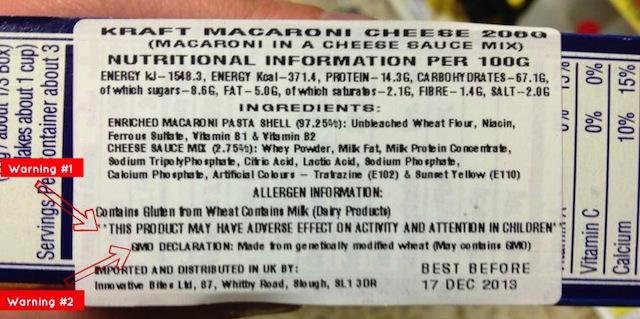 =”Warning #1: This Product May Cause Adverse Effects On Activity And Attention In Children (This warning label is required because The US version of Kraft Mac & Cheese has artificial food dyes yellow #5 and yellow #6 which are proven to be linked to hyperactivity in children.) Warning #2: GMO Declaration: Made from genetically modified wheat. (May contain GMO) (This warning label is required because the US version of Kraft Mac & Cheese contains GMOs.)
Warning #1: This Product May Cause Adverse Effects On Activity And Attention In Children (This warning label is required because The US version of Kraft Mac & Cheese has artificial food dyes yellow #5 and yellow #6 which are proven to be linked to hyperactivity in children.) Warning #2: GMO Declaration: Made from genetically modified wheat. (May contain GMO) (This warning label is required because the US version of Kraft Mac & Cheese contains GMOs.)There was quite a bit of speculation about this label last week. Many people on the internet questioned if it was real and where it came from. According to the report in the NY Times, in video evidence I posted, and in two other videos here and here, we can now conclude the following:
Lynne Galia, the spokeswoman I met at Kraft headquarters when I delivered thousands of signatures, has still not responded to me directly. She will not answer my emails or my phone calls. She will gladly talk to the NY Times and other news agencies, but not to me or the other 290,000 people I represent who signed a petition asking Kraft to remove artificial food dyes. I find it bizarre that Kraft wouldn’t genuinely want to answer basic questions about their product – especially after I posted this concerning information that could have health implications to millions of people and children.
How can we continue to trust a company like Kraft that is more concerned about making greedy business decisions to keep their market share and paying their executives millions of more dollars year after year, while neglecting enormous public outcry regarding their flagship product?
How can we continue to trust a company that continues to not take responsibility for their product containing petroleum based dyes and GMOs?
How can we continue to trust an American company that reformulates their products without harmful ingredients to our friends overseas but not to us?
How can we continue to trust a company that ignores 290,000 people and is scared to have a basic civilized conversation? I want to leave you with a clarification note I received from Flo (who is definitely a hero for finding this label!) She would like to share her unedited thoughts about Kraft Mac & Cheese here:
If you haven’t already, please sign this petition, continue to vote with your dollars, and spread this knowledge about Kraft with your friends and family.
Thank you everyone for your support. We are winning this battle. Food Babe |
|

The Chemicals in Your Mac and CheeseBy Roni Caryn Rabin https://www.nytimes.com/2017/07/12/well/eat/the-chemicals-in-your-mac-and-cheese.html Potentially harmful chemicals that were banned from children’s teething rings and rubber duck toys a decade ago may still be present in high concentrations in your child’s favorite meal: macaroni and cheese mixes made with powdered cheese.
The chemicals, called phthalates, can disrupt male hormones like testosterone and have been linked to genital birth defects in infant boys and learning and behavior problems in older children. The chemicals migrate into food from packaging and equipment used in manufacturing and may pose special risks to pregnant women and young children.
The Food and Drug Administration has not banned their presence in foods, though a 2014 report to the Consumer Product Safety Commission urged federal agencies to assess risks “with a view to supporting risk management steps.” The report concluded that food, drugs and beverages, and not toys, were the primary source of exposure to phthalates.
Now a new study of 30 cheese products has detected phthalates in all but one of the samples tested, with the highest concentrations found in the highly processed cheese powder in boxed mac and cheese mixes. The report, which was conducted by an independent laboratory and paid for by environmental advocacy groups, has not been published in a peer-reviewed journal.
“The phthalate concentrations in powder from mac and cheese mixes were more than four times higher than in block cheese and other natural cheeses like shredded cheese, string cheese and cottage cheese,” said Mike Belliveau, executive director of the Environmental Health Strategy Center, one of four advocacy groups that funded the report. Others were the Ecology Center, Healthy Babies Bright Futures and Safer States.
The groups tested 10 different varieties of mac and cheese, including some that were labeled organic, and found high levels of phthalates in all of them.
The tested products were purchased in the United States and shipped in the original packaging to VITO, the Flemish Institute for Technological Research in Belgium, where fat extracted from each product sample was analyzed for 13 phthalates using validated test methods, Mr. Belliveau said.
Some two million boxes of mac and cheese, a relatively inexpensive food that can be whipped up in minutes, are sold every day in the United States, according to 2013 figures from Symphony/IRI Group. Mr. Belliveau said consumers would have a hard time avoiding the chemical.
“Our belief is that it’s in every mac ‘n’ cheese product — you can’t shop your way out of the problem,” said Mr. Belliveau, who is urging consumers to contact manufacturers and pressure them to investigate how phthalates are getting into their products and take steps to eliminate it. Nine of the cheese products tested were made by Kraft, which makes most of the macaroni and cheese products sold, though the group did not disclose the names of specific products tested. Officials with Kraft did not respond to requests for comment on the report and its findings.
Devon Hill, a lawyer in Washington who has experience with companies that make phthalates, said many phthalates have been phased out of food processing and packaging, and that those still in use result in very low exposures. The cheese tests looked for the presence of 13 different phthalates and detected all but two, with some food items containing up to six different phthalates in a single product.
Environmental and food safety groups petitioned the F.D.A. last year to remove all phthalates from food, food packaging and food processing and manufacturing equipment, though the petition has been delayed temporarily for technical reasons, said Tom Neltner, chemicals policy director for the Environmental Defense Fund, which is coordinating the petition process for 11 advocacy groups, including the Center for Science in the Public Interest, Natural Resources Defense Council, the Environmental Working Group and others.
“A chemical is not allowed in food unless there is a reasonable certainty it will cause no harm,” Mr. Neltner said, adding that because of all the evidence regarding the potential harms of phthalates, “We don’t think the F.D.A. can say there is a reasonable certainty of no harm.”
An F.D.A. spokeswoman said the agency regulates all substances in food contact materials that can be expected to migrate into food, including phthalates, and said there must be “sufficient scientific information to demonstrate that the use of a substance in food contact materials is safe under the intended conditions of use before it is authorized for those uses.” The spokeswoman said: “The F.D.A. continues to monitor literature and research on these compounds as it becomes available.”
Phthalates are not deliberately added to food. They are industrial chemicals used to soften plastics and are used as solvents, in adhesives and in ink on packaging.
The chemicals migrate into food from food processing equipment like plastic tubing, conveyor belts and gaskets and other plastic materials used in the manufacturing process, and can also seep in from printed labels or plastic materials in the packaging.
Since they bind with fats, they tend to build up in fatty foods, including not just cheese but baked goods, infant formula, meats, oils and fats, and fast food, studies show.
Europe has banned many phthalates from use in plastics that come into contact with fatty foods, including baby food, but the F.D.A. allows the use of many phthalates in such materials and classifies them as indirect food additives.
Although the concentration of phthalates in food may be quite low, measured in parts per billion, they are still present at higher levels than the natural hormones in the body, said Heather B. Patisaul, a professor of biological sciences at the Center for Human Health and the Environment at North Carolina State University in Raleigh.
There is strong evidence that phthalates block the production of the hormone testosterone. “That means there is less testosterone available to the developing male fetus, and since testosterone is absolutely vital to build his reproductive organs, the worry is that you will get malformations and other kinds of problems that translate to health effects later,” Dr. Patisaul said. Those include “infertility, low sperm counts, altered male reproductive behavior and changes in the area of the brain that are important for sex differences between men and women,” as well as a heightened risk of testicular cancer later on, she said.
“If you asked most scientists about the top 10 or 20 endocrine-disrupting chemicals they worry about, phthalates would be on that list,” Dr. Patisaul said. “We have an enormous amount of data.”
Emerging research has also suggested links between early childhood exposure to phthalates and neurodevelopmental and behavior problems in young children, including aggression, hyperactivity and possible cognitive delays, said Dr. Sheela Sathyanarayana, associate professor of pediatrics at the University of Washington in Seattle, who studies phthalates.
If you’re pregnant or planning a pregnancy, have young children or want to reduce your family’s exposure to phthalates for other reasons, here are some suggestions:
■ Eat more whole fresh and frozen fruits and vegetables, and minimize the amount of processed food you eat. “Avoid anything you find in a box that could sit around for many years,” said Dr. Sathyanarayana. “There are so many steps to get to that boxed product, and every step along the way, there’s usually plastic involved.”
■ Choose low-fat dairy products such as skim milk and low fat cheeses, and avoid high-fat foods such as cream, whole milk and fatty meats. “We know these more toxic phthalates accumulate in fat,” Dr. Sathyanarayana said.
■ Use glass, stainless steel, ceramic or wood to hold and store food instead of plastics, Dr. Sathyanarayana suggested, and if you are using sippy cups and baby bottles made from hard polycarbonate plastics, don’t put hot liquids in them.
■ Wash your hands frequently, and take your shoes off at home to avoid household dust that may be contaminated with chemical traces. Vacuum and wet dust frequently.
■ Food isn’t the only source of exposure. Many fragrances contain phthalates, Dr. Patisaul said, so choose unscented personal care products, from cleansers, moisturizers and cosmetics to shampoo and detergents as well.
■ If you’d like to try making your own macaroni and cheese, here are a few recipe options from the Cooking section of The New York Times: Creamy Macaroni and Cheese; Crusty Macaroni and Cheese; The Best Macaroni and Cheese. |
|
With all the scandal in the press about Kraft Macaroni and Cheese Having GMO (genetically modified wheat etc.) I pulled out one of my favorites. If you want REAL Food with the same amount of time and half the price try: Easy Stove Top Macaroni and CheeseTotal Time:30 mins Prep Time:15 mins Cook Time:15 mins Ingredients:Servings: 4 8 ounces elbow macaroni Directions: 1) Cook macaroni according to package directions. |
|

Soy-based lunch kills 22 children in India: Have GMOs and pesticides become instant killers?Saturday, July 20, 2013 by: Ethan A. Huff, staff writer https://www.naturalnews.com/041282_school_lunch_deadly_poisons_dead_children.html (NaturalNews) At least 22 children in India have died as a result of eating soy-based school lunches served to them in the country’s Bihar state, according to new reports. The tainted lunches, which were loaded with genetically-modified (GM) soybeans and pesticide chemical residues, were given to the student victims as part of a U.K.-based government meal program similar to the one currently being implemented in the U.S. by Michelle Obama for American public schoolchildren.
The U.K.’s Independent reports that the culprit meals contained a blend of rice, soybeans and potatoes, and had apparently been doused with an unidentified new cooking oil that was later determined to be tainted with toxic crop insecticides. Early on, the school’s cook warned her superiors that the new oil appeared “discolored and dodgy,” but her concerns were ignored when school officials insisted that the oil was safe.
Not long after students ate the first meal served with the new oil, dozens of them began to vomit profusely and some developed severe diarrhea. Several of them had to be immediately rushed to the hospital for emergency care, which sent the school’s headmaster running for the hills — according to reports, she literally fled the school after first learning that students were becoming ill from eating the food.
“We feel that some kind of insecticide was either accidentally or intentionally mixed in the food, but that will be clear through investigations,” said R.K. Singh, the medical superintendent at the local children’s hospital in Patna, Bihar’s capital. “We prepared antidotes and treated the children for organic phosphorus poisoning,” he added, noting that early tests identified the presence of a toxic organophosphate chemical in the tainted food.
But the school itself appears to have dropped the ball in helping its sick children in the immediate aftermath of the poisoning. Reports indicate that it took about 15 hours after the first child fell ill to evacuate the rest. It was only after 17 children died that school officials began to take the situation seriously by trying to actually help the children.
After learning about the school’s mismanagement of the situation, many parents began rioting in the streets and demanding answers. Protesting villagers reportedly set ablaze four police vehicles out of anger, and police reinforcements had to be sent in from elsewhere to quell the unrest. In the aftermath of the disaster, Bihar has offered to provide compensation of 200,000 rupees, or about $3,500, per dead child to affected families. All government food programs, including those in US, a threat to childrenThough this incident took place in one of India’s poorest regions, where corruption is rampant, the moral of the story is that this type of situation could happen anywhere. In the U.S., for instance, where the federal government is currently seizing control of school lunch programs nationwide, children are being fed some of the very same soy- and chemical-laden garbage for lunch.
Just last year, prisoners in Illinois actually filed a lawsuit against the state for serving them too much soy, which was causing them to become seriously ill. And a district court judge has since acknowledged the merits of the case, recognizing that high amount of soy, and particularly GM soy, can lead to severe gastrointestinal problems, hypothyroidism, infections, and even death.
“In the U.S., we allow Big Agra to provide insecticide laced GMOs for our children everyday,” wrote one concerned and insightful commenter on a piece published by The New York Times (NYT). “We have no idea how much damage this stuff is doing to our children or the rest of the humans who are being slowly poisoned for the benefit of high profits and obscenely paid CEOS.”
“At least the Indian government intends to prosecute the ones who did this. We (in the U.S.) put them at the head of the FDA and give them complete immunity through specially drafted legislation. This is our shame and our tragedy.”
Sources for this article include: http://india.blogs.nytimes.com https://www.naturalnews.com/034800_prisoners_lawsuit_soy.html |
|

Scientists discover what’s killing the bees and it’s worse than you thoughtBy Todd Woody July 25, 2013 https://qz.com/107970/scientists-discover-whats-killing-the-bees-and-its-worse-than-you-thought/ Outlawing a type of insecticides is not a panacea. © AP Photo/Ben Margot As we’ve written before, the mysterious mass die-off of honey bees that pollinate $30 billion worth of crops in the US has so decimated America’s apis mellifera population that one bad winter could leave fields fallow. Now, a new study has pinpointed some of the probable causes of bee deaths and the rather scary results show that averting beemageddon will be much more difficult than previously thought.
Scientists had struggled to find the trigger for so-called Colony Collapse Disorder (CCD) that has wiped out an estimated 10 million beehives, worth $2 billion, over the past six years. Suspects have included pesticides, disease-bearing parasites and poor nutrition. But in a first-of-its-kind study published today in the journal PLOS ONE, scientists at the University of Maryland and the US Department of Agriculture have identified a witch’s brew of pesticides and fungicides contaminating pollen that bees collect to feed their hives. The findings break new ground on why large numbers of bees are dying though they do not identify the specific cause of CCD, where an entire beehive dies at once.
When researchers collected pollen from hives on the east coast pollinating cranberry, watermelon and other crops and fed it to healthy bees, those bees showed a significant decline in their ability to resist infection by a parasite called Nosema ceranae. The parasite has been implicated in Colony Collapse Disorder though scientists took pains to point out that their findings do not directly link the pesticides to CCD. The pollen was contaminated on average with nine different pesticides and fungicides though scientists discovered 21 agricultural chemicals in one sample. Scientists identified eight ag chemicals associated with increased risk of infection by the parasite.
Most disturbing, bees that ate pollen contaminated with fungicides were three times as likely to be infected by the parasite. Widely used, fungicides had been thought to be harmless for bees as they’re designed to kill fungus, not insects, on crops like apples.
“There’s growing evidence that fungicides may be affecting the bees on their own and I think what it highlights is a need to reassess how we label these agricultural chemicals,” Dennis vanEngelsdorp, the study’s lead author, told Quartz.
Labels on pesticides warn farmers not to spray when pollinating bees are in the vicinity but such precautions have not applied to fungicides.
Bee populations are so low in the US that it now takes 60% of the country’s surviving colonies just to pollinate one California crop, almonds. And that’s not just a west coast problem—California supplies 80% of the world’s almonds, a market worth $4 billion.
In recent years, a class of chemicals called neonicotinoids has been linked to bee deaths and in April regulators banned the use of the pesticide for two years in Europe where bee populations have also plummeted. But vanEngelsdorp, an assistant research scientist at the University of Maryland, says the new study shows that the interaction of multiple pesticides is affecting bee health.
“The pesticide issue in itself is much more complex than we have led to be believe,” he says. “It’s a lot more complicated than just one product, which means of course the solution does not lie in just banning one class of product.”
The study found another complication in efforts to save the bees: US honey bees, which are descendants of European bees, do not bring home pollen from native North American crops but collect bee chow from nearby weeds and wildflowers. That pollen, however, was also contaminated with pesticides even though those plants were not the target of spraying.
“It’s not clear whether the pesticides are drifting over to those plants but we need take a new look at agricultural spraying practices,” says vanEngelsdorp. |
|

Risk Expert: GMOs Could Destroy the Planetby George Washington on 03/26/2014 15:52 -0400 https://www.zerohedge.com/contributed/2014-03-26/risk-expert-gmos-could-destroy-global-ecosystem
Risk analyst Nassim Nicholas Taleb predicted the 2008 financial crisis, by pointing out that commonly-used risk models were wrong. Distinguished professor of risk engineering at New York University, author of best-sellers The Black Swan and Fooled by Randomness, Taleb became financially independent after the crash of 1987, and wealthy during the 2008 financial crisis.
Now, Taleb is using his statistical risk acumen to take on genetically modified organisms (GMOs).
Taleb’s conclusion: GMOs could cause “an irreversible termination of life at some scale, which could be the planet.”
Sound crazy?
Sure it does … but only because we don’t understand statistics, and so we have no handle on what’s risky and what’s not.
Taleb and his 2 co-authors write in a new draft paper:
Taleb shreds GMO-boosters – including biologists – who don’t understand basic statistics:
In other words, lack of knowledge of basic statistical principles leads GMO supporters astray. For example, they don’t understand the concept that “interdependence” creates “thick tails” … leading to a “black swan” catastrophic risk event:
(This concept is important in the financial world, as well.) As Forbes’ Brian Stoffel notes:

1. The Risk of Famine If We Don’t Use GMOs. Taleb says:
In addition, the United Nations actually says that small organic farms are the only way to feed the world. And growing your own food helps prevent tyranny.
2. Nothing Is Totally Safe, So Should We Discard All Technology? Taleb says this is an anti-scientific argument. Some risks are small, or are only risks to one individual or a small group of people. When you’re talking about risks which could wipe out all life on Earth, it’s a totally different analysis.
3. Assuming that Nature Is Always Good Is Anti-Scientific. Taleb says that statistical risk analysis don’t use assumptions such as nature is “good” or “bad”. Rather, it looks at the statistical evidence that things persist in nature for thousands of years if they are robust and anti-fragile. Ecosystems break down if they become unstable.
GMO engineers may be smart in their field, but they are ignorant when it comes to long-run ecological reality:
4. People Brought Potatoes from the Americas Back to Europe, Without Problem. Taleb says that potatoes evolved and competed over thousands of years in the Americas, and so proved that they did not disrupt ecosystems. On the other hand, GMOs are brand spanking new … created in the blink of the eye in a lab. GMOs Also INCREASE Pesticide Use, DECREASE Crop Yield, And May Be VERY Dangerous to Your HealthAs if the risk of “ecocide”isn’t enough, there are many other reasons to oppose GMO foods – at least without rigorous testing – including:
On the plus side? A few companies will make a lot of money. |
|

It’s Official – Russia Completely Bans GMOsApril 15, 2014 By Arjun Walia. https://www.collective-evolution.com/2014/04/15/its-official-russia-completely-bans-gmos/ Prime Minister Dmitry Medvedev recently announced that Russia will no longer import GMO products, stating that the nation has enough space, and enough resources to produce organic food.
Russia has been considering joining the long list (and continually growing) of anti-GMO countries for quite some time now. It does so after a group of Russian scientists urged the government to consider at least a 10-year moratorium on GMOs to thoroughly study their influence on human health.
A number of scientists worldwide have clearly outlined the potential dangers associated with consuming GMOs. I recently published an article titled “10 Scientific Studies Proving GMOs Can Be Harmful To Human Health,” you can read that in full here. These are just a select few out of hundreds of studies that are now available in the public domain, it seems that they continue to surface year after year.
Russia completely banning GMOs, such a large, developed nation is a big step forward in creating more awareness with regards to GMOs. Ask yourself, why have so many nations banned GMOs and the pesticides that go with them? It’s because evidence points to the fact that they are not safe, they are young, and we just don’t know enough about them to safely consume them. They just aren’t necessary, so why produce them?
In February, the State Duma introduced a bill banning the cultivation of GMO food products. President Putin ordered that Russian citizens be protected from GMOs. The States Agricultural Committee has supported the ban recommendation from the Russian parliament, and the resolution will come into full effect in July 2014.
This just goes to show what we can do when we come together and demand change and share information on a global scale. Change is happening, and we are waking up to new concepts of our reality every day. GMOs are only the beginning, we have many things to rid our planet of that do not resonate with us and are clearly unnecessary. We are all starting to see through the false justifications for the necessity of GMOs, no longer are we so easily persuaded, no longer do we believe everything we hear and everything we’re presented with. Lets keep it going!
For more CE articles on GMOs, click here.
For more CE articles on glyphosate, click here. Sources: http://rt.com/news/russia-import-gmo-products-621/ http://rt.com/news/gmo-ban-russian-scientists-293/ http://www.gmo-free-regions.org/gmo-free-regions/russia/gmo-free-news-from-russia/news/en/28934.html |
|

China protects its massive Army from GMOsby Jon Rappoport June 4, 2014 https://blog.nomorefakenews.com/2014/06/05/china-protects-its-massive-army-from-gmos/ China protects its massive Army from GMOs by Jon Rappoport June 4, 2014 Worldwide sentiment is shifting against Monsanto and GMO food crops. And China is making major moves. At sustainablepulse.com, we have this May 14, 2014, article: “Chinese Army Bans All GMO Grains and Oil from Supply Stations”:
“The Chinese army has ordered all military supply stations to only allow the purchase of non-GMO grain and food oil due to health safety concerns over GMOs.
“This move by the Chinese army is being seen as yet another step towards the Chinese government’s expected ban on the import of all GMO grains and oilseeds within the next 2 years, due to growing public concern over GMOs. The expected ban would be a huge blow to the Biotech industry worldwide.
“The Hubei Province Xiangyang City Grain Bureau’s website announced on May 6, 2014:
“’During recent years, as China’s grain and oil market has continuously developed, certain GMO grain and GMO food oil products have entered the market. In view that the safety concerns about GMO grain and oil products in China at present has not yet been determined, in order to overall assure the health of military members residing in our city and safety of their drinks and food, in accordance to the request from the Guangzhou Military Command Joint Logistics Department and the Provincial Military Grain & Food Oil Supply Center, from this date all military supply stations are allowed to only purchase non-GMO grain and food oil products from the designated processing enterprises. It is forbidden to supply GMO grain and food oil products to military units within their administration areas.
“’Chen I-wan, an Advisor to the Committee of Disaster History to the China Disaster Prevention Association has stated: “The army has established [an] excellent model for people of the whole nation: No GMO staple food and GMO food oil should enter the army food supply.”
China—protecting its Army from GMOs. And soon, perhaps the entire population of the country.
Apparently, Chinese GMO science differs from American GMO science, where a mere nod and a wink between the FDA and Monsanto, 20 years ago, launched a big Ag revolution that continues to contaminate US lands.
China, by the way, is home to 20% of the world’s population. “GMO-free China” has an interesting ring. Which domino will fall next? India, where 17% of the Earth’s people live, where farmers who have been duped and bankrupted by Monsanto, have been committing suicide in large numbers?
Then there is Russia. Putin recently declared, in reference to a possible ban on GMOs: “We need to properly construct our work so that it is not contrary to our obligations under the WTO. But even with this in mind, we nevertheless have legitimate methods and instruments to protect our own market, and above all citizens.”
Likewise, groups in Africa are pushing back against the US/Monsanto/Bill Gates plan to flood the continent with GMO crops.
In all these cases, world leaders outside the US are seeing the GMO sell-job as an attempt to extend American hegemony, through what amounts to an act of war.
Well, what else would you call artificial gene-contamination and poisoning by herbicides? Jon Rappoport |
|

India: We Must Reclaim Our Freedom from Monsanto Like We Did From the BritishBy Dr. Vandana Shiva Later this month I will be travelling to England, to take part in the ‘One Earth One Humanity One Future’ festival in Oxford, which will celebrate 50 years of the UK’s flagship environmental magazine, Resurgence.
This ‘Resurgence 50’ festival will be bringing together leading figures from the world’s social justice and environmental movements to share ideas for bridging a more equitable and sustainable world. A world that would be imminently fairer and more sustainable without the transnational agrochemical giant Monsanto and its GMO crops.
Meantime, In India we are celebrating 70 years of our Independence, and last month we also celebrated the anniversary of the Quit India movement of 1942. That was also the year of the Great Bengal famine which killed 2 million Indians because of the extortionist revenue collection by the British. It was clear that we had to reclaim our freedom because British rule was pushing people to starvation while maximising its revenue extraction, Lagaan, from land.
Today we are suffering a similar tragedy related to seeds, as Monsanto extracts super profits from our farmers in the form of illegal royalties as ‘seed Lagaan’, trapping them in debt and pushing them to suicide.
Seed Sovereignty cannot coexist with Monsanto’s failed technologies and false claims. Monsanto’s withdrawal threat is empty. Indian law does not allow a patent on seed, and Roundup Ready crops are not approved for cultivation.
In fact, the Technical Expert Committee advising the Supreme Court in the GMO case has categorically advised that there should be no herbicide resistant GMO trials or commercialisation in India because India is a land of small farms and rich biodiversity. Herbicide resistant crops like Monsanto’s Roundup Ready cotton would lead to spraying of the broad spectrum herbicide, which would kill all other crops in the field except the plant genetically engineered to resist Roundup. Not only would this destroy biodiversity, it would rob the poor of rich sources of nutrition in the biodiversity, and aggravate India’s food and nutritional insecurity.
Instead of focusing on farming systems, biodiversity, seeds, farmer’s rights and national laws, Monsanto, through its massive PR machine keeps repeating three lies to cover up its failures and false and unreasonable PR claims.
First, it claims that the Government is trying to issue compulsory licences for Bt cotton seed. This is false because when there are no patents on seeds, there can be no compulsory licensing. The Government Licensing guidelines have merely clarified the law about exclusion of seeds and plants from patentability. Contrary to what was falsely claimed by Christi Dixon, a spokeswoman for Monsanto, who said in an e-mail that the application was withdrawn because of ‘regulatory uncertainties and ongoing discussions’, there is no regulatory uncertainty. It is just that our laws do not suit Monsanto’s seed monopoly aims.
Second, Monsanto and its spokespeople claim their GMO Bt seeds have increased yields and cotton production by controlling pests. This too is false.
Bt cotton is now resistant to bollworm which it was supposed to control. New pests like Whitefly have devastated the cotton crop in Punjab. Bt cotton area has dropped by 27 per cent from 10.3 lakh hectares in the 2015-16 crop year (July-June) to 7.56 lakh hectares in the 2016-17 crop year because of the failure of Bt cotton to control pests.
Maharashtra and Telangana also saw a reduction of cotton sowing from 87.83 lakh hectares to 67.88 lakh hectares.
The national cotton acreage has come down by 8 per cent from 128 lakh hectare to 118 lakh hectare between 2014-15 to 2015-16, as revealed by the latest Cotton Corporation of India statistics.
A third totally false claim is that the Roundup Ready trait would help overcome the bollworm resistance that has emerged in Bollard II. As Mayank Bhardwaj writes in Mint: ‘Bollgard II Roundup Ready Flex would have been the first technological breakthrough since the launch of Bollgard II, potentially pushing up crop yields at a time when some farmers have said the existing variety was losing its effectiveness. Bollgard II, introduced in 2006, is slowly becoming vulnerable to bollworms, experts say, and, as any technology, has a limited shelf life.’ It Is Time For Monsanto To Quit India: Vandana ShivaThese are scientifically fraudulent and misleading statements. If emergence of pest resistance is the problem, spraying Roundup won’t solve it. Herbicides are supposed to kill weeds, not pests. And Monsanto’s Roundup Ready crops are failing in controlling weeds also. Instead they have led to super weeds resistant to Roundup, just like bollworm has become a super pest resistant to Bt.
But the most outrageous phrase is that seeds have a ‘limited shelf life’. True seed is Bija – that which rises again and again and again. Our seeds have evolved for 10,000 years. Living seed does not have a ‘limited shelf’. Otherwise, we would have starved to death as a species centuries ago. Seeds are called heritage and heirloom seeds because they don’t have a limited shelf life like Monsanto’s GMO seeds. Living seed does not become obsolete. It renews. It has the potential to live and evolve forever through dynamic change, including contributions of farmers breeding. And as our three decades of work in Navdanya shows, living seeds have more nutrition, higher overall food output, more resilience to pests and diseases, and to climate change. Monsanto does not just force farmers to buy seed every year to collect royalties, it also owns the patent for the ‘terminator technology’ to create sterile seed. This technology has been stopped from commercialisation by the UN Convention on Biodiversity.
Seed freedom is our birthright. To defend our seed sovereignty and food sovereignty, we must compel Monsanto to Quit India, like we compelled the British 70 years ago
When the Government regulates seed prices, and clarifies India’s patent law that excludes seeds and plants from patentability Monsanto tries to threaten the government by saying it is withdrawing a new GMO Bt cotton seed Bollgard IIRoundup Ready Flex which contains 2 Bt toxin genes and a gene for resistance to Monsanto’s herbicide.
Roundup Ready crops are resistant to Roundup, so Monsanto can sell more Roundup as well as collect royalties from seeds it would like to patent. We cannot allow a corporation which has no understanding of biodiversity or what a seed is, but only knows how to extract royalties from farmers and create a monopoly control over our seed supply through its illegal, unscientific attempts at patent on seed.
Seed freedom is our birthright. To defend our seed sovereignty and food sovereignty, we must compel Monsanto to Quit India, like we compelled the British 70 years ago.
Vandana Shiva is a scholar, environmental activist and anti-globalization author. She will be talking at the One Earth One Humanity Future festival in Oxford in celebration of Resurgence magazine’s 50th anniversary on Thursday 22nd September and again on Friday 23rd September. For booking and further information, visit: resurgence.org/R50event
The original source of this article is New Internationalist Magazine Copyright © Dr. Vandana Shiva, New Internationalist Magazine, 2016 |
|

Federal court nixes FDA’s approval of genetically engineered “Frankenfish”Monday, November 23, 2020 by: Divina Ramirez https://www.naturalnews.com/2020-11-23-court-rejects-fda-approval-of-frankenfish.html (Natural News) In a major win for wild salmon, the Court for the Northern District of California ruled on Nov. 5 that the Food and Drug Administration (FDA) ignored potential environmental consequences in its approval of genetically engineered salmon produced by the Massachusetts-based AquaBounty Technologies.
District Judge Vince Chhabria also said that the FDA violated the National Environmental Policy Act (NEPA) and the Endangered Species Act (ESA) in approving the company’s application for AquAdvantage Salmon in 2015, the first time any government cleared a genetically engineered animal as food.
According to the court ruling, the FDA failed to consider the risk of the salmon escaping and surviving in the wild, where it could threaten wild salmon and other endangered fish species populations. Following the ruling, the FDA must now reconsider the environmental assessment for AquAdvantage Salmon. However, Chhabria did not withdraw the FDA’s approval of the new fish species.
Mike Conroy, the executive director of the Pacific Coast Federation of Fishermen’s Associations (PCFFA) and one of the plaintiffs in the case, said that the ruling is a clear win for both wild fish and fishermen, noting how the so-called “Frankenfish” could ruin irreplaceable salmon runs.
“Once engineered genes are introduced into the wild salmon gene pool, it cannot be undone,” he added.
It is unclear when the FDA will complete the environmental risk assessment. Frankenfish can still be soldUnfortunately, the ruling does not stop AquaBounty’s facilities in Canada and Indiana from operating despite the deficiencies in the FDA’s approval. This means that AquAdvantage salmon could still end up in restaurant menus and supermarket freezers.
Moreover, the ruling has neither stalled nor dampened AquaBounty’s efforts in commercially producing their Frankenfish. In August, for instance, the company announced plans to build a new 10,000-metric ton facility in Kentucky for its salmon. This is about 10 times larger than AquaBounty’s current facility in its Indiana fish farm.
The company also plans to begin commercial production of its genetically engineered salmon in 2023. That being said, the recent ruling might stall those plans and keep supermarkets and restaurant menus free from frankenfish for another couple of years. Genetically modified animals could threaten biodiversityAquaBounty’s genetically engineered salmon was created using DNA from the endangered Atlantic salmon, Chinook salmon – the largest species of Pacific salmon – and ocean pout, which can be found in the northwestern Atlantic Ocean.
The modifications would allow the salmon to grow almost twice as fast as wild salmon. This means that the company can produce more salmon at a reduced time frame and at a cheaper cost compared to the commercial production of non-engineered salmon.
But fast-growing salmon comes at a steep price. The transfer of genetic material from one species to another often raises serious health issues for wild animals and the humans who will eat them. For instance, there is a risk that new diseases from the bioengineered animals could be spread to non-engineered ones and humans.
Moreover, if bioengineered animals were to escape or be introduced on purpose to the environment, they can affect biodiversity. For instance, existing wild species can be overrun by the new species. Genetic engineering also puts animals at risk of harm. There have been instances where the engineered animals developed serious conditions, including arthritis and blindness. In some cases, the engineered animals were born infertile.
As it stands, scientists still understand very little about genetically engineered animals and the risks they could pose to both environmental and human health. (Related: National Intelligence Council Report warns that genetic engineering poses unprecedented threat to the world.)
“[Live] animals like genetically engineered salmon should undergo thorough and precautionary assessment for impacts to our health and environment, be properly regulated and clearly labeled before entering the market,” said Dana Perls, food and technology program manager at Friends of the Earth US.
Read more articles about the consequences of genetically modified animals for biodiversity at Environ.news. Sources include: |

